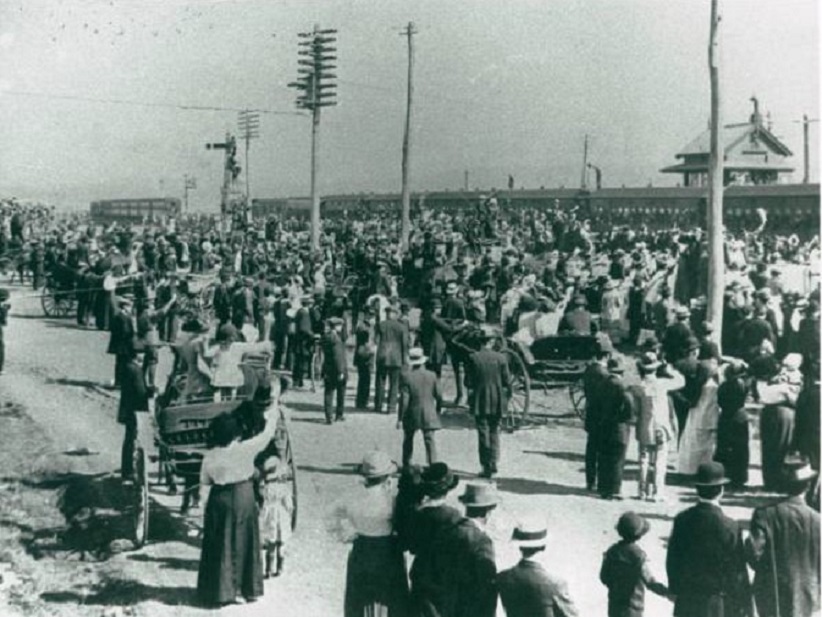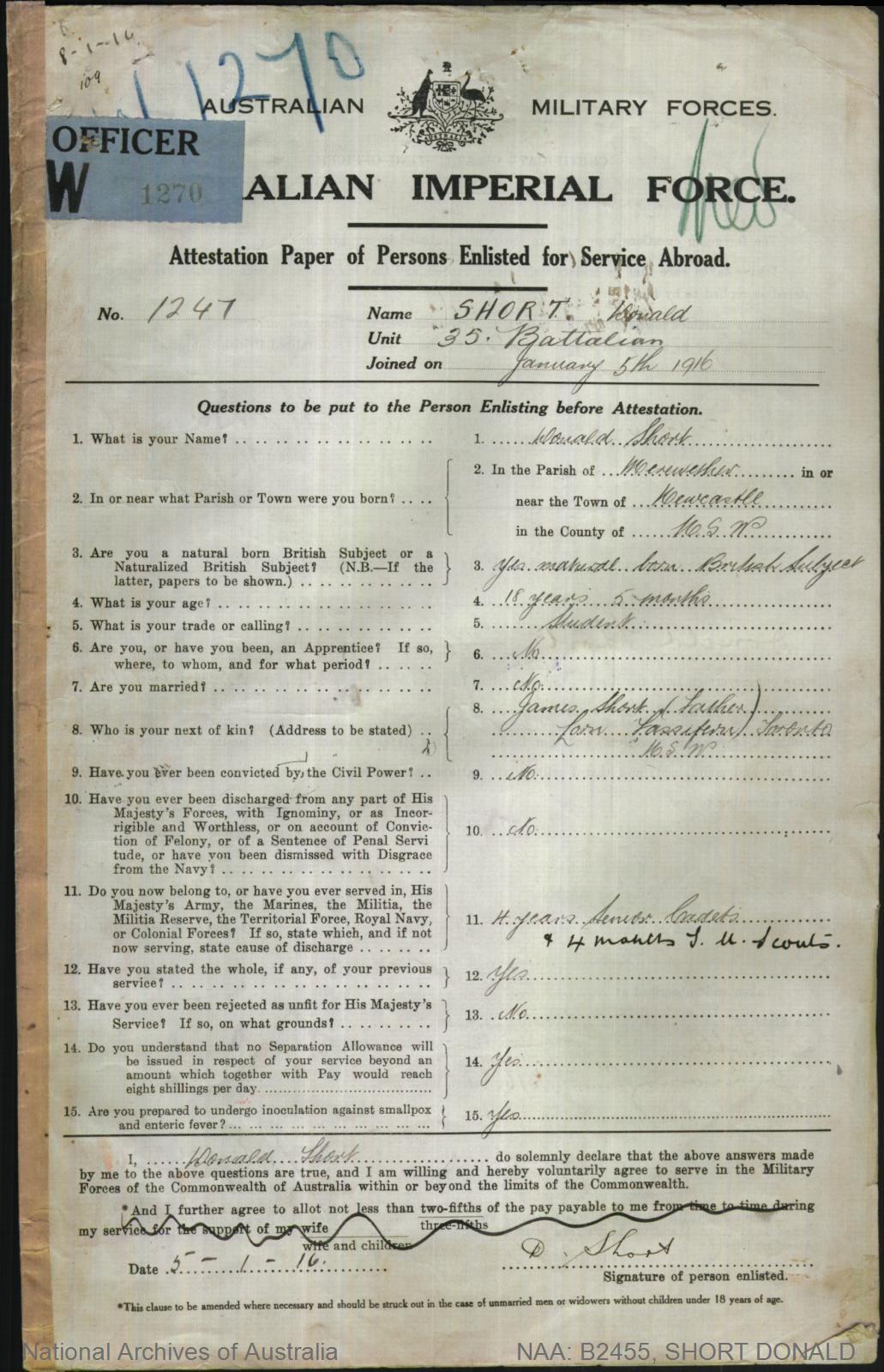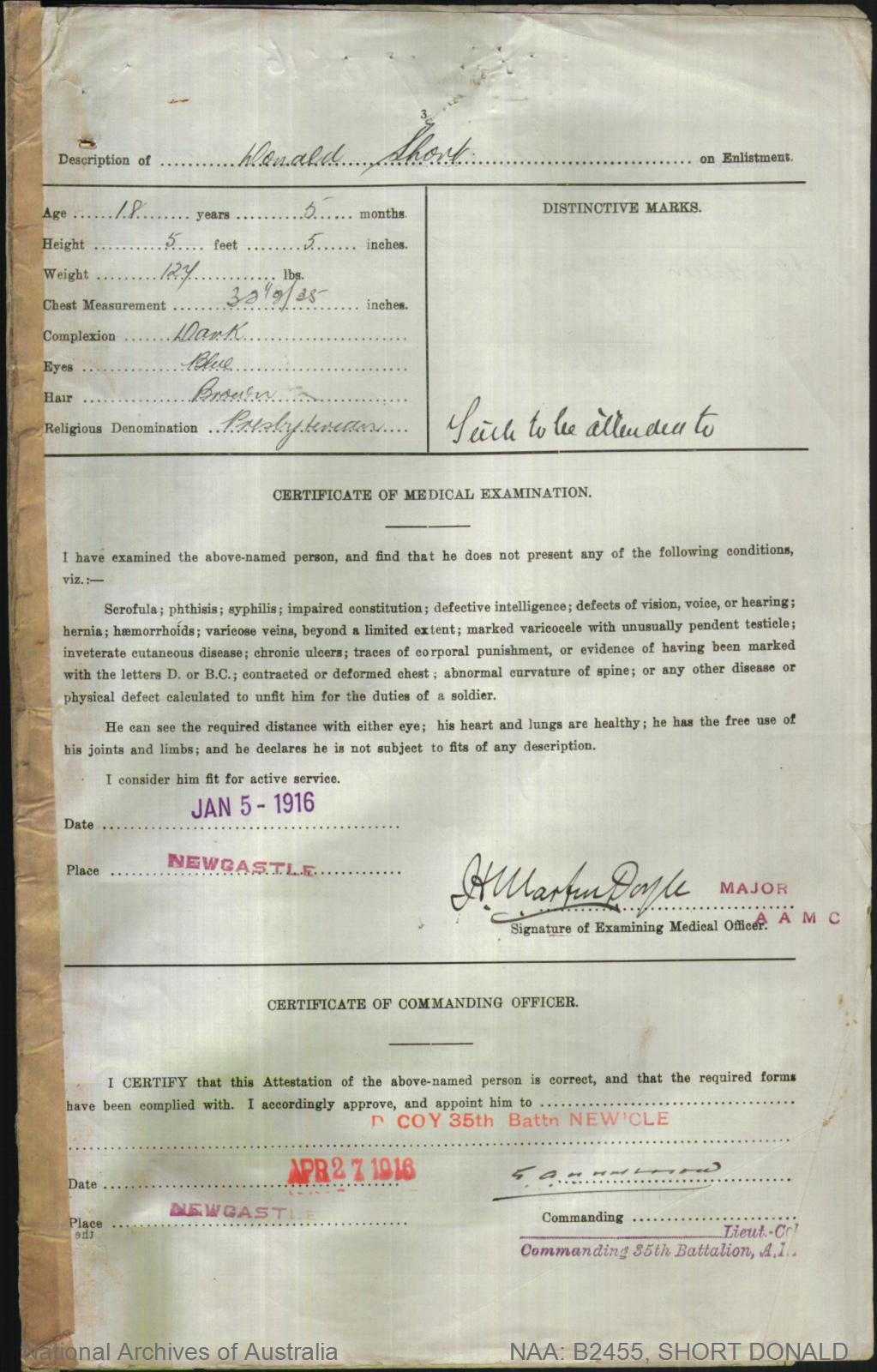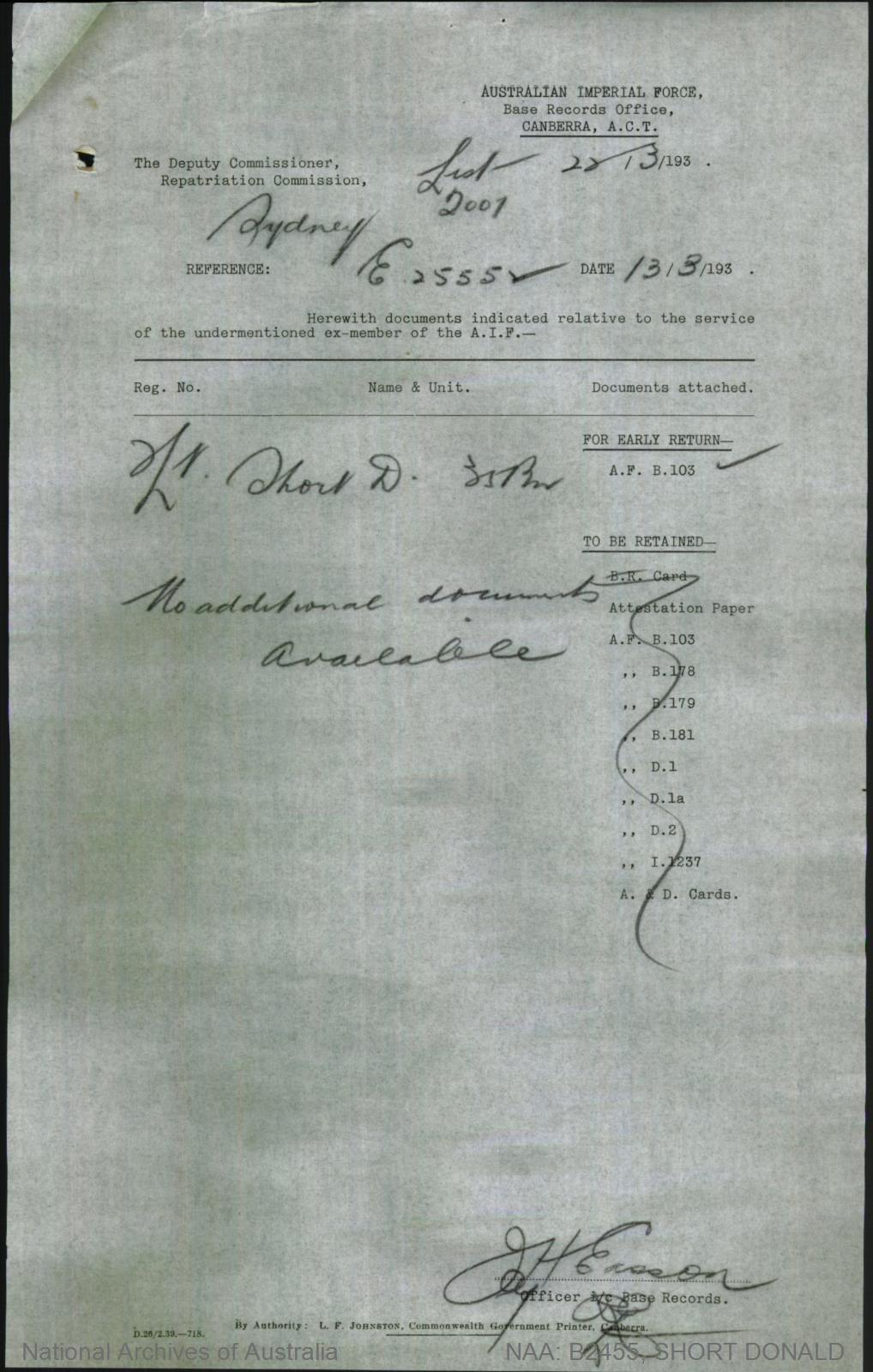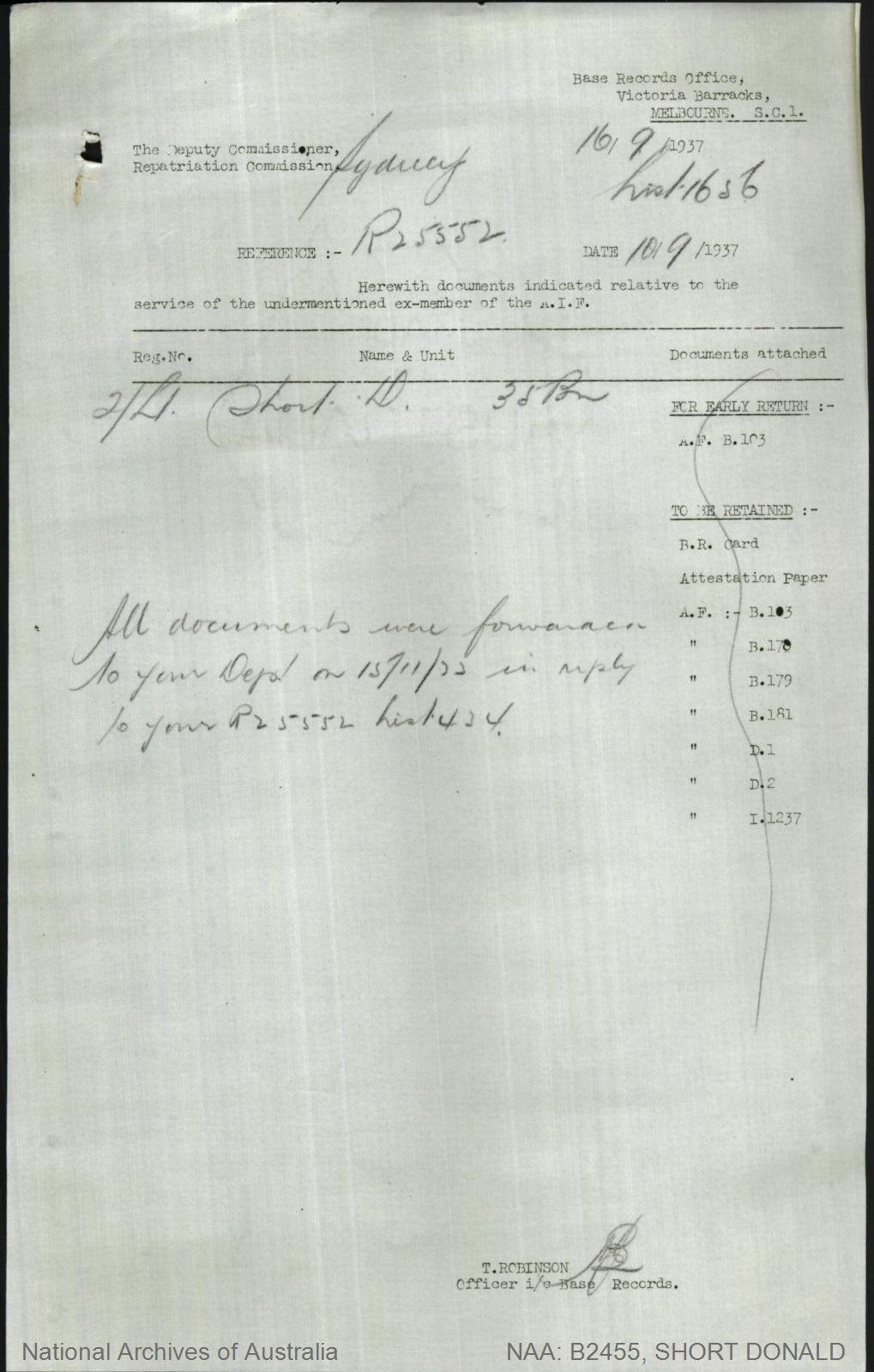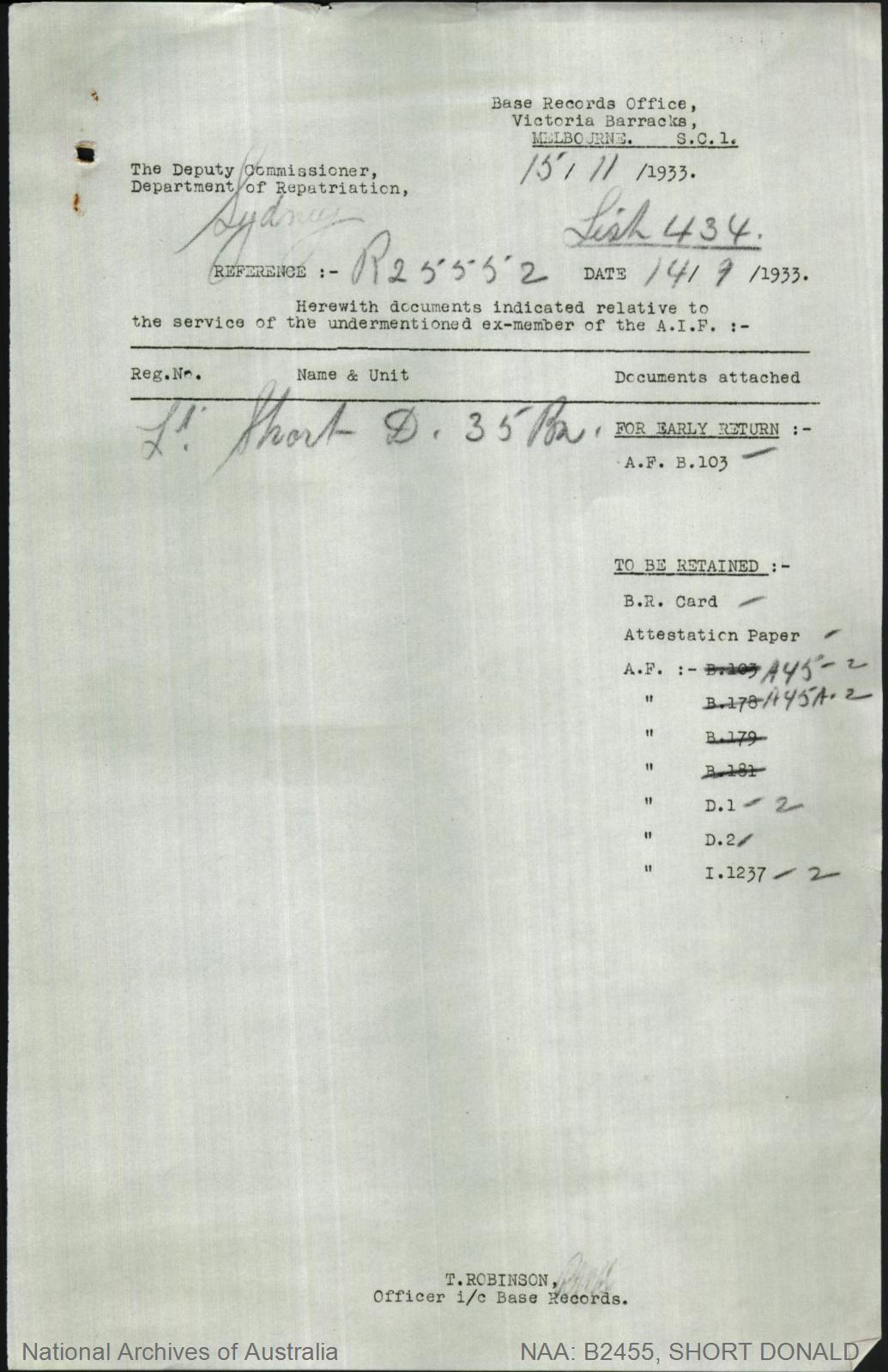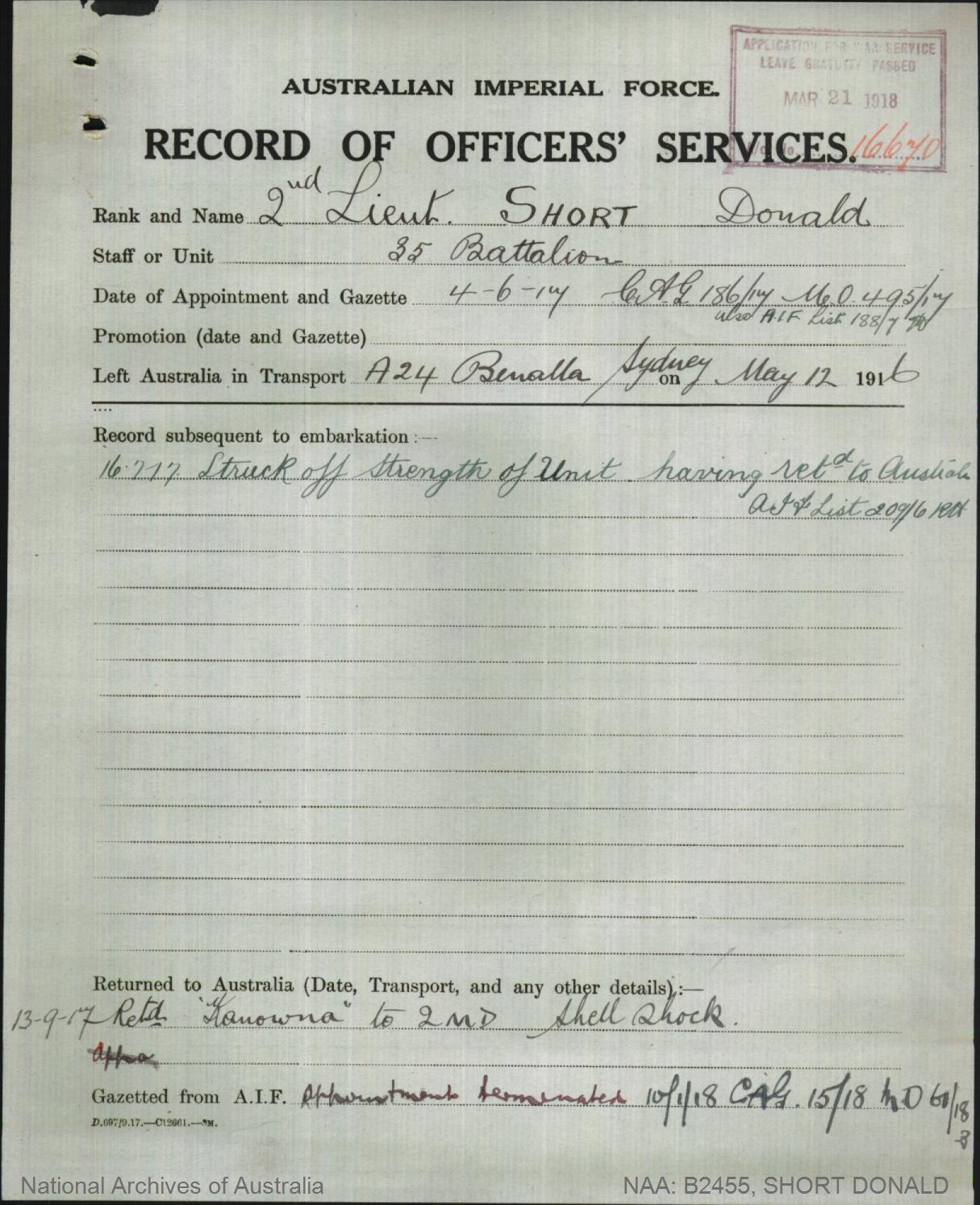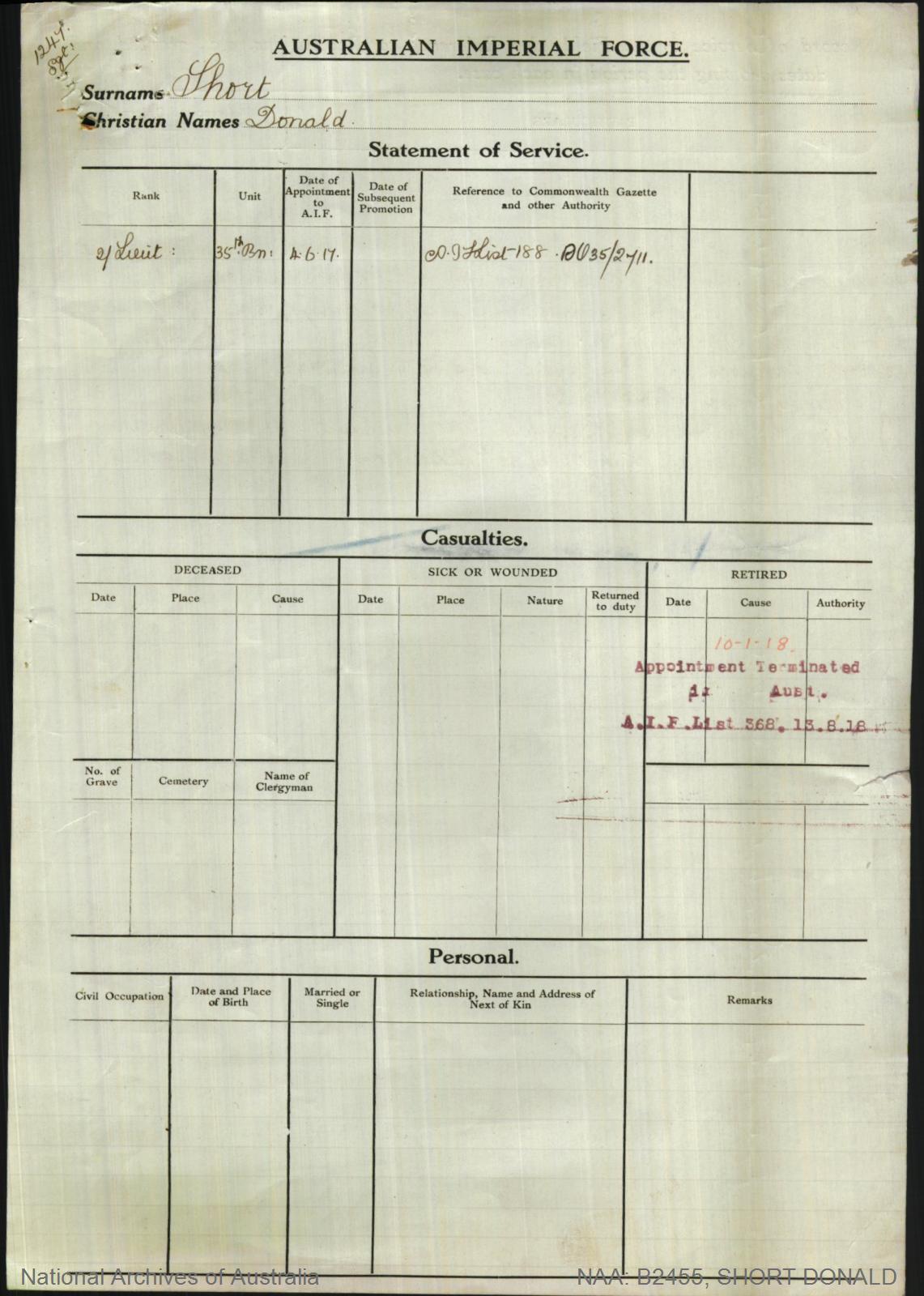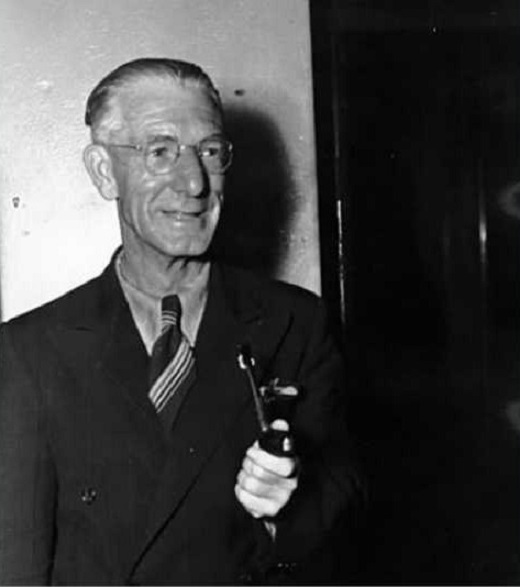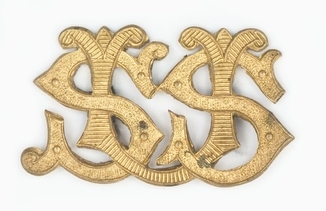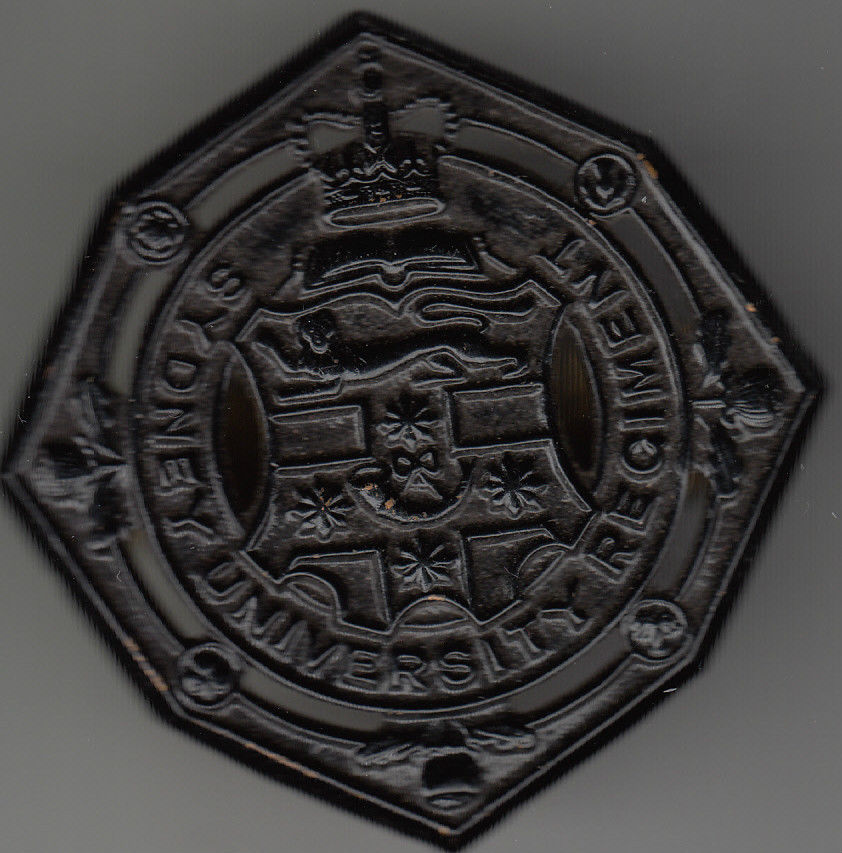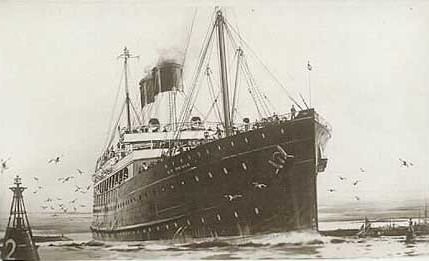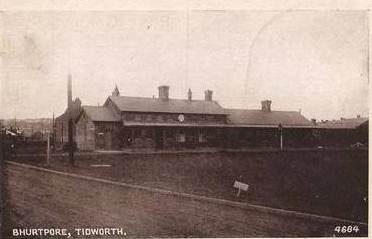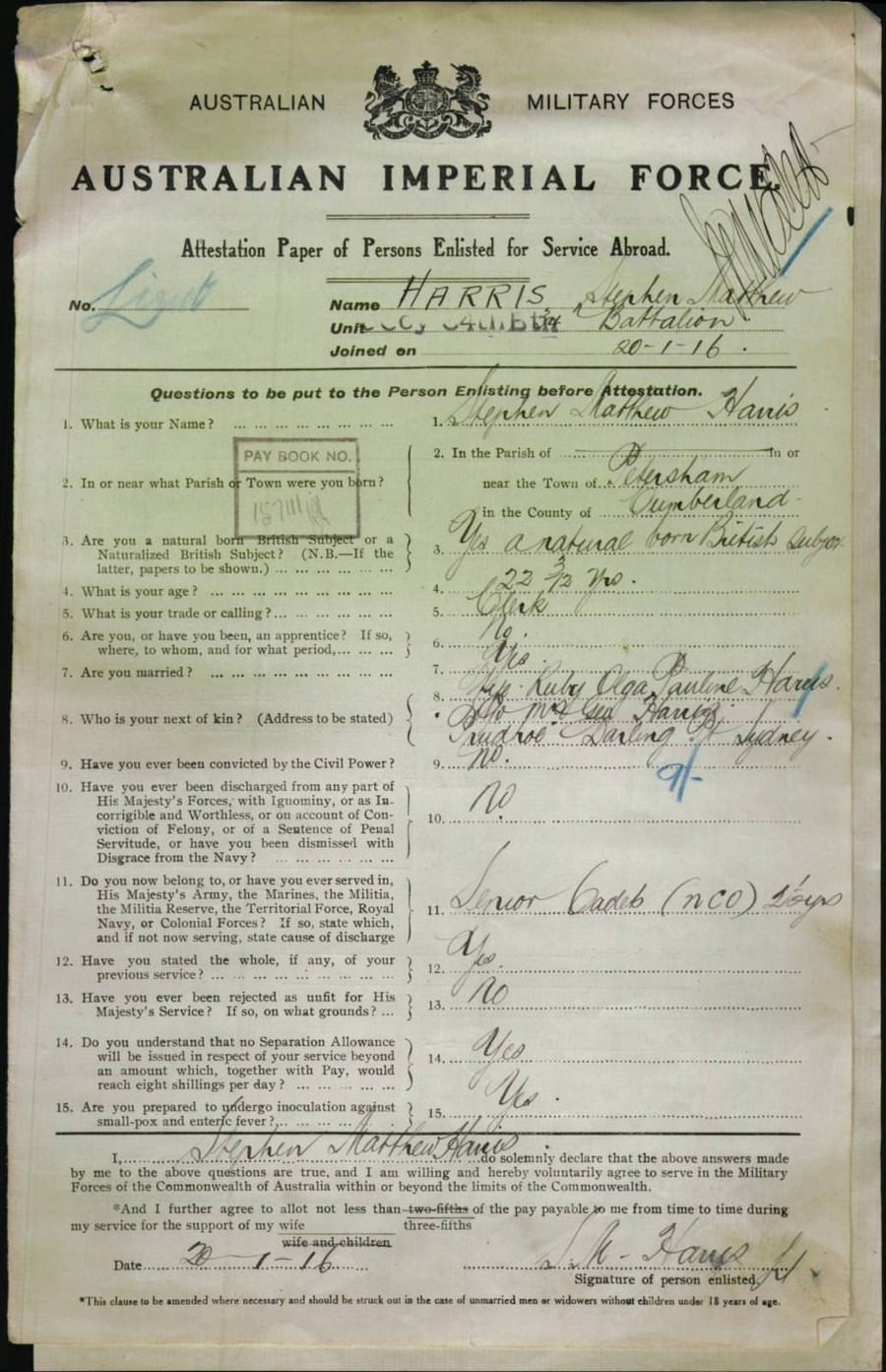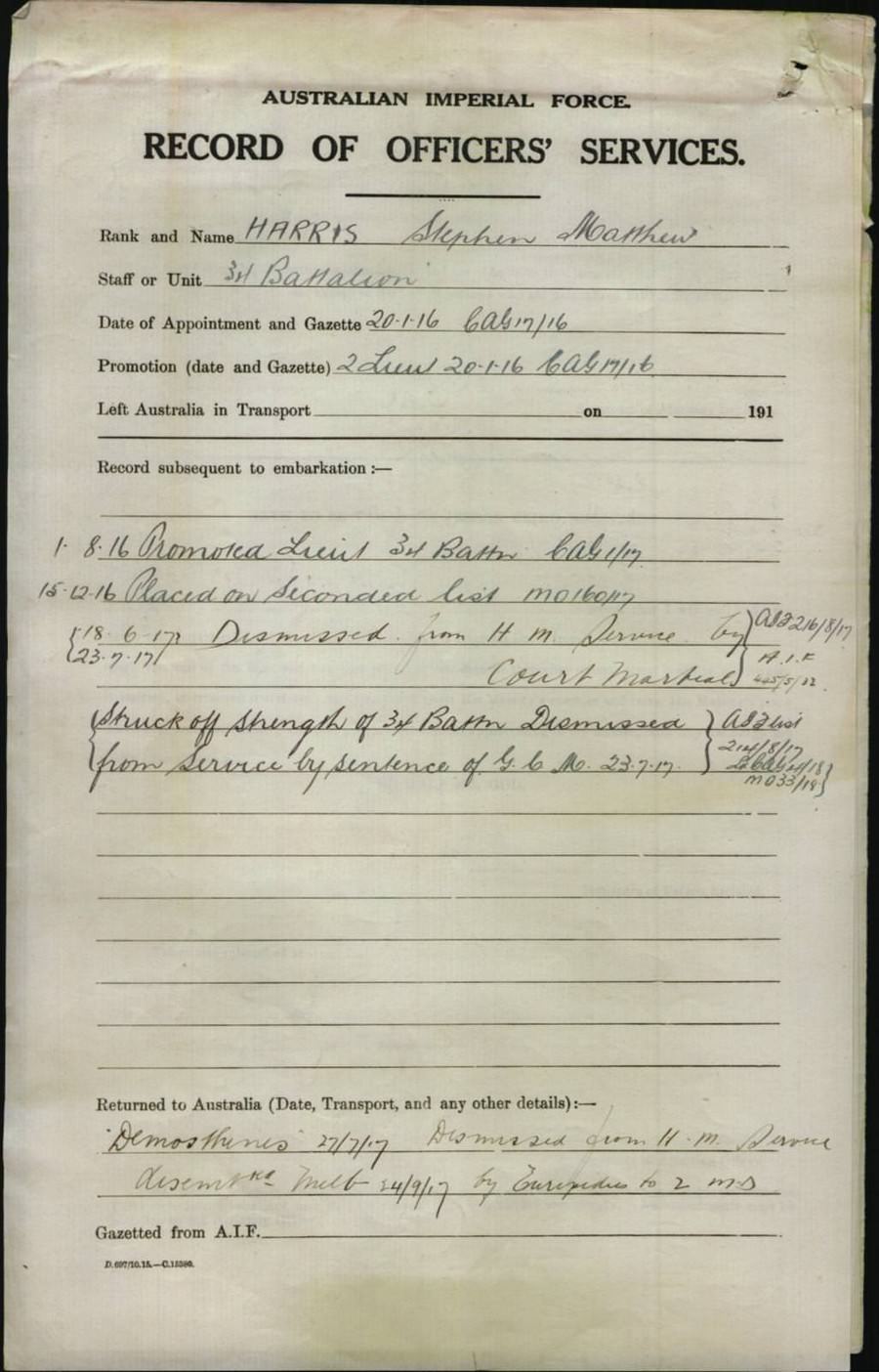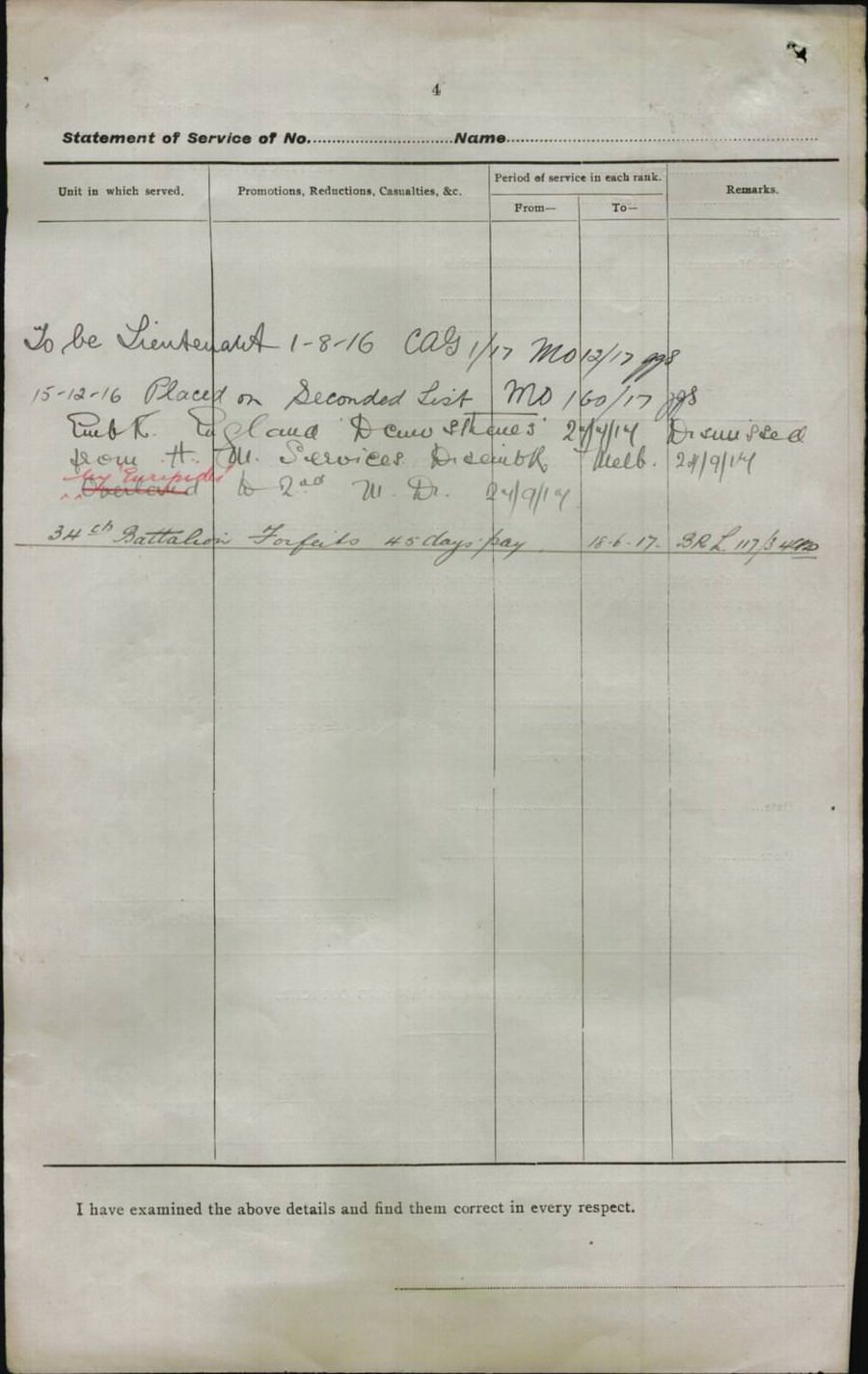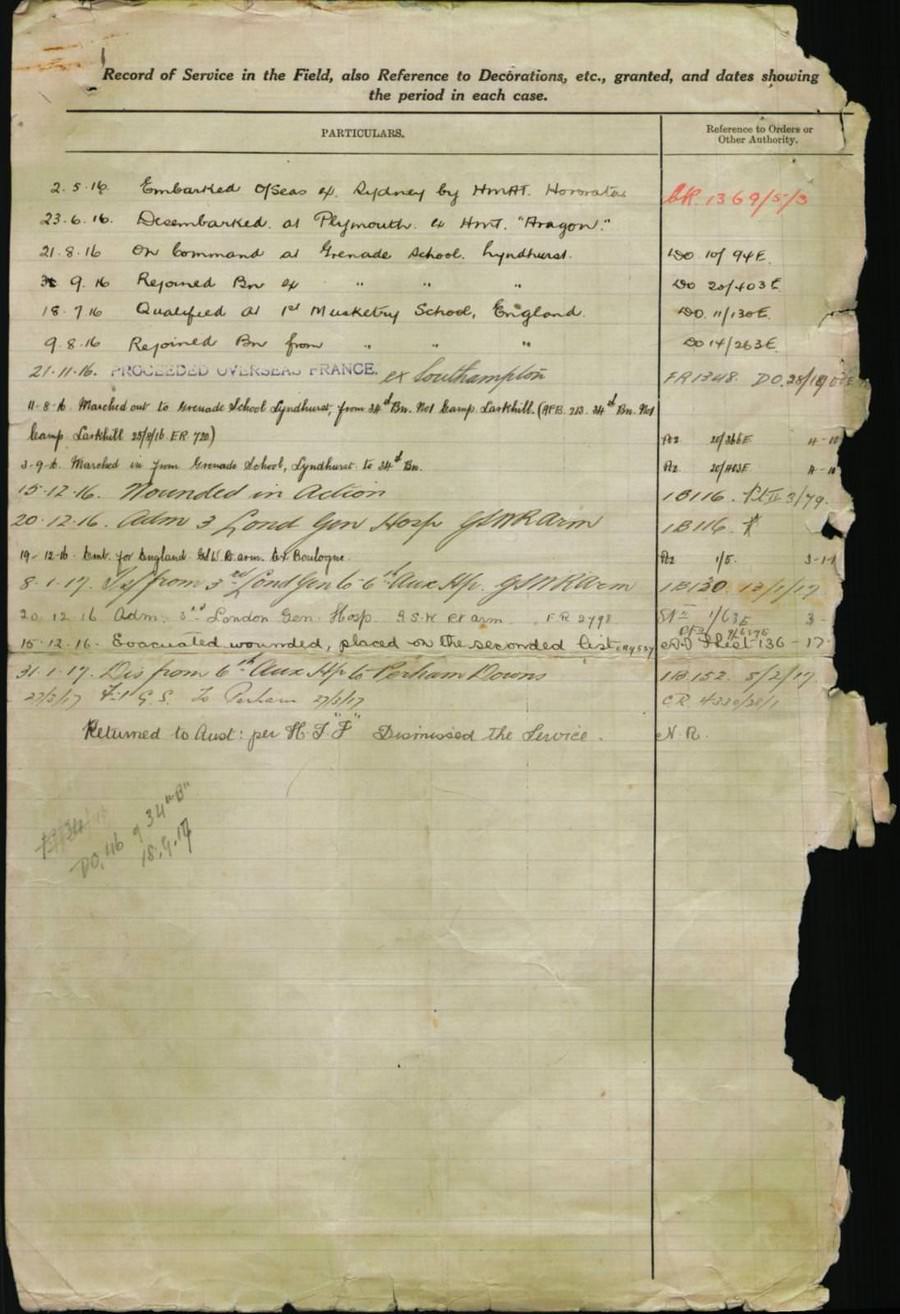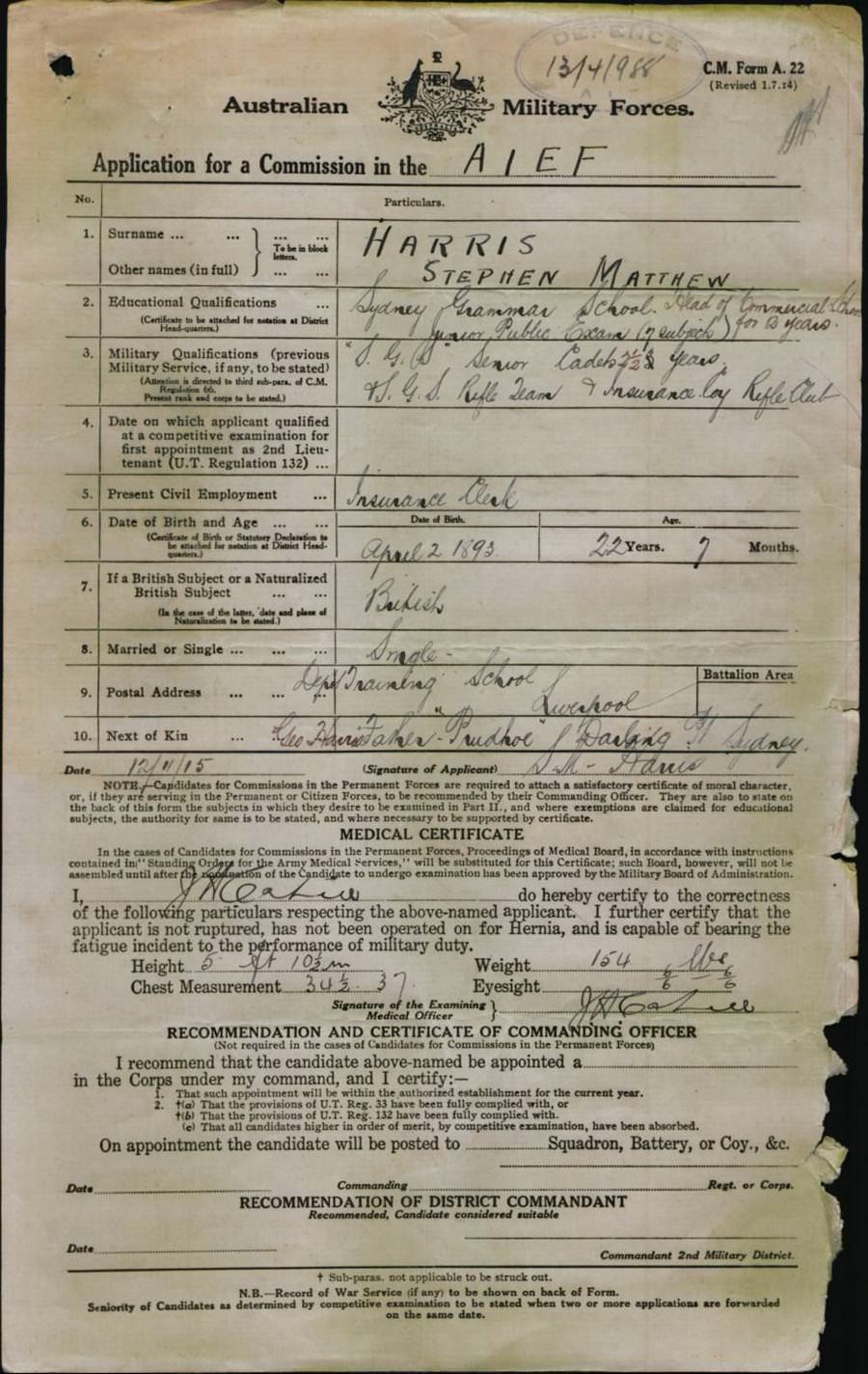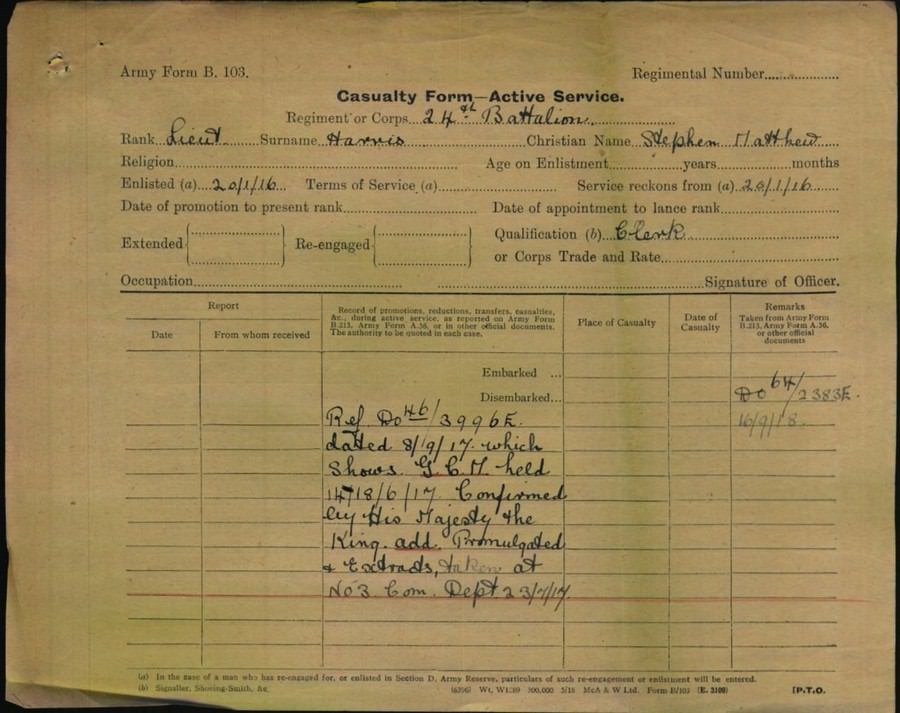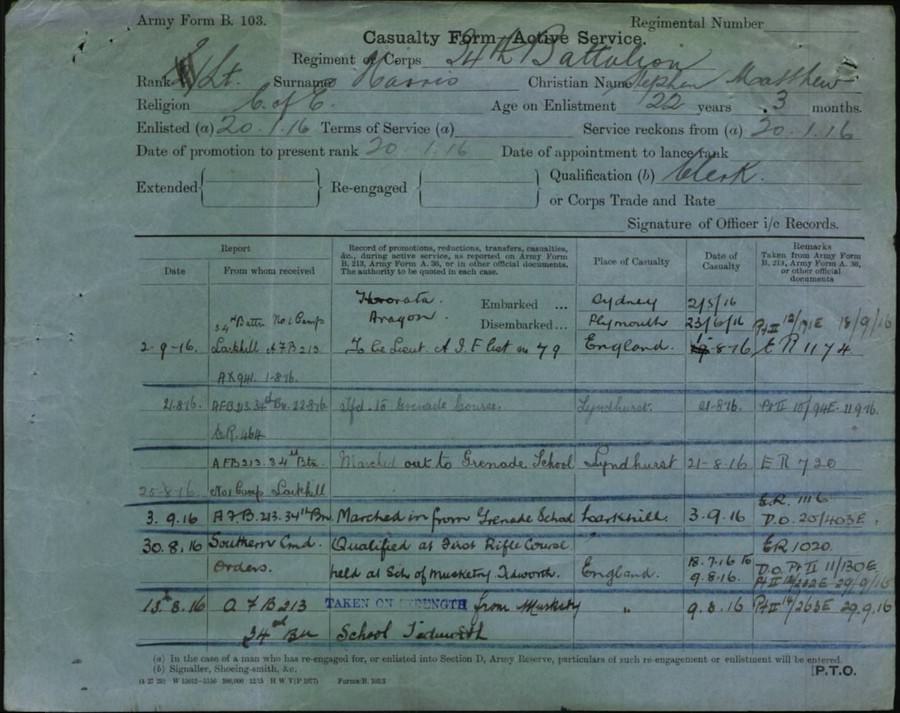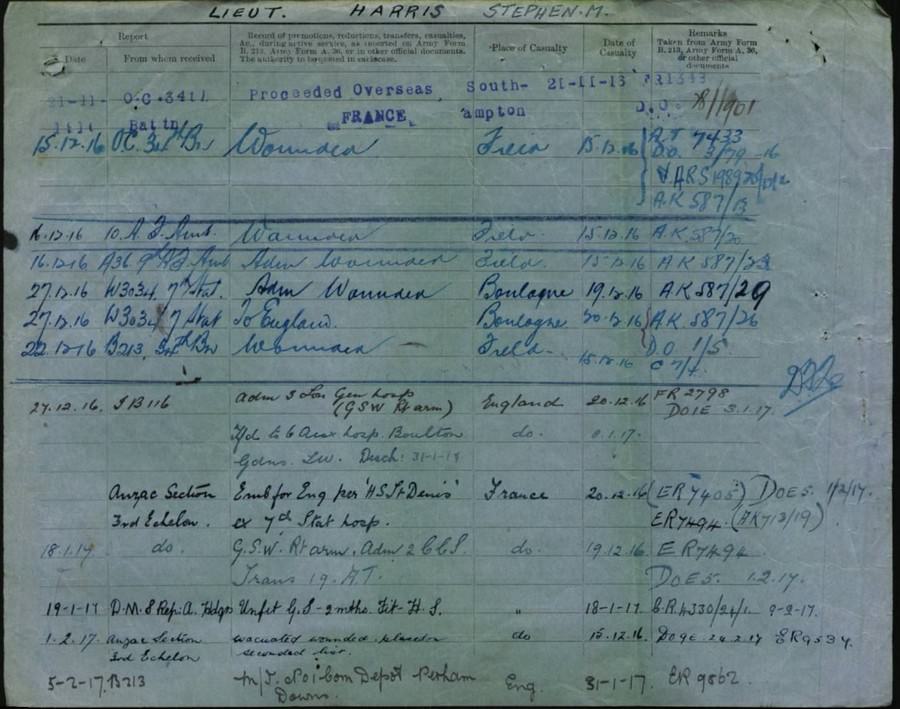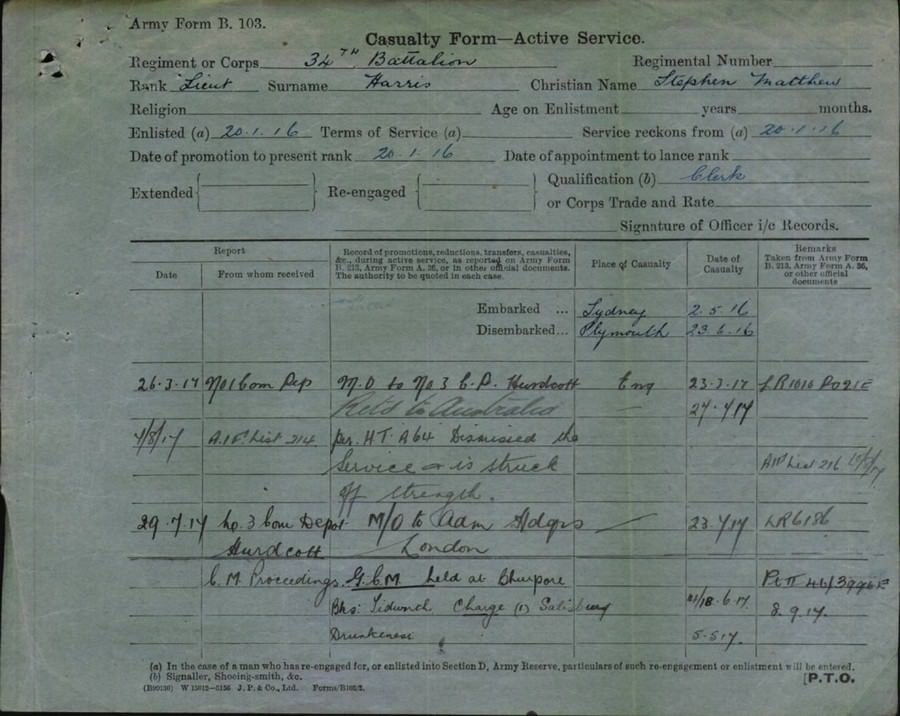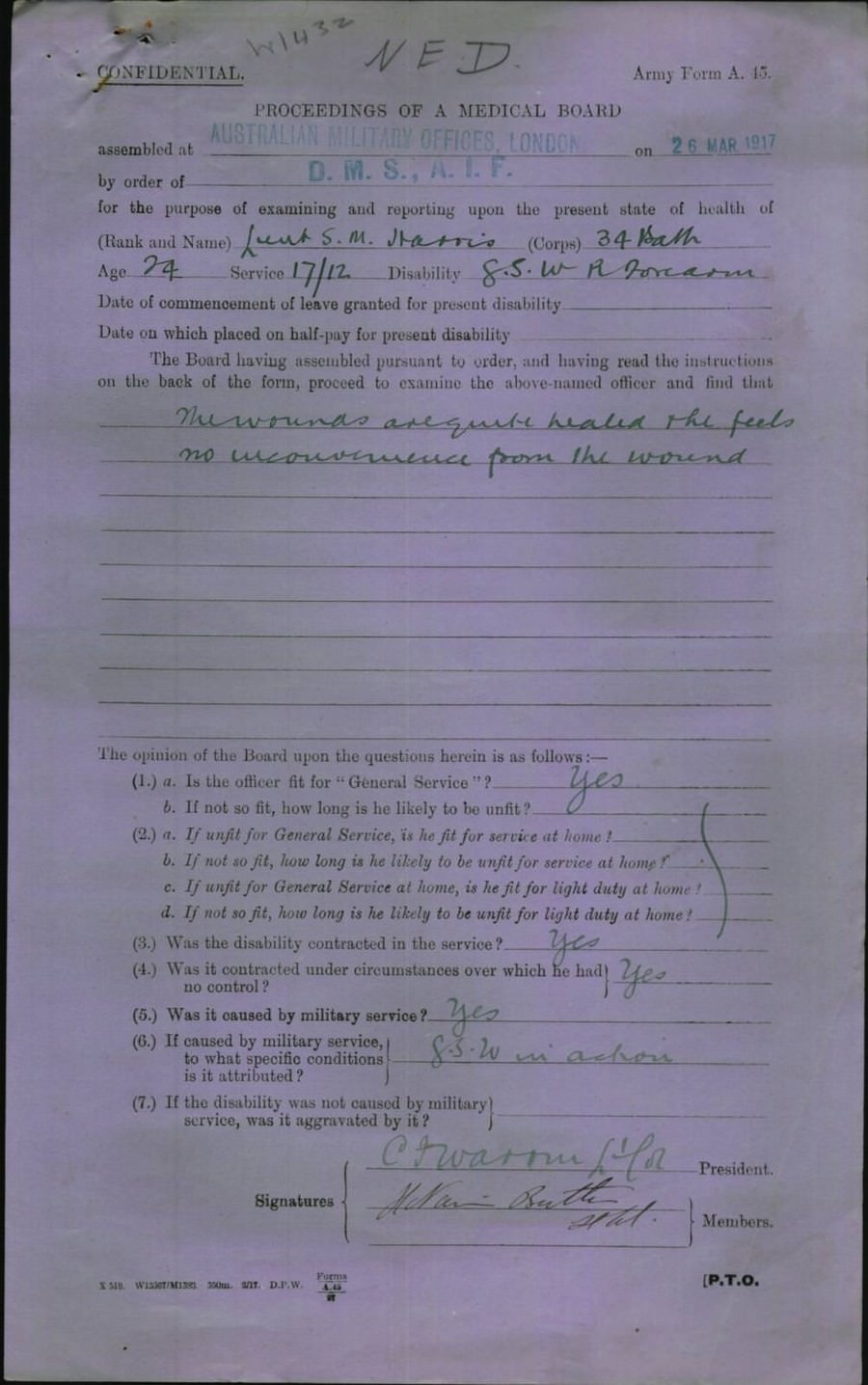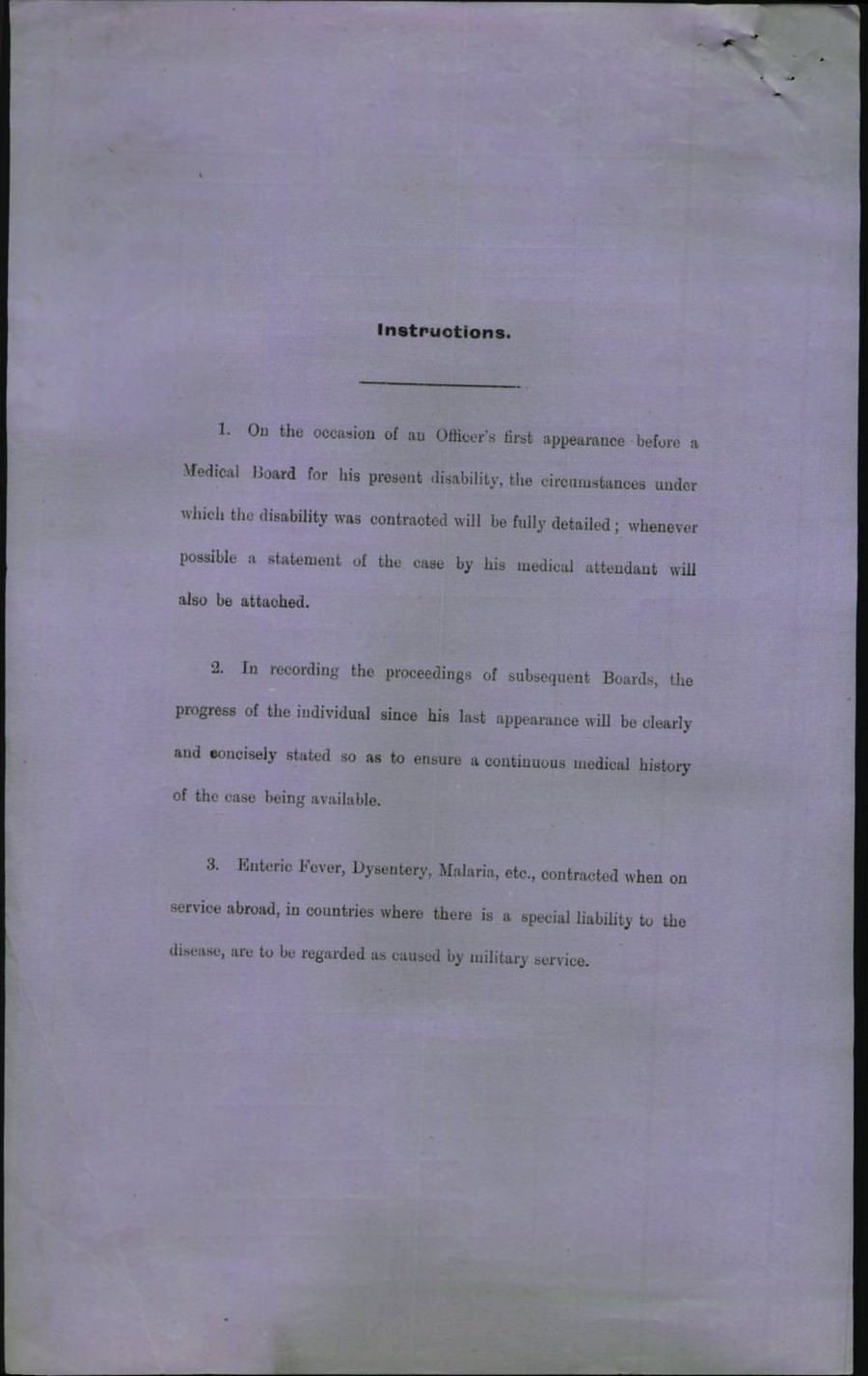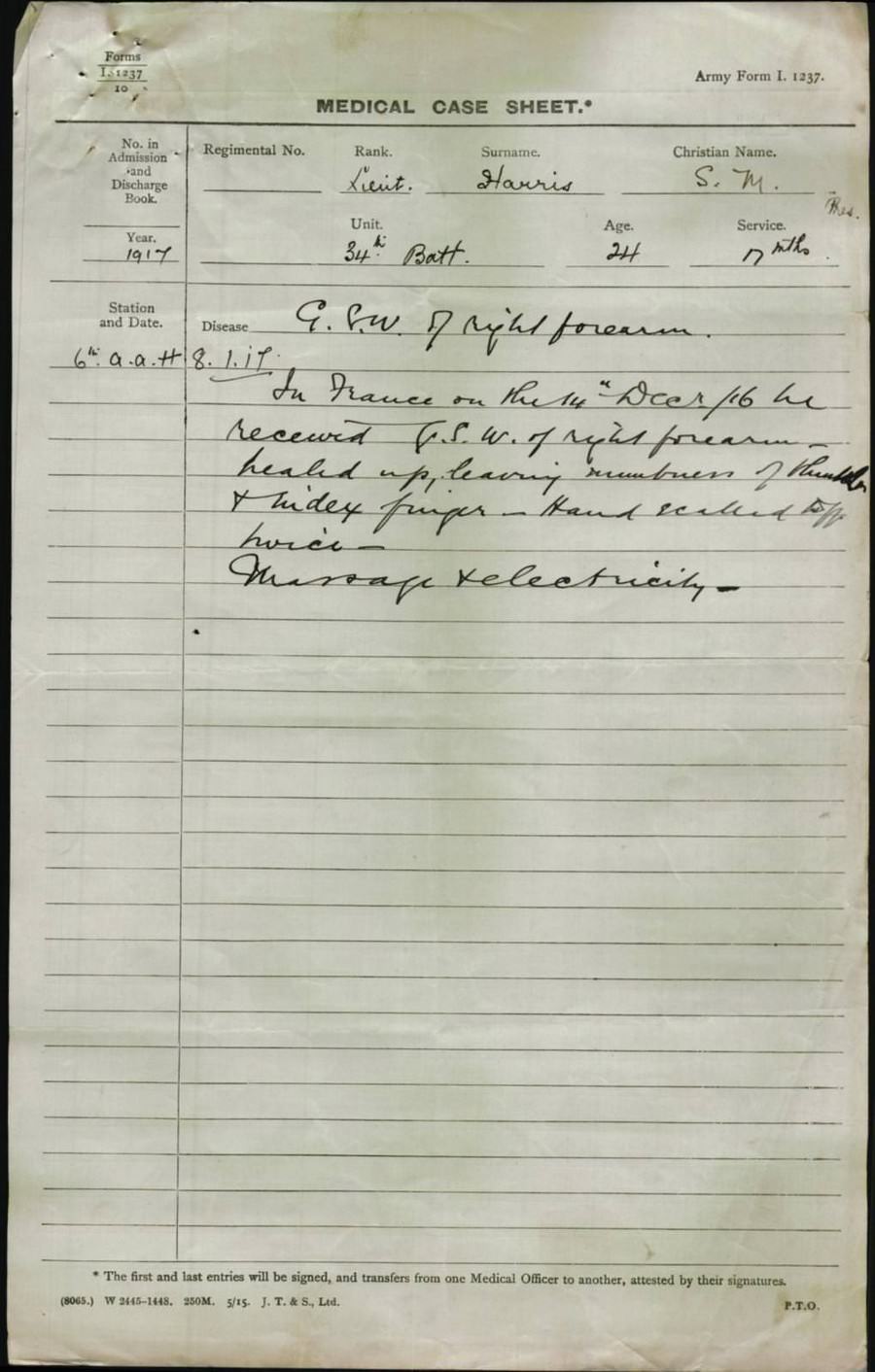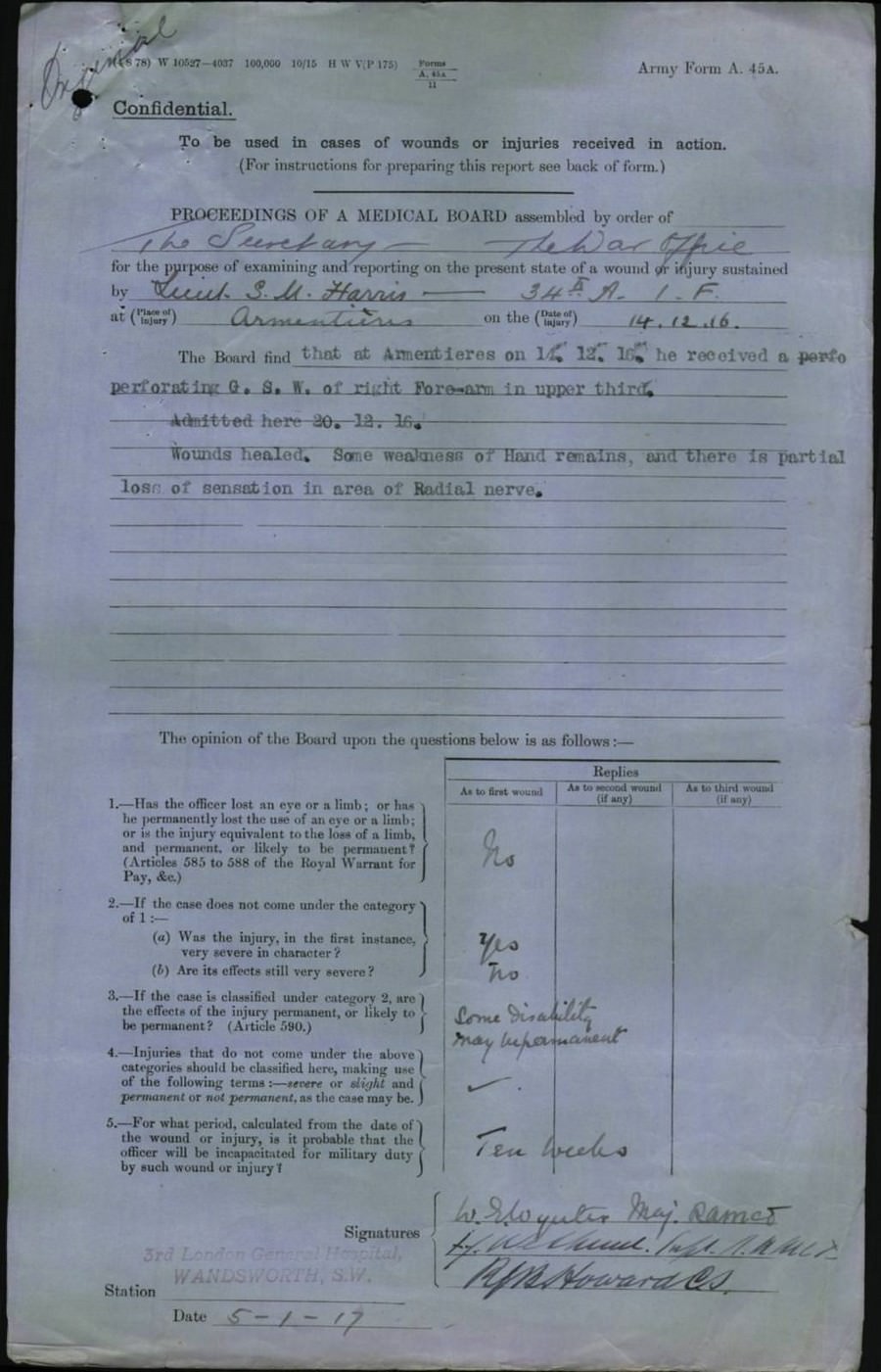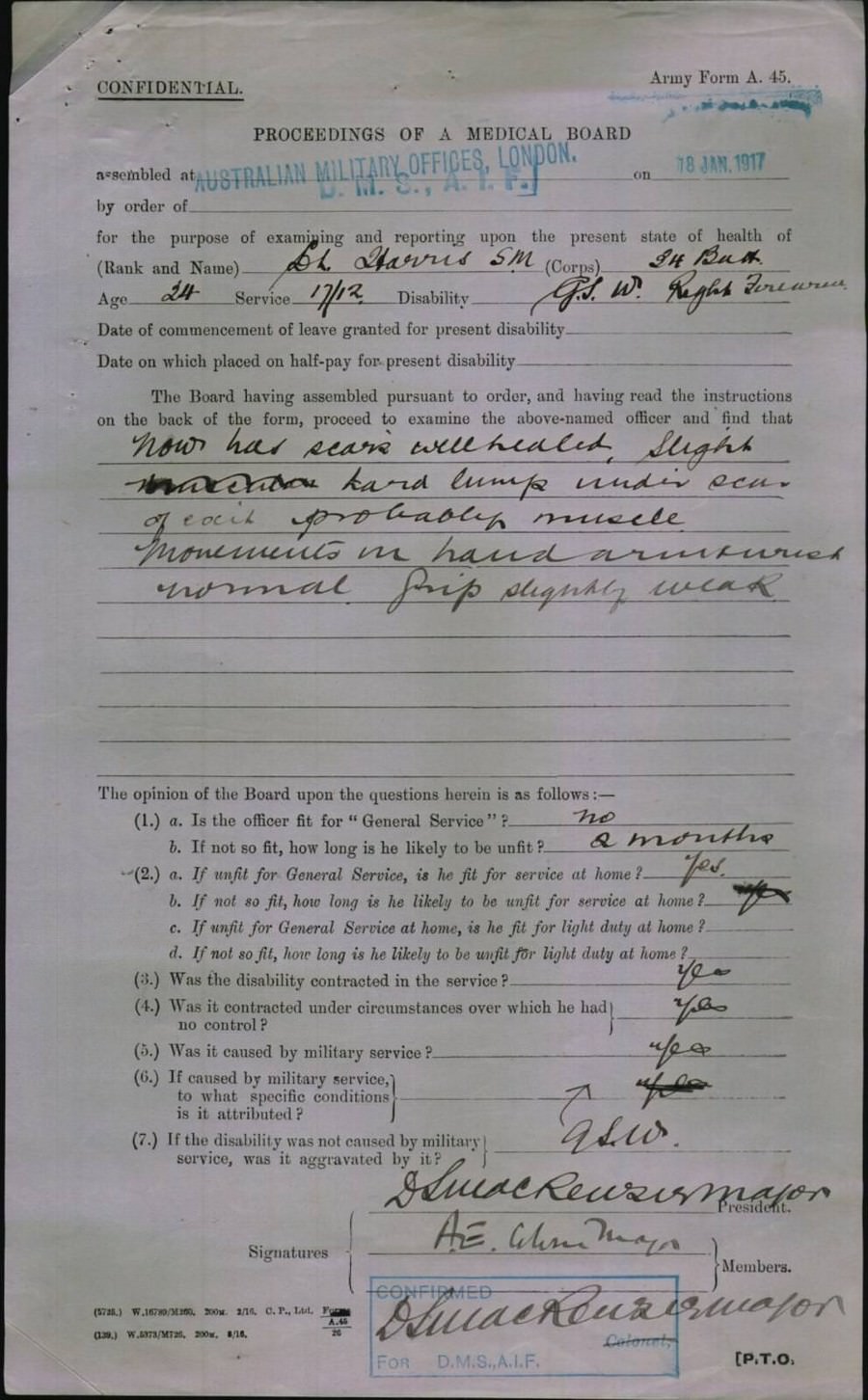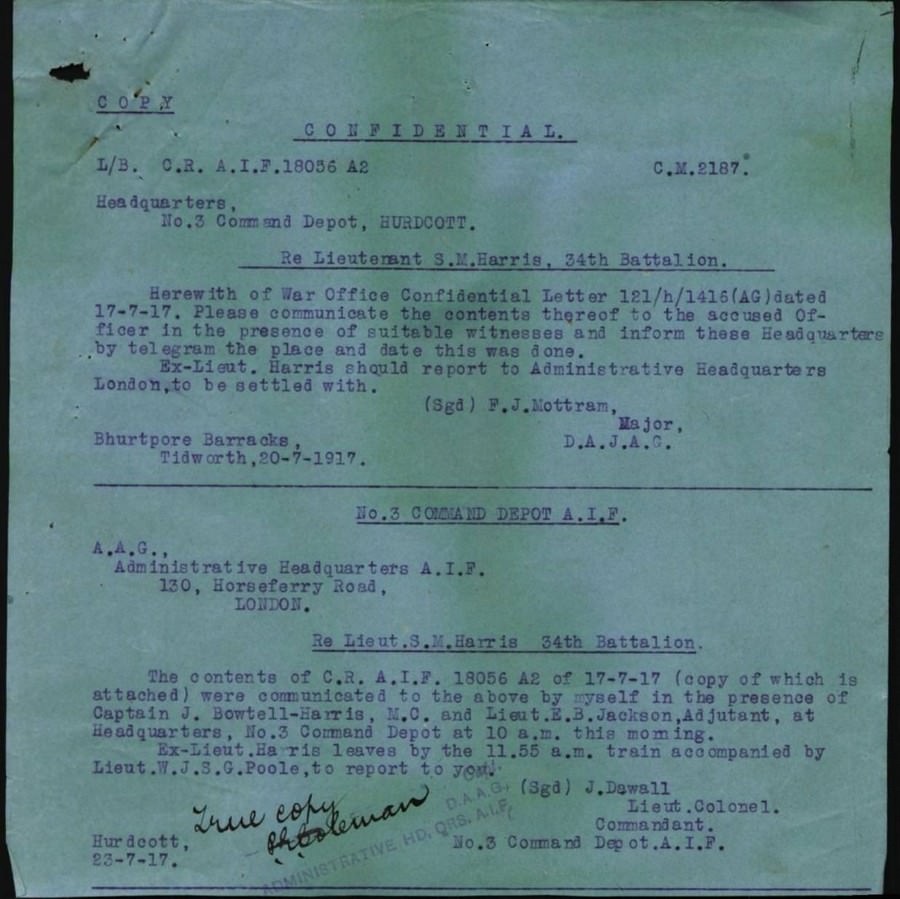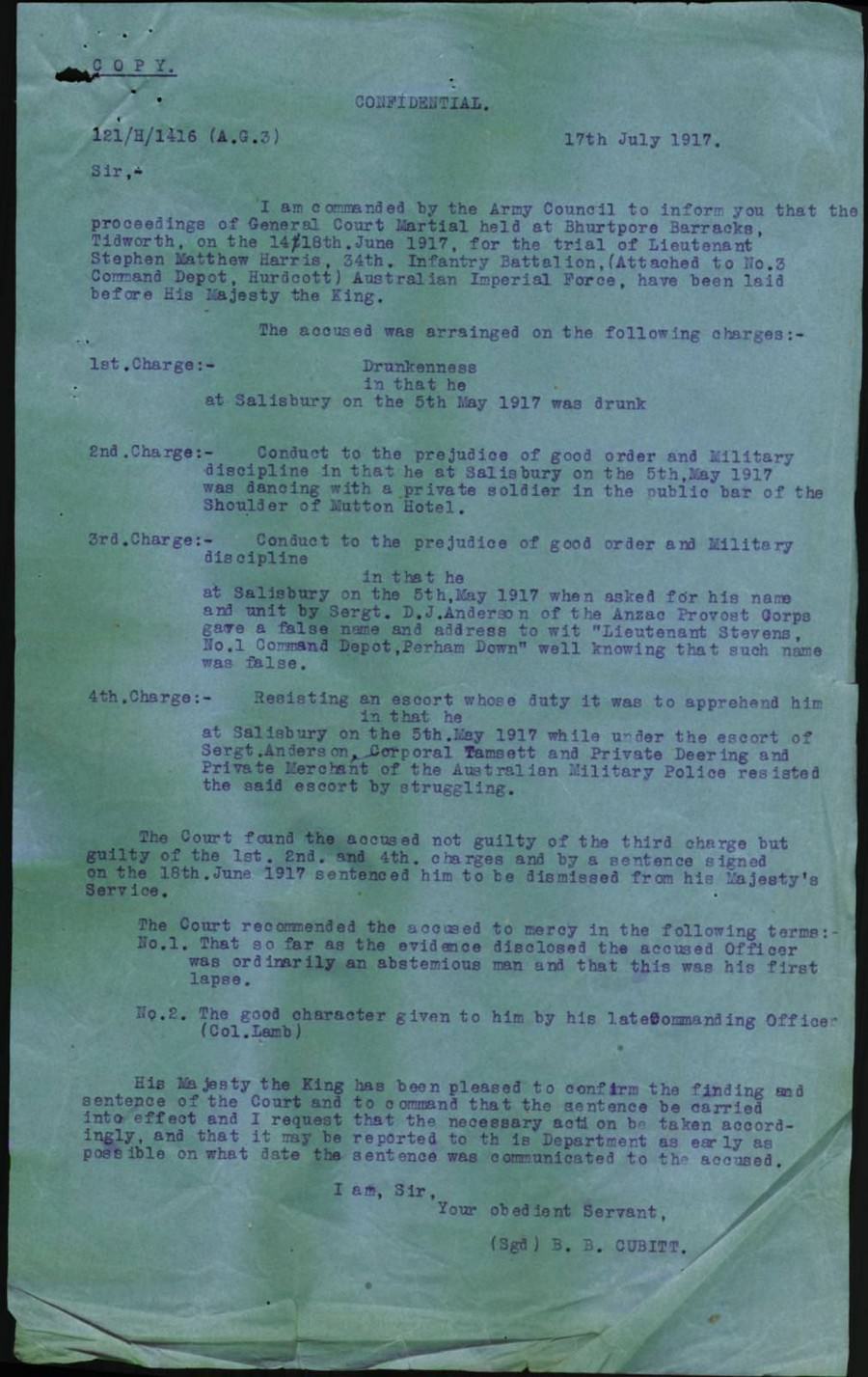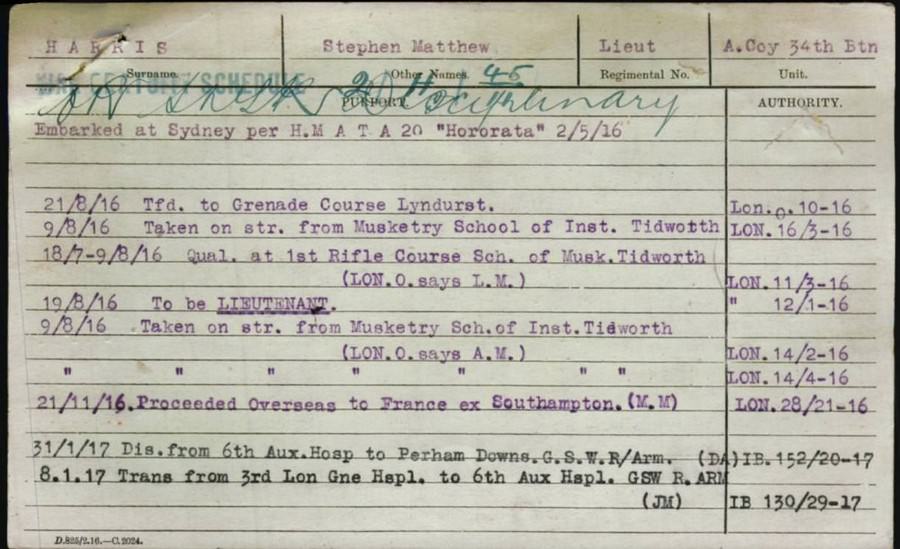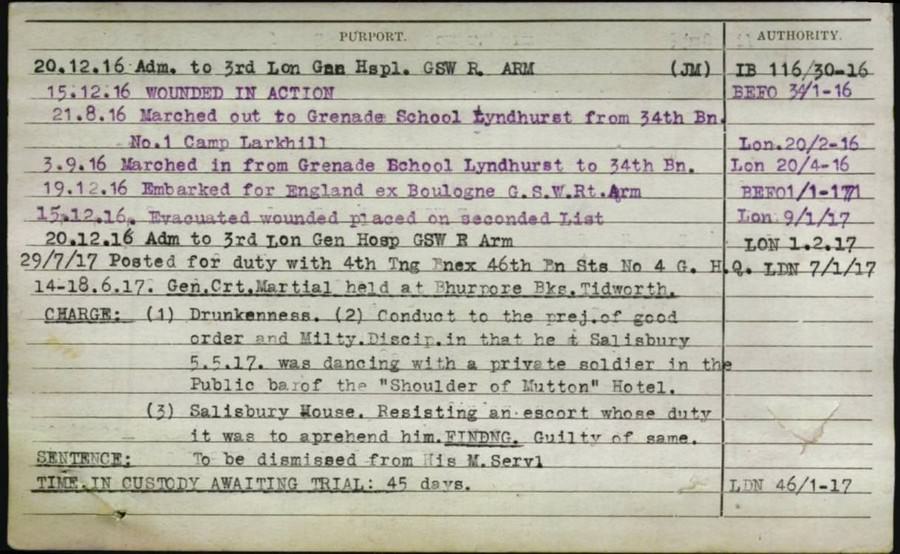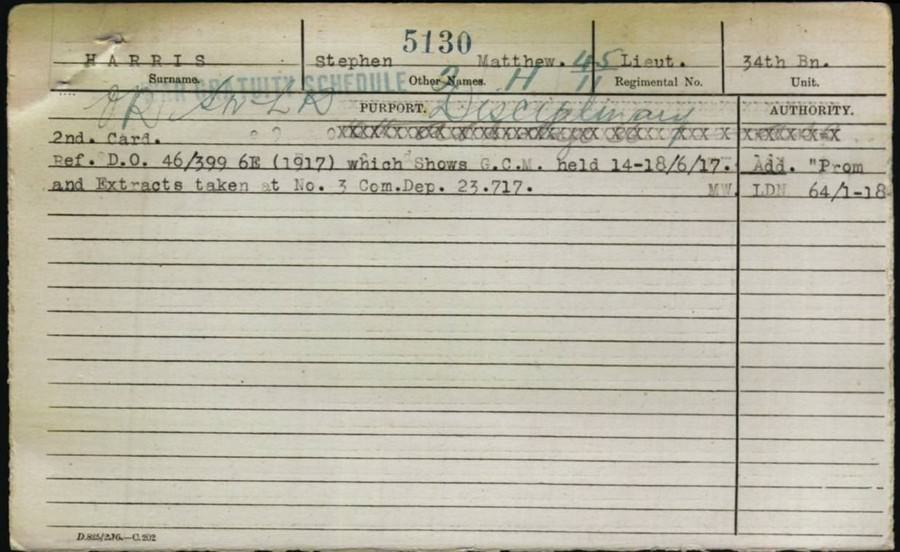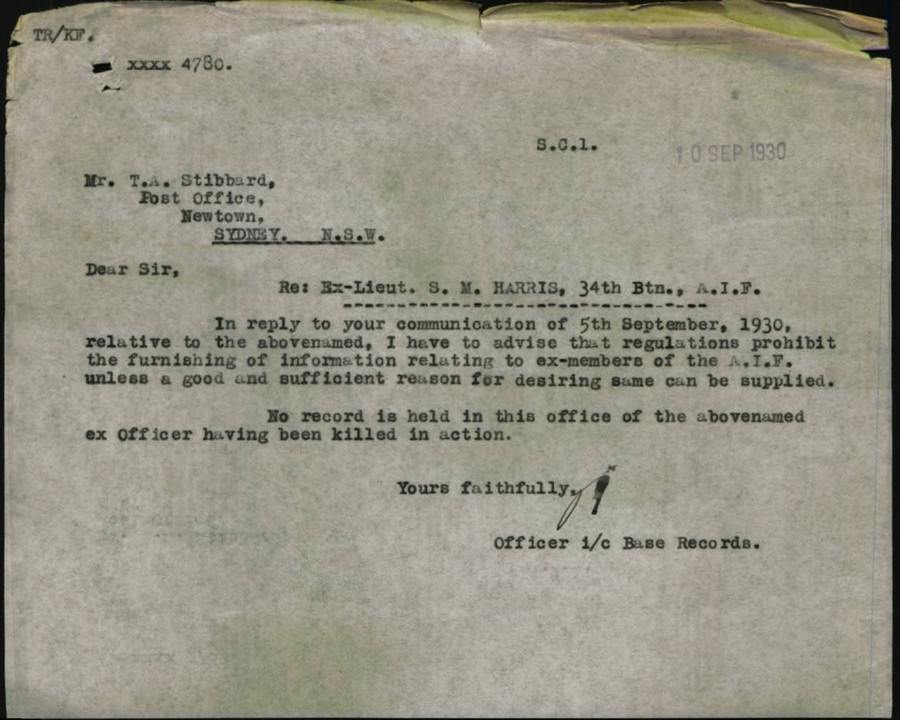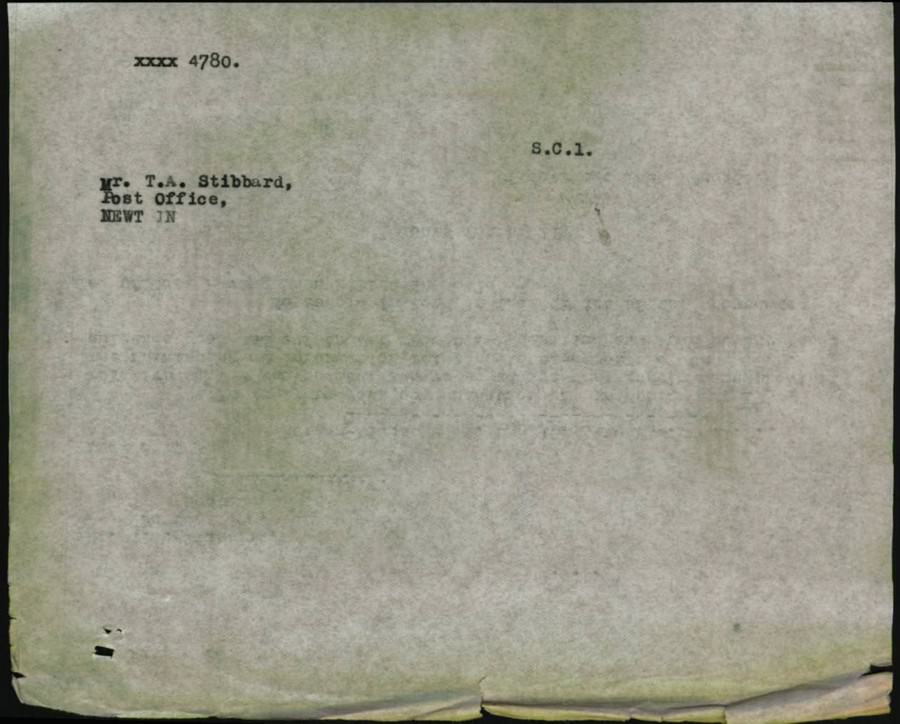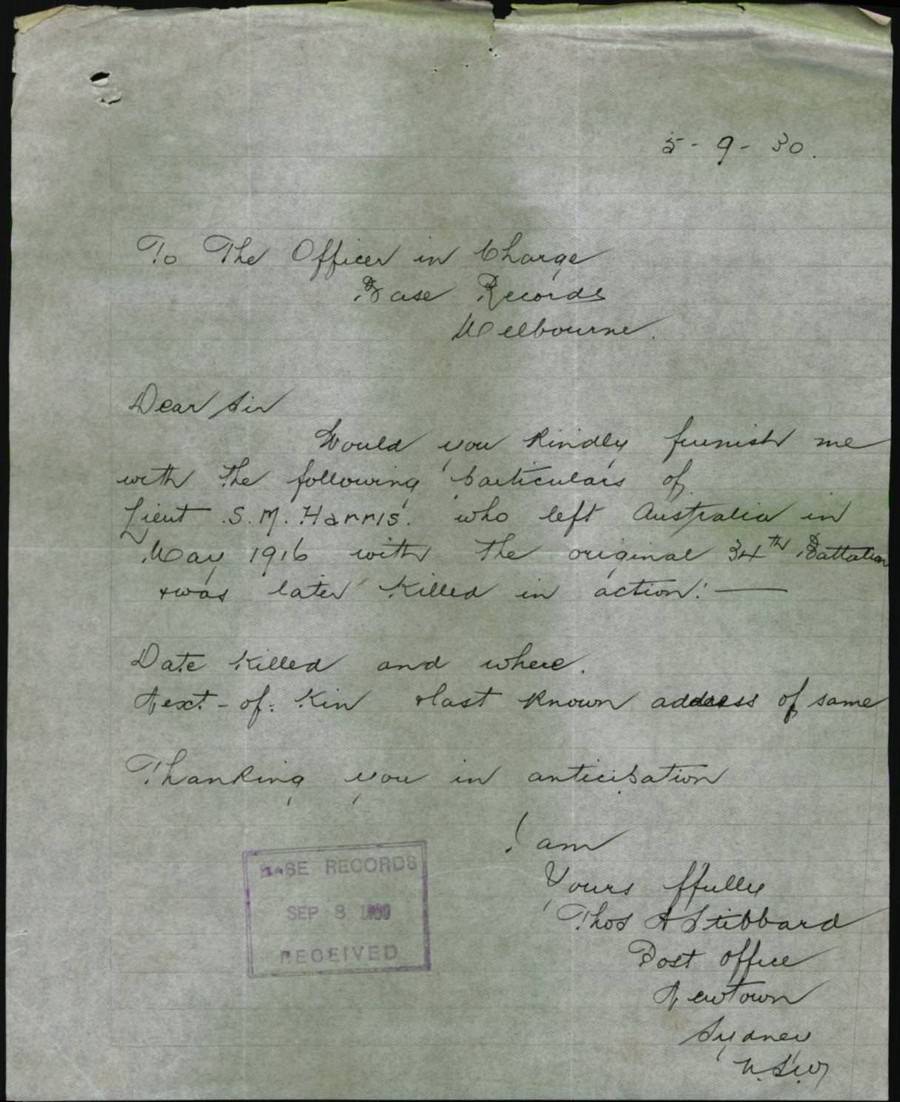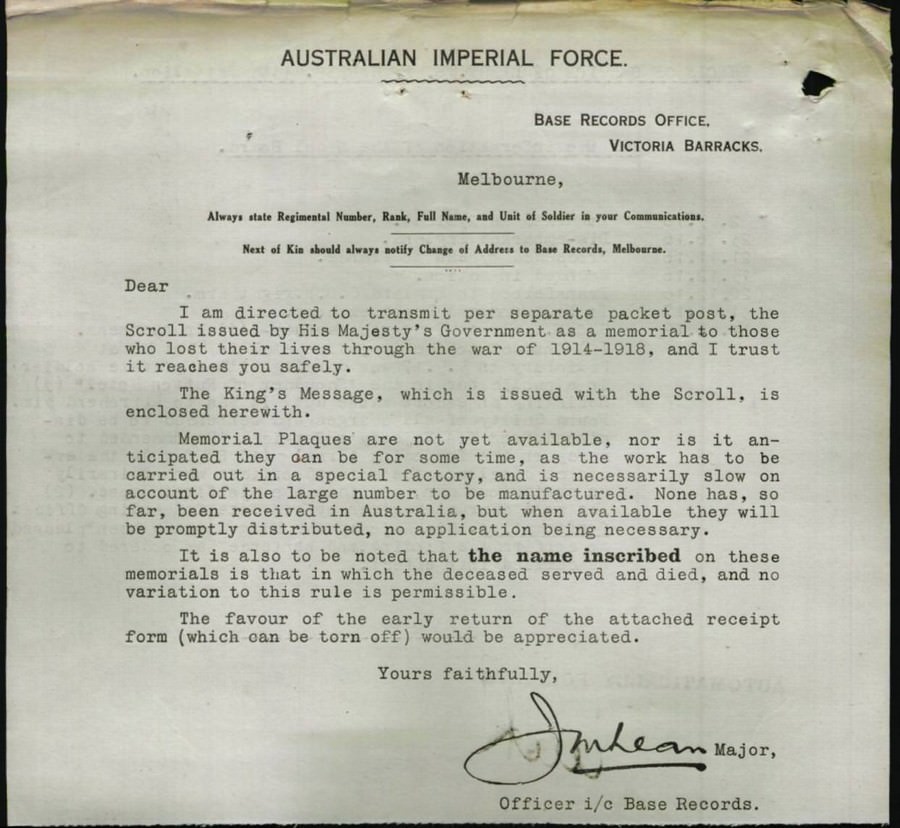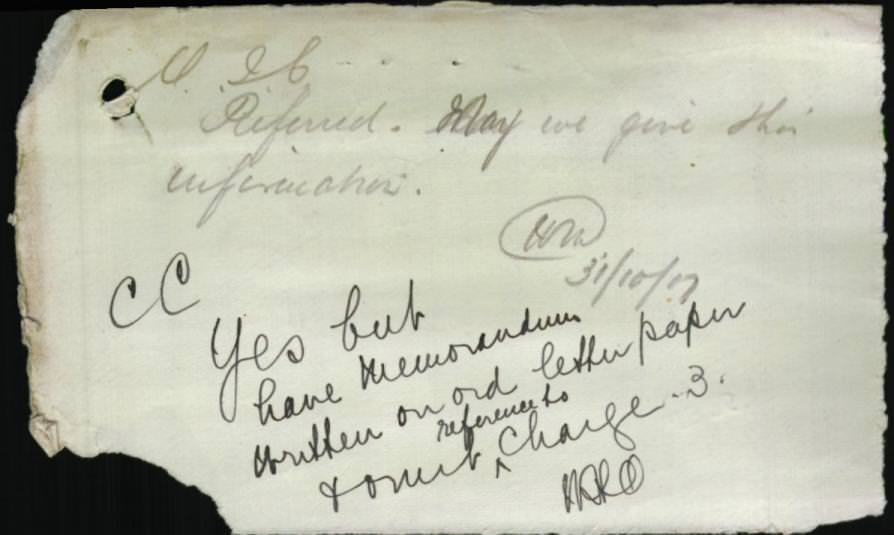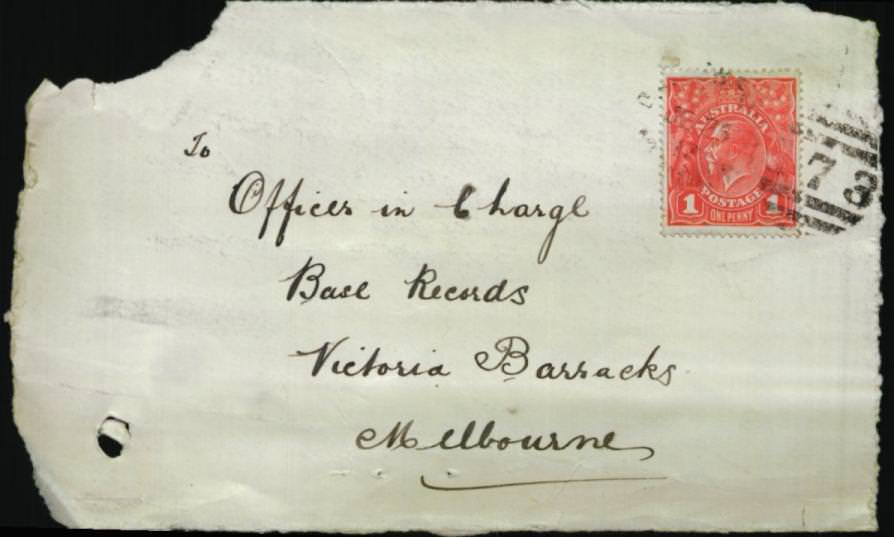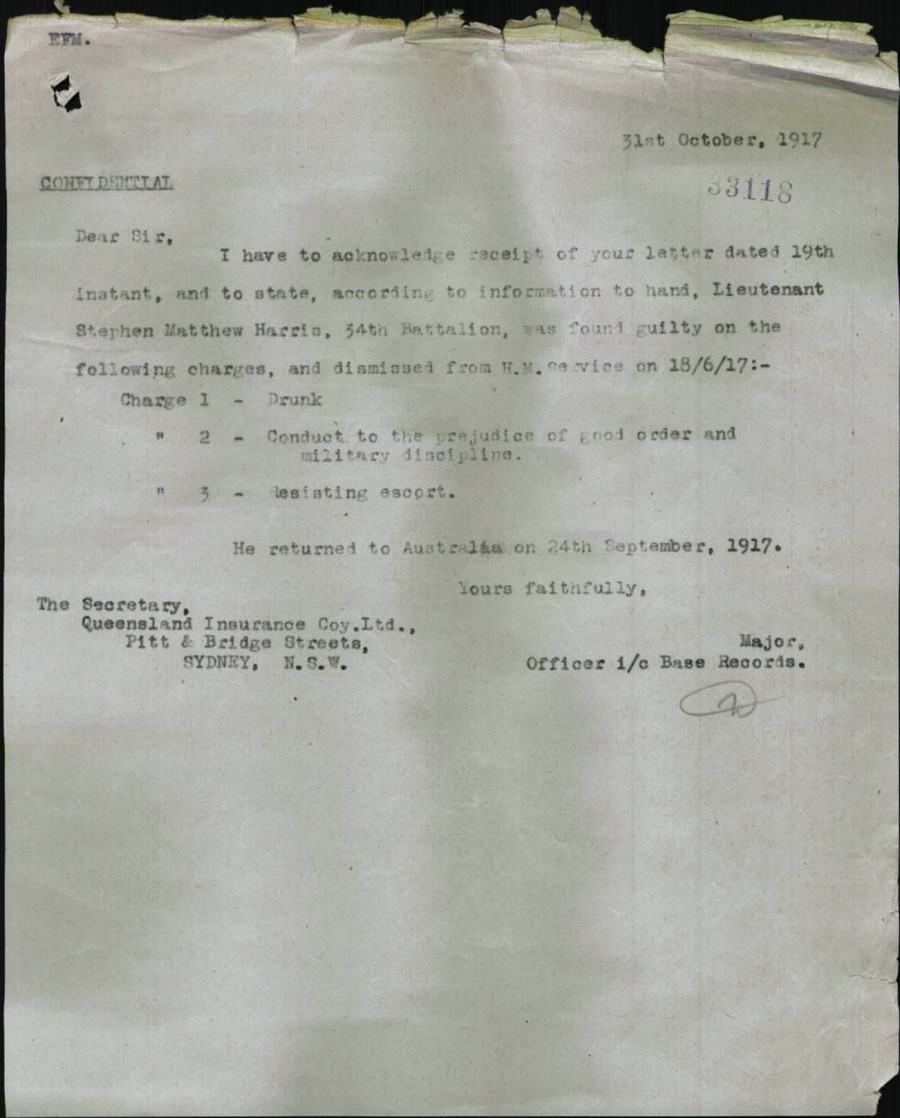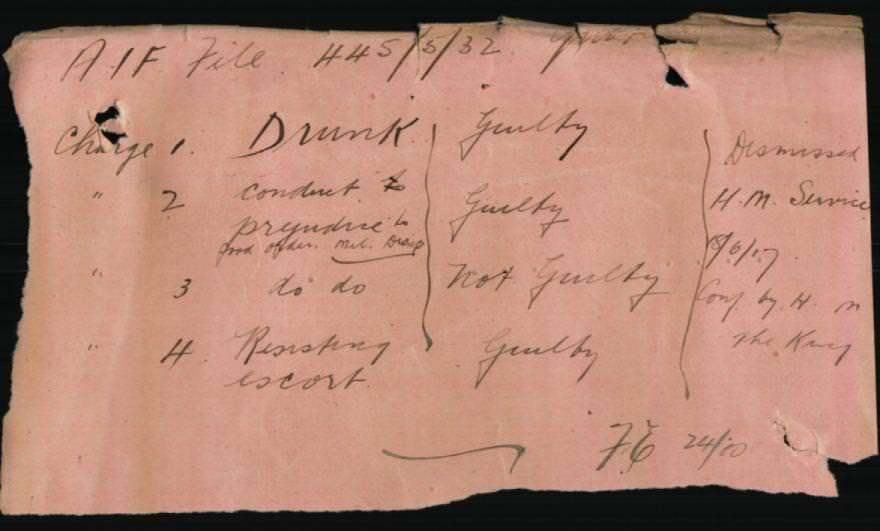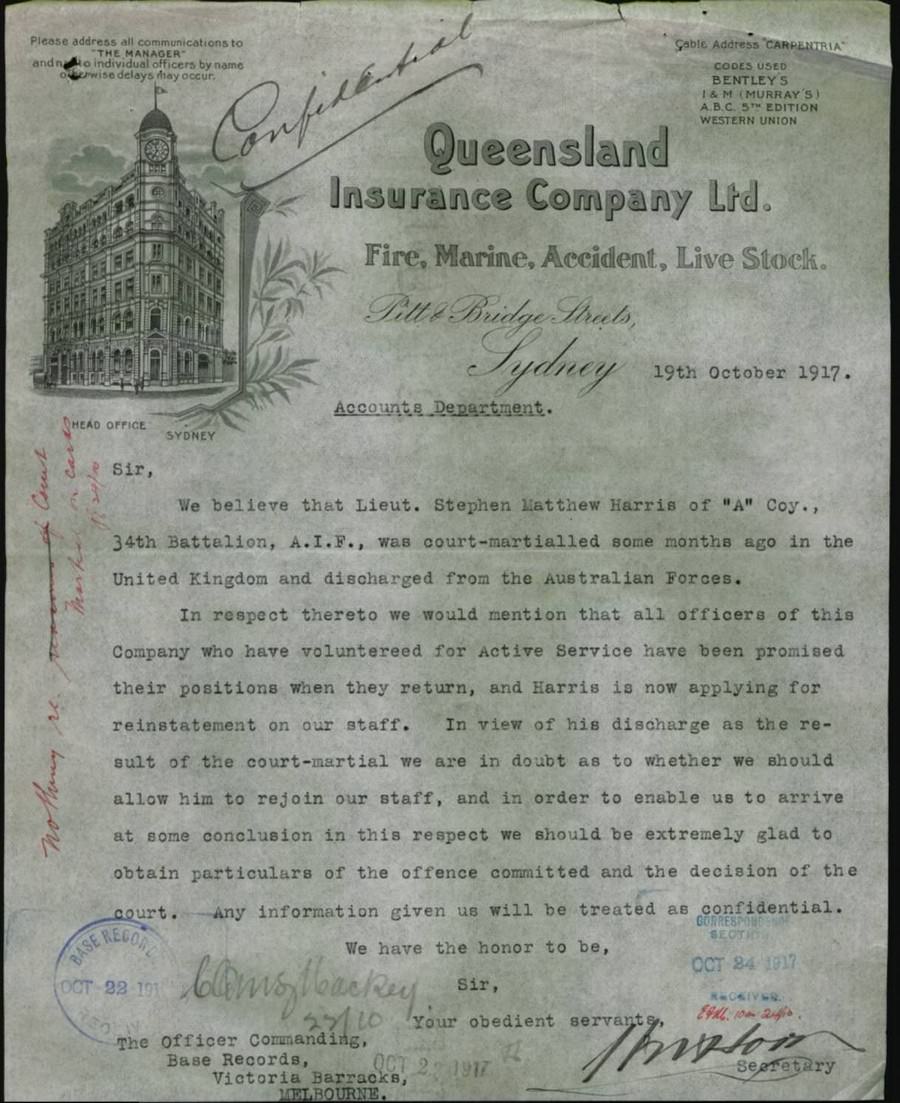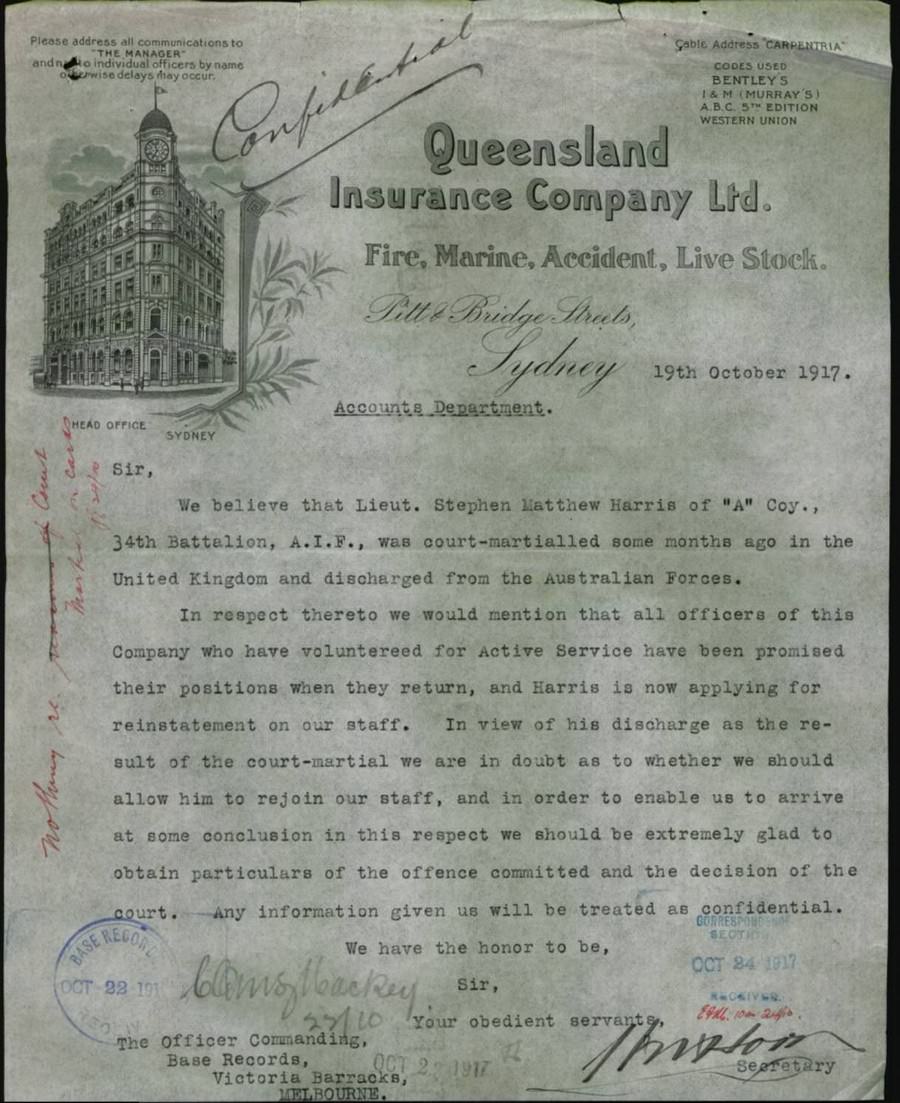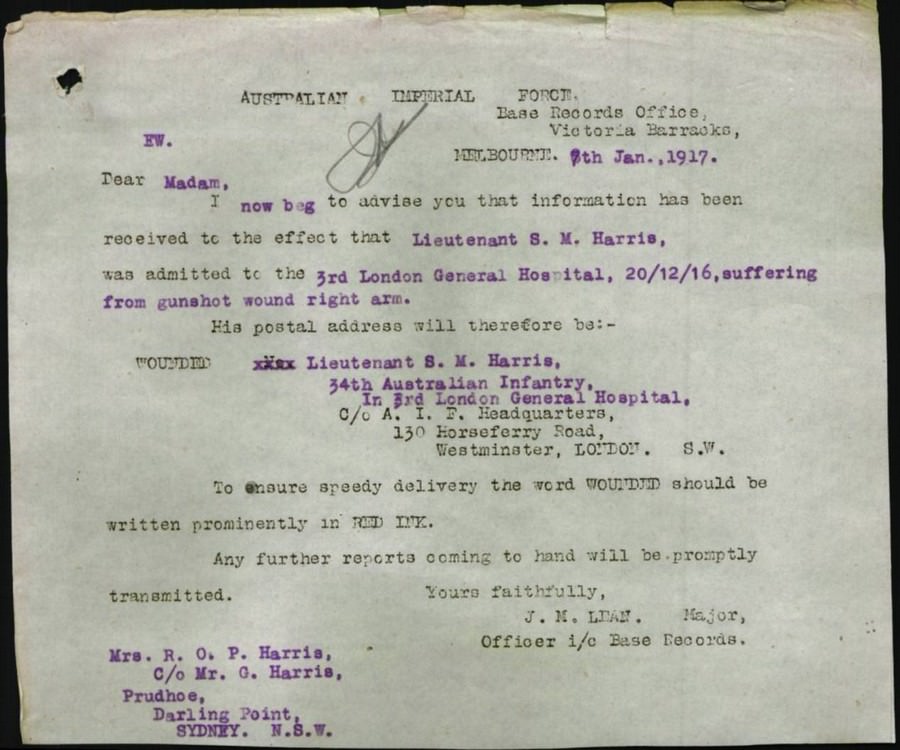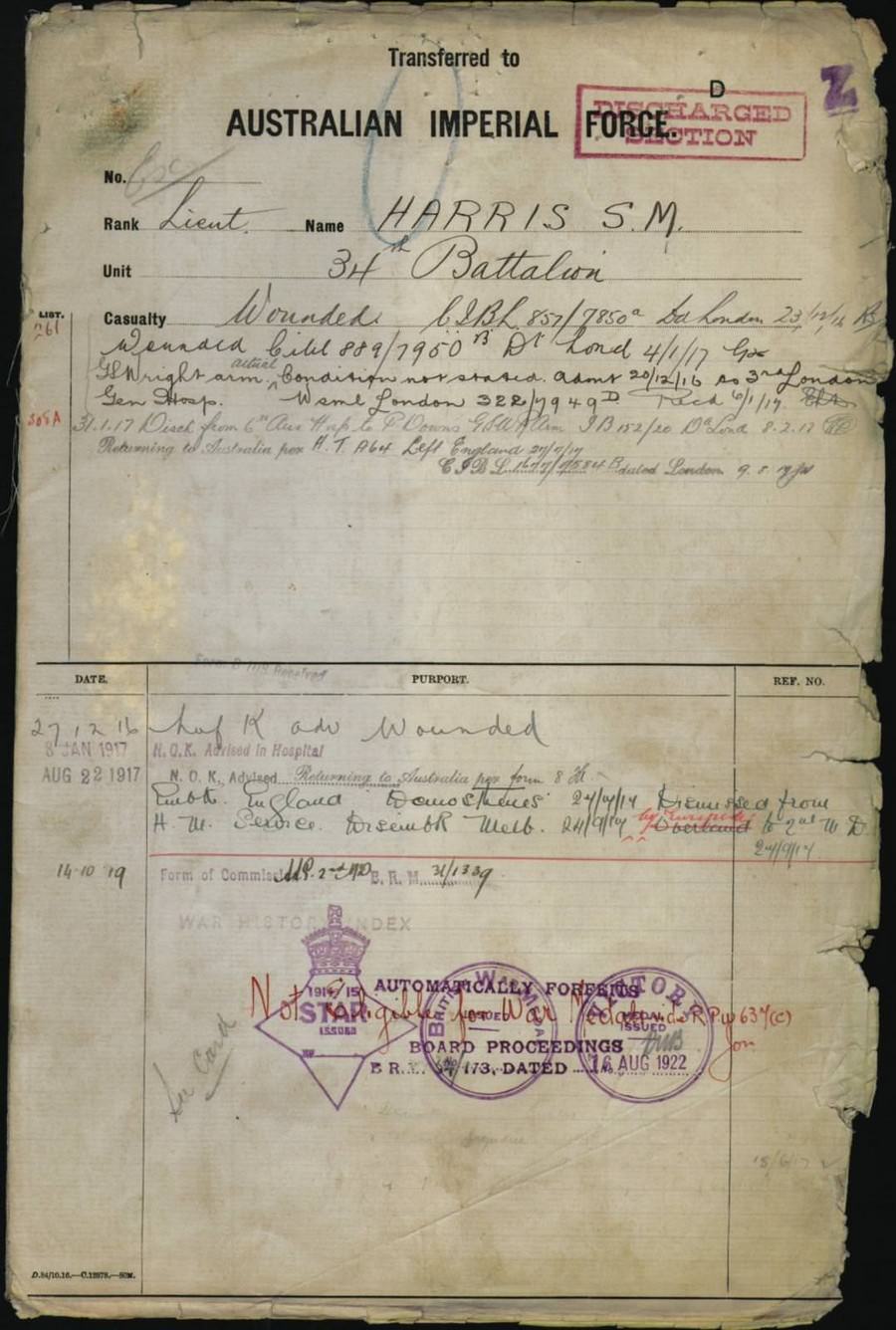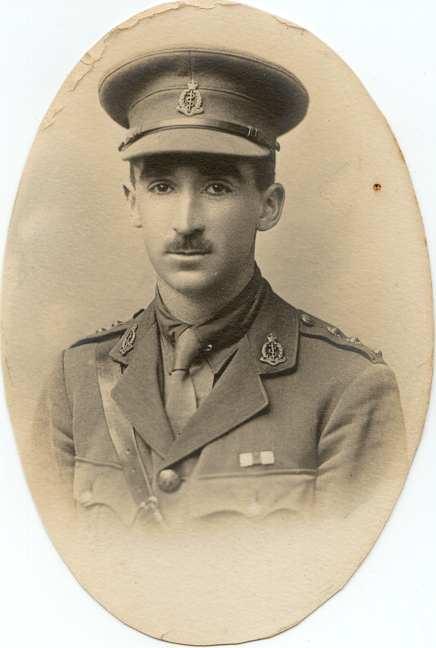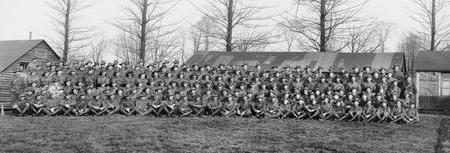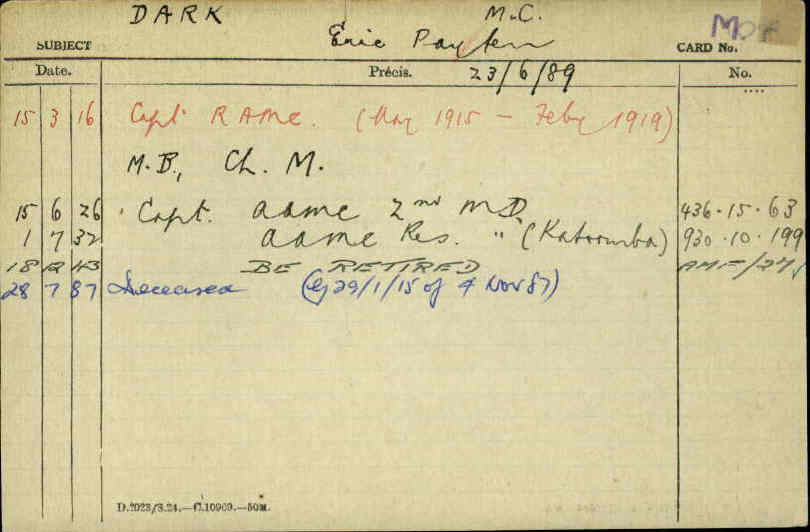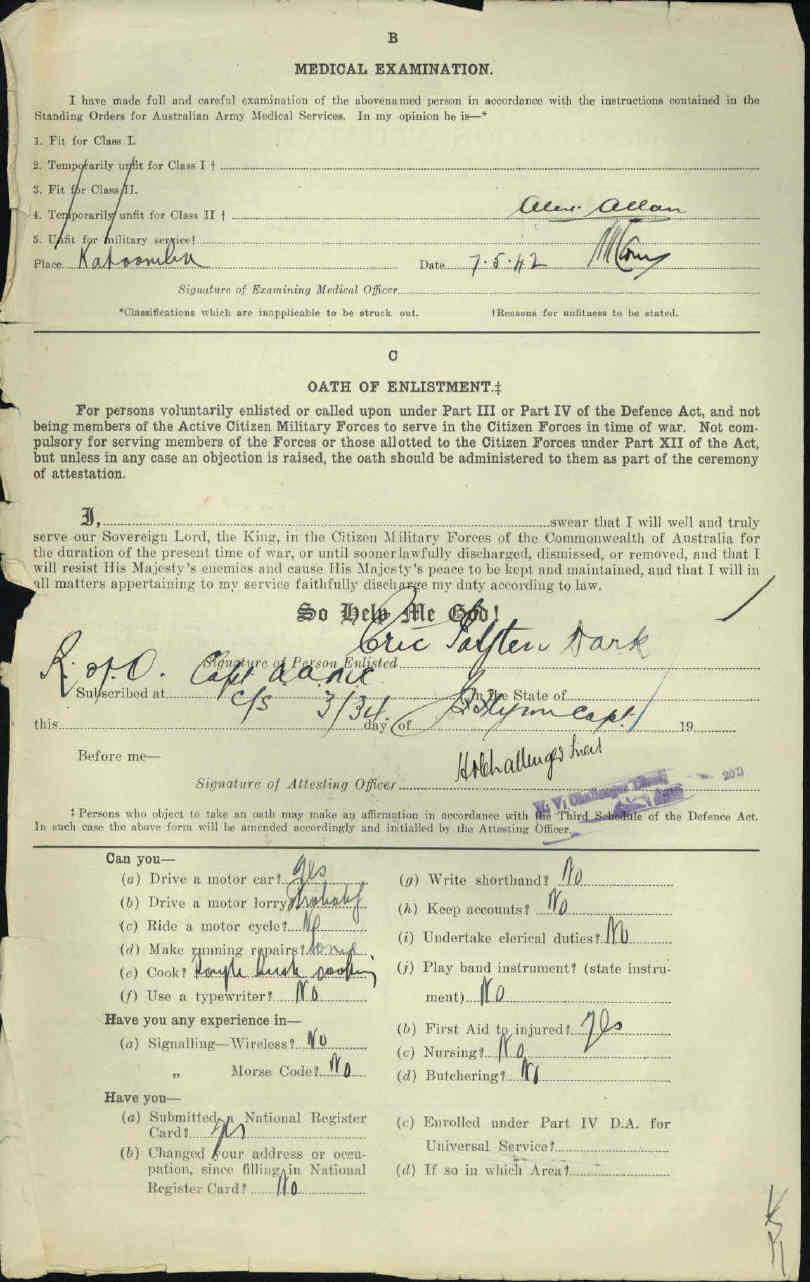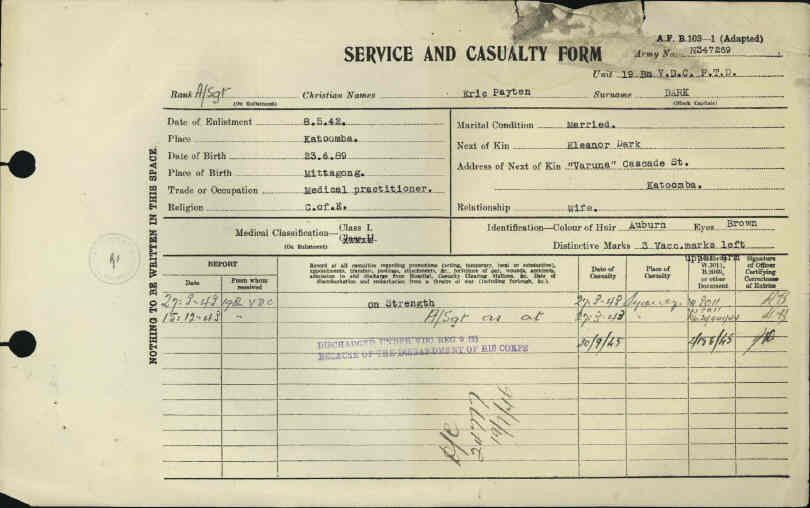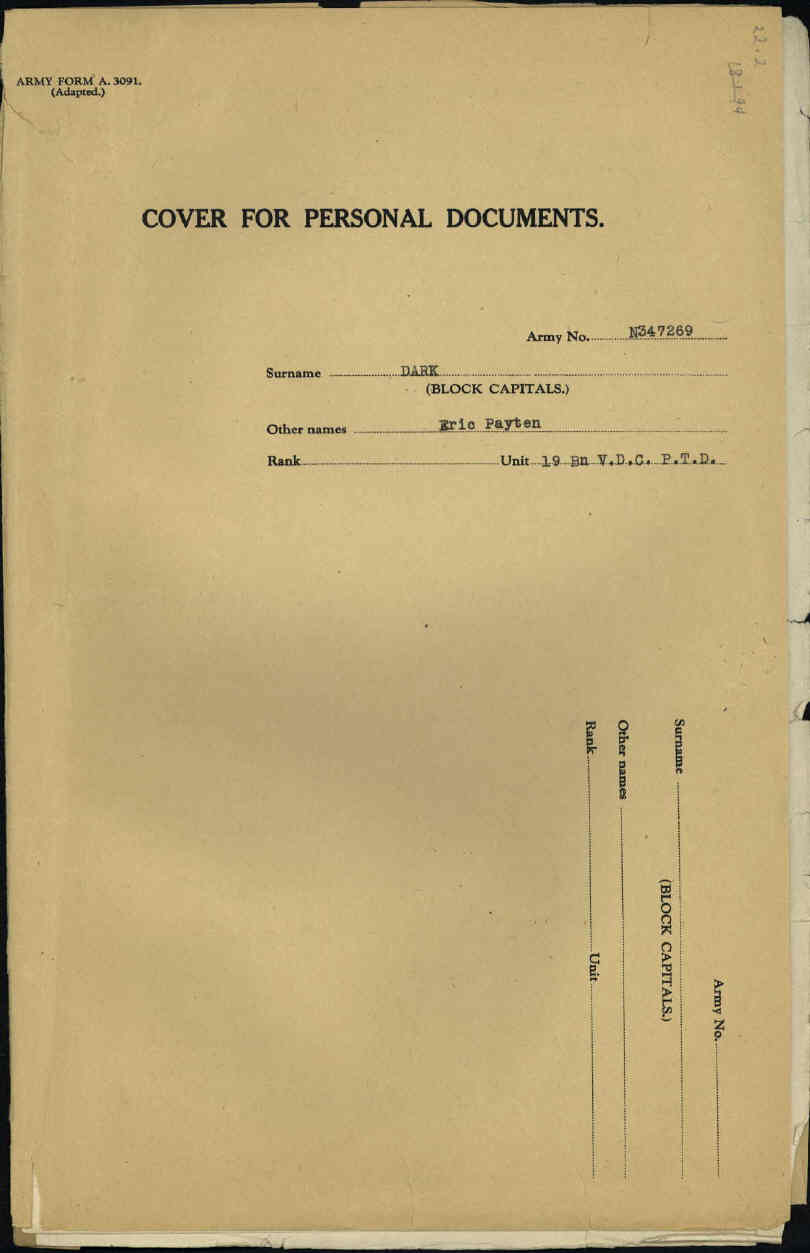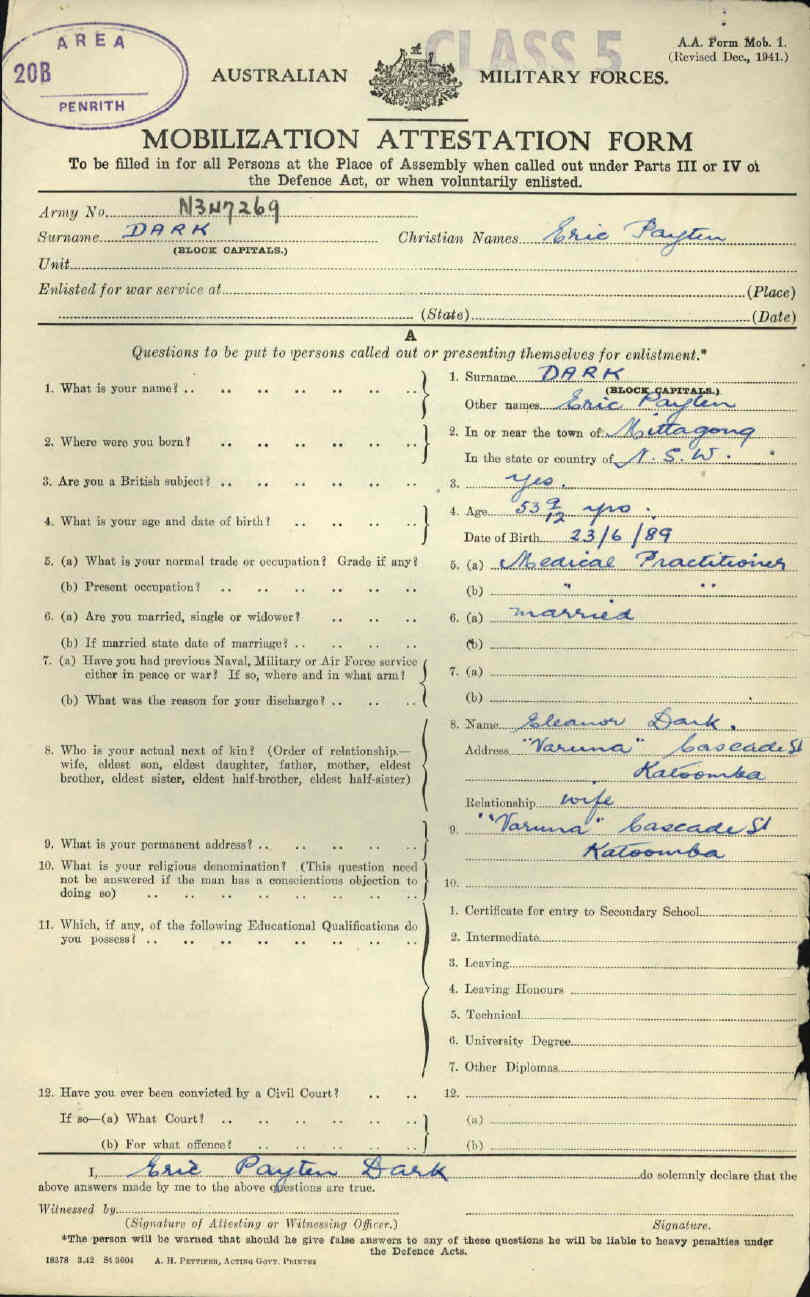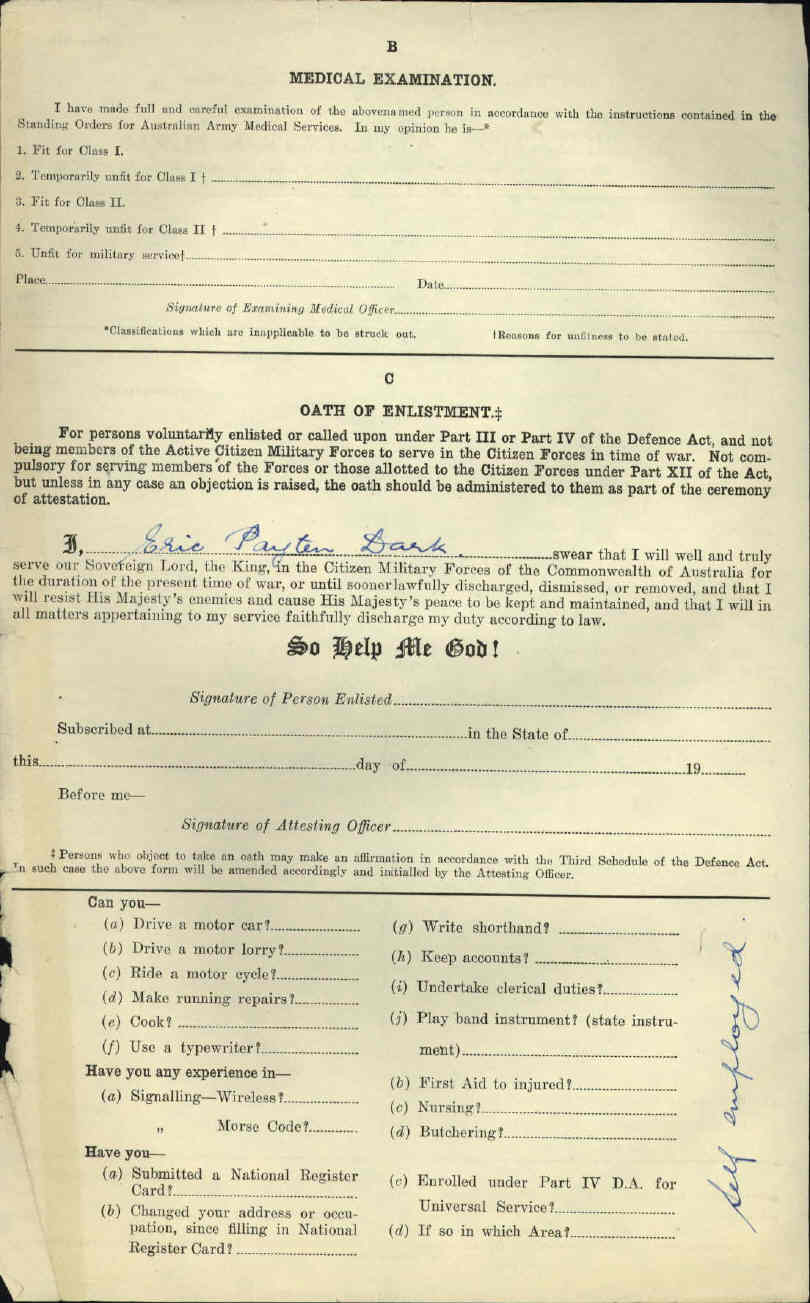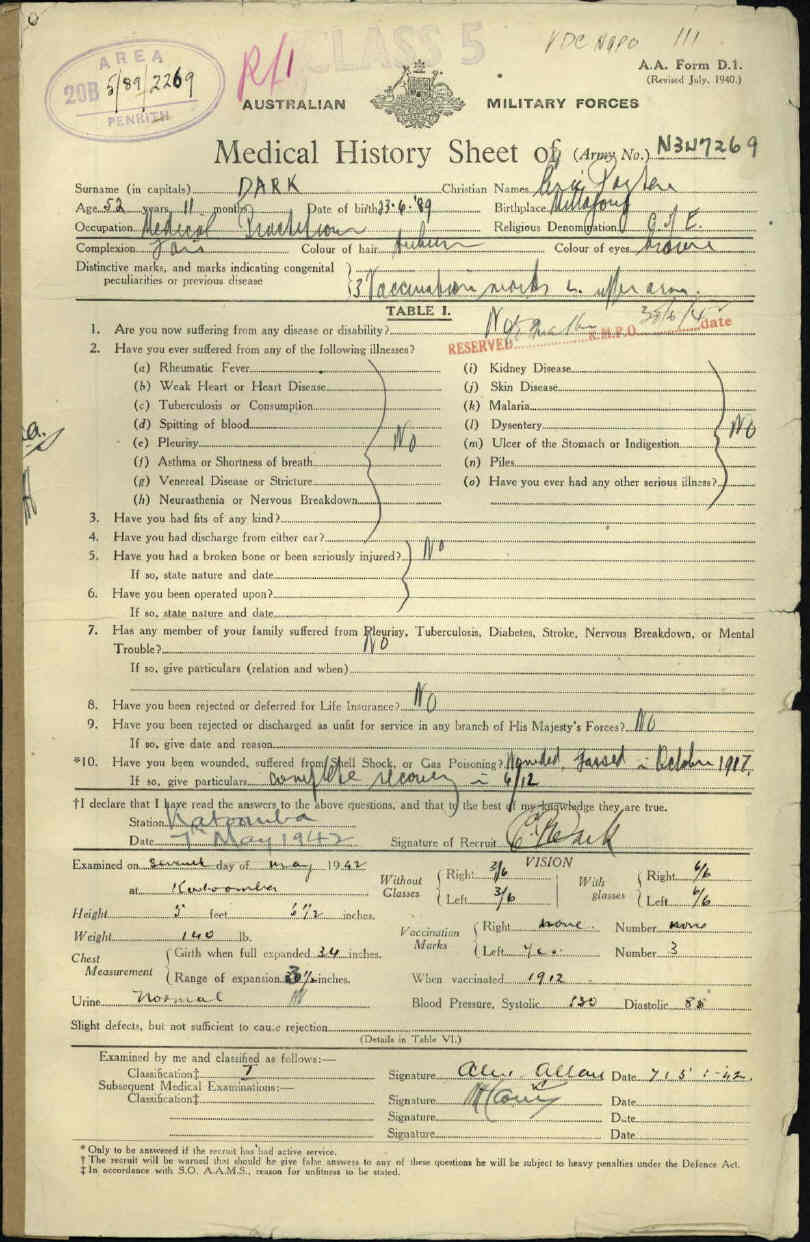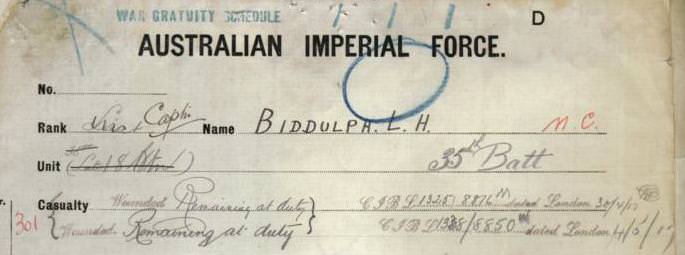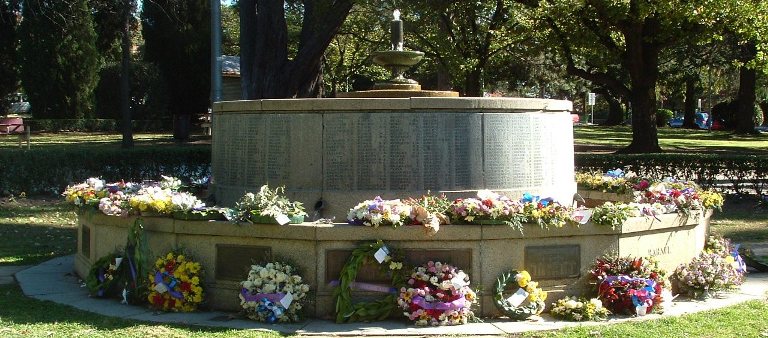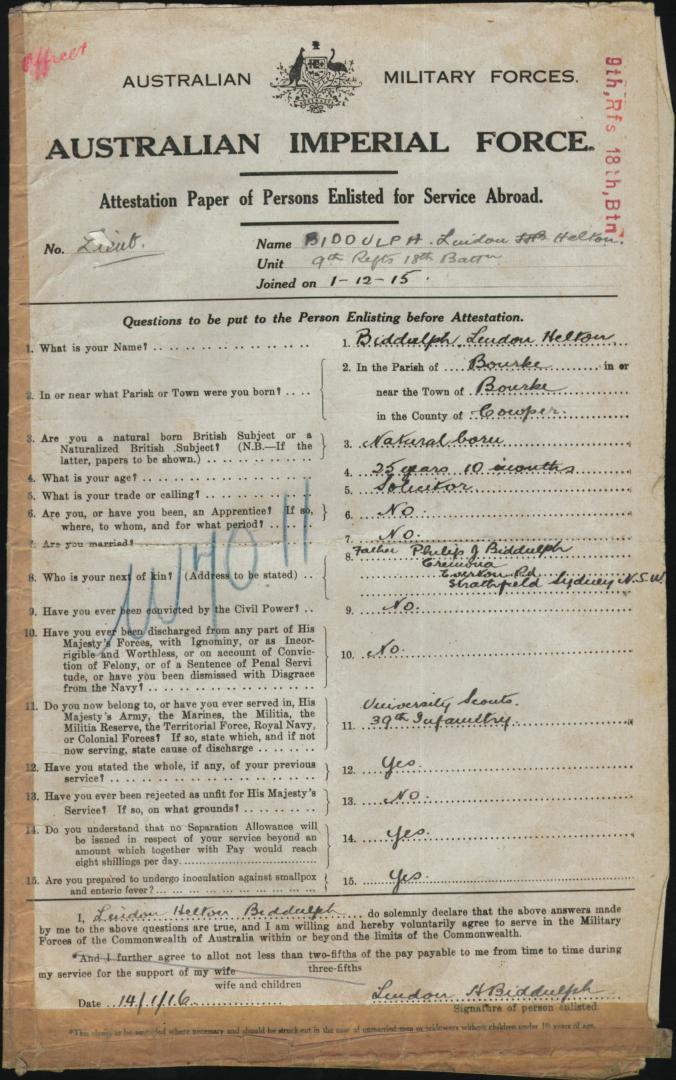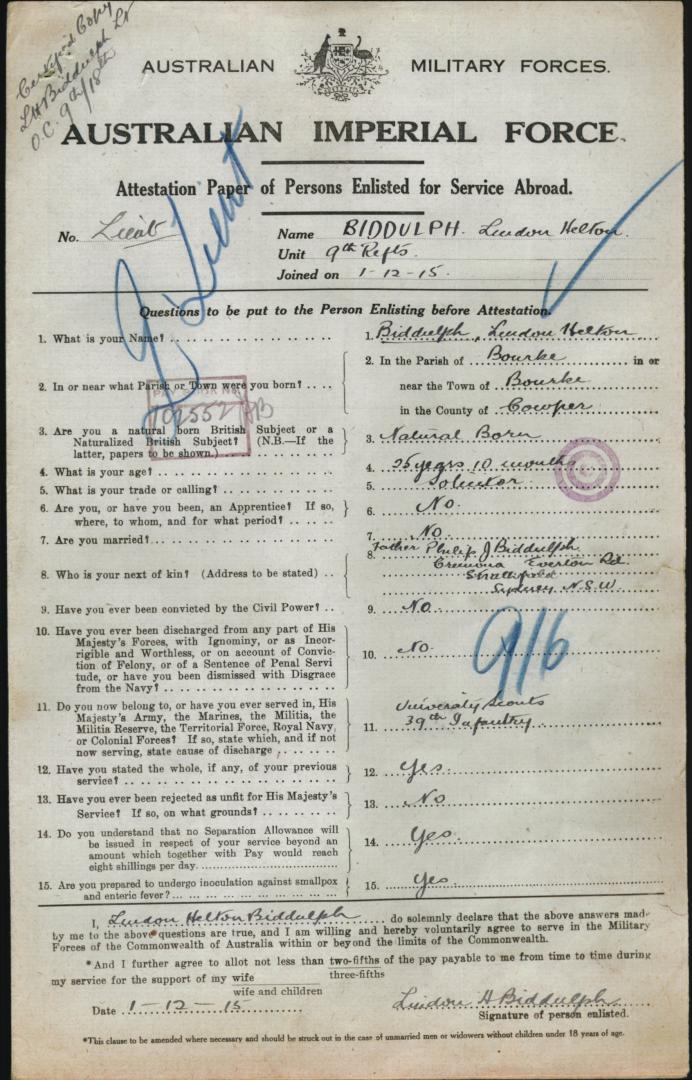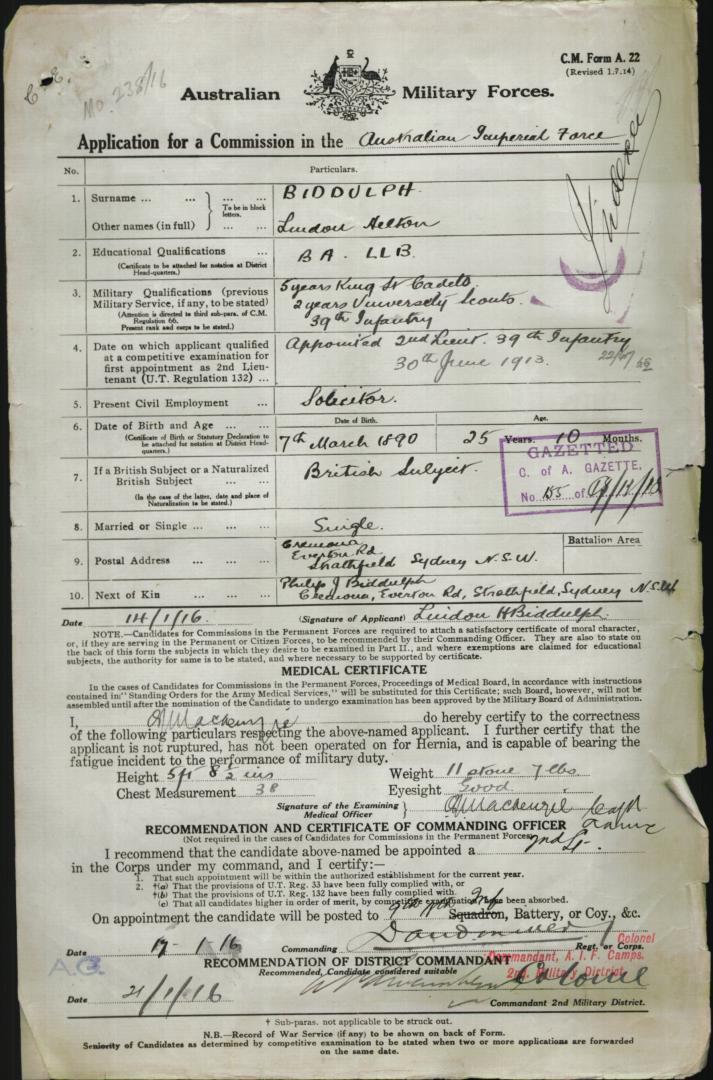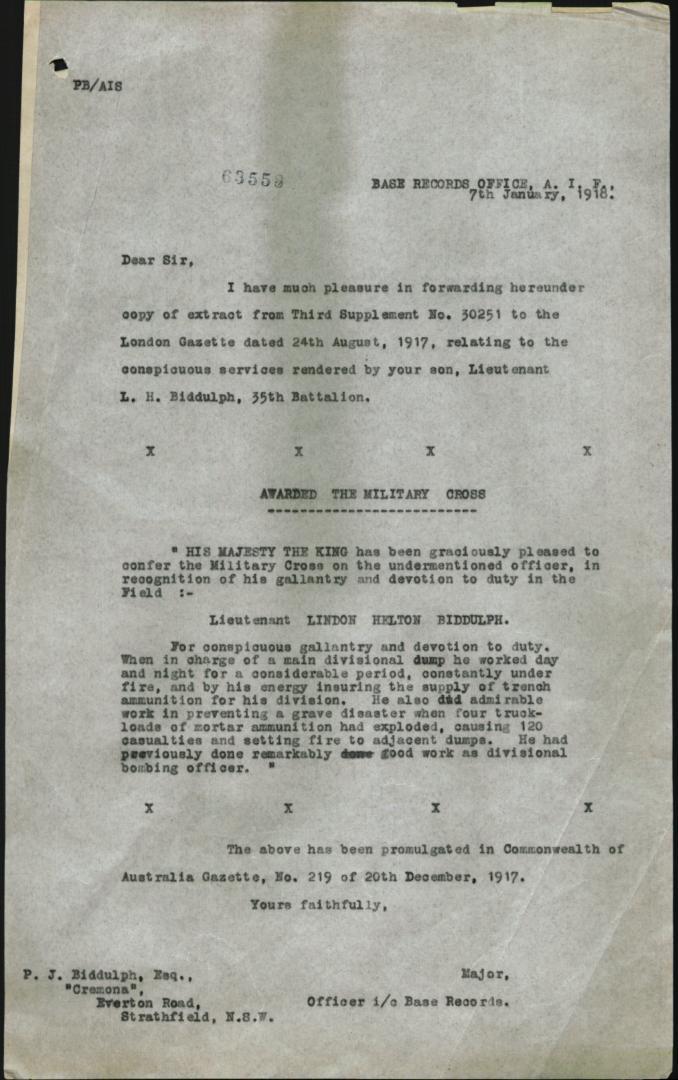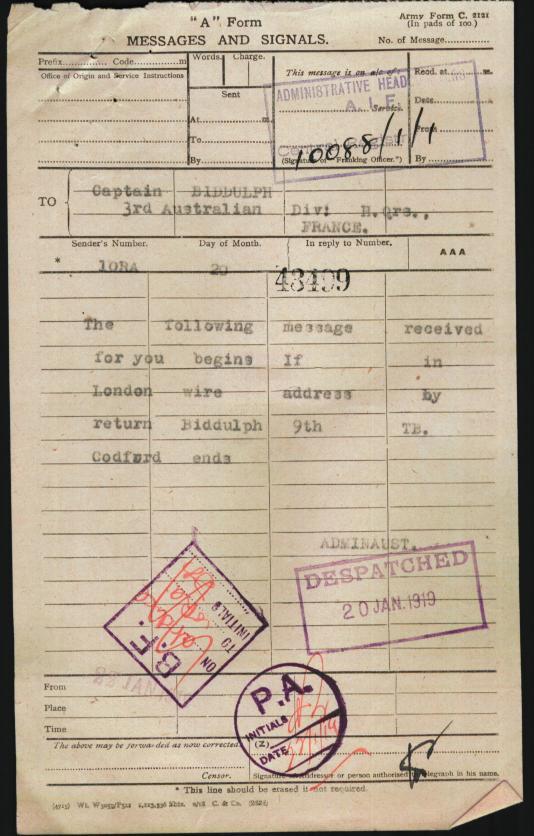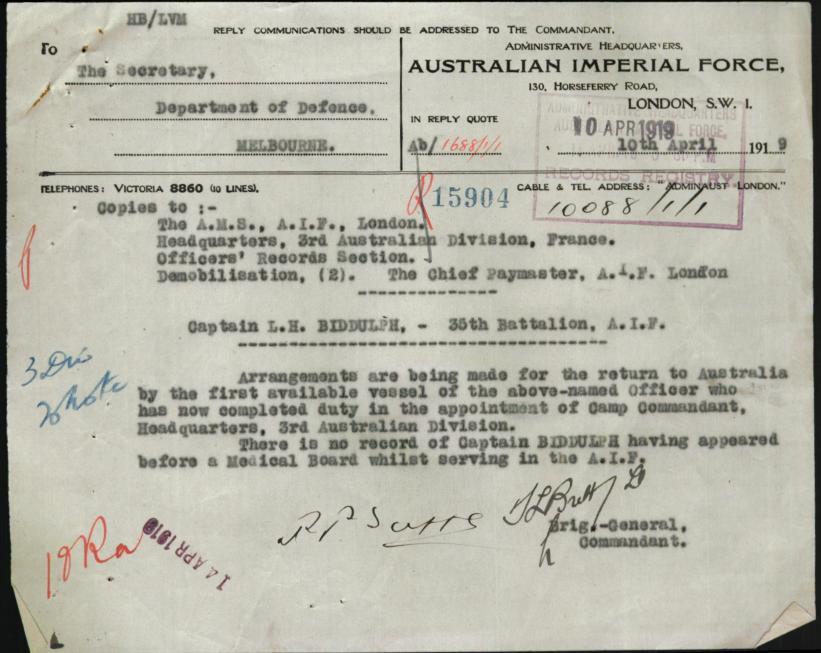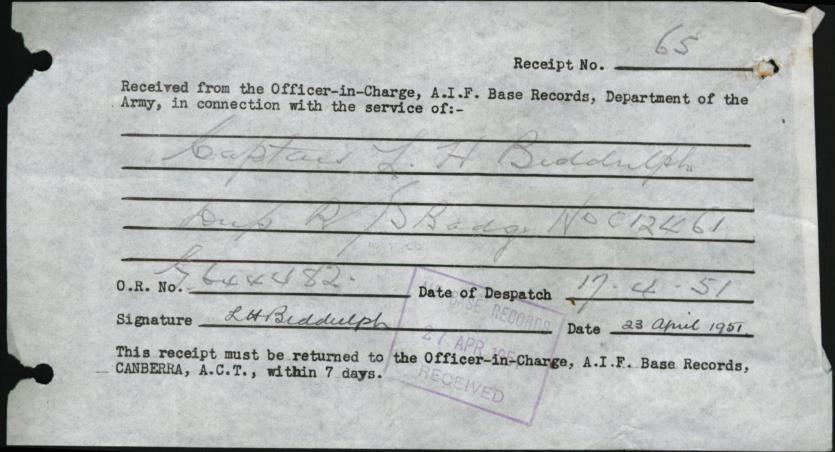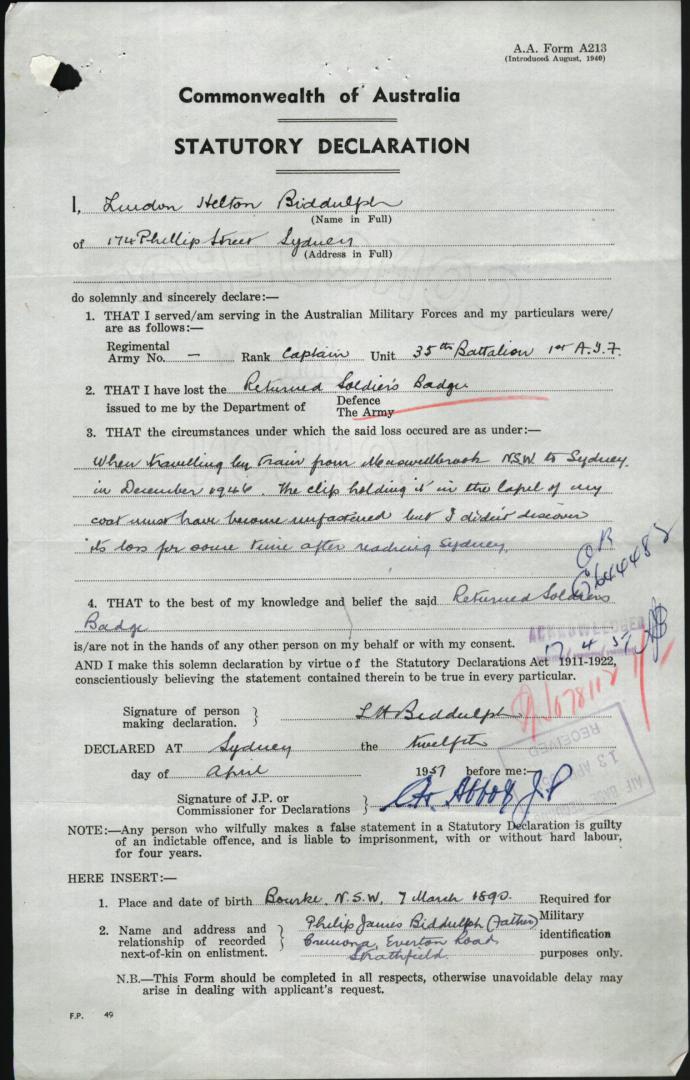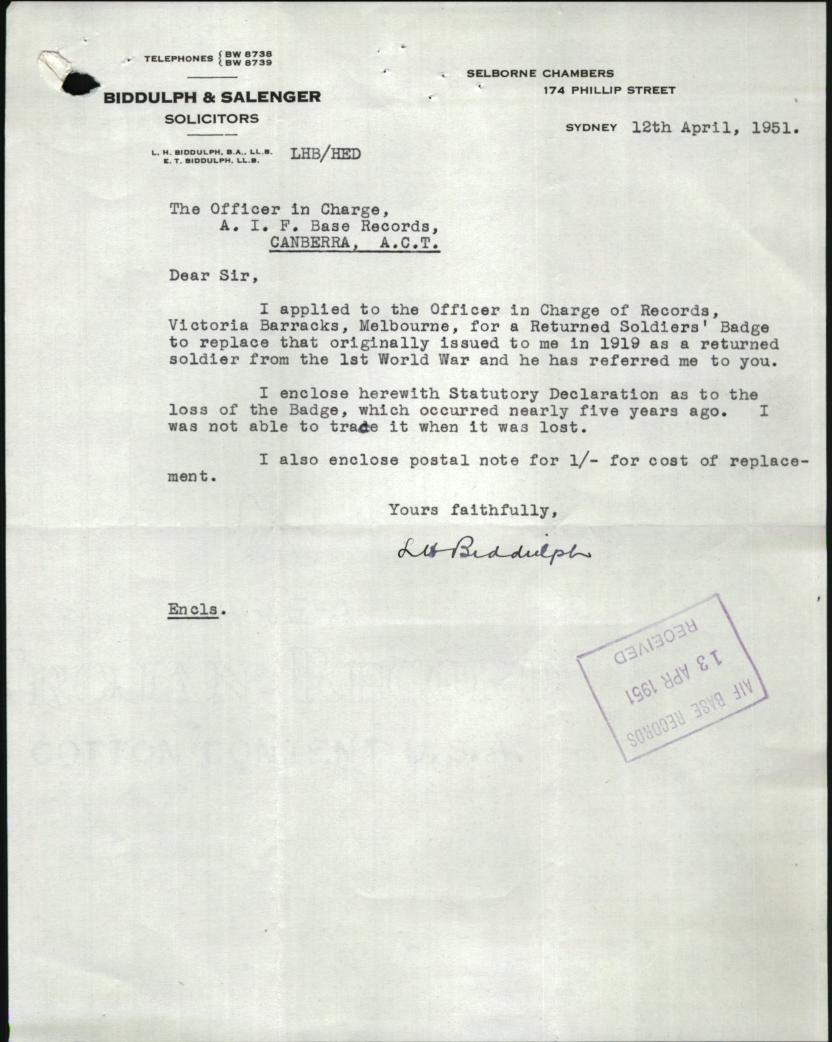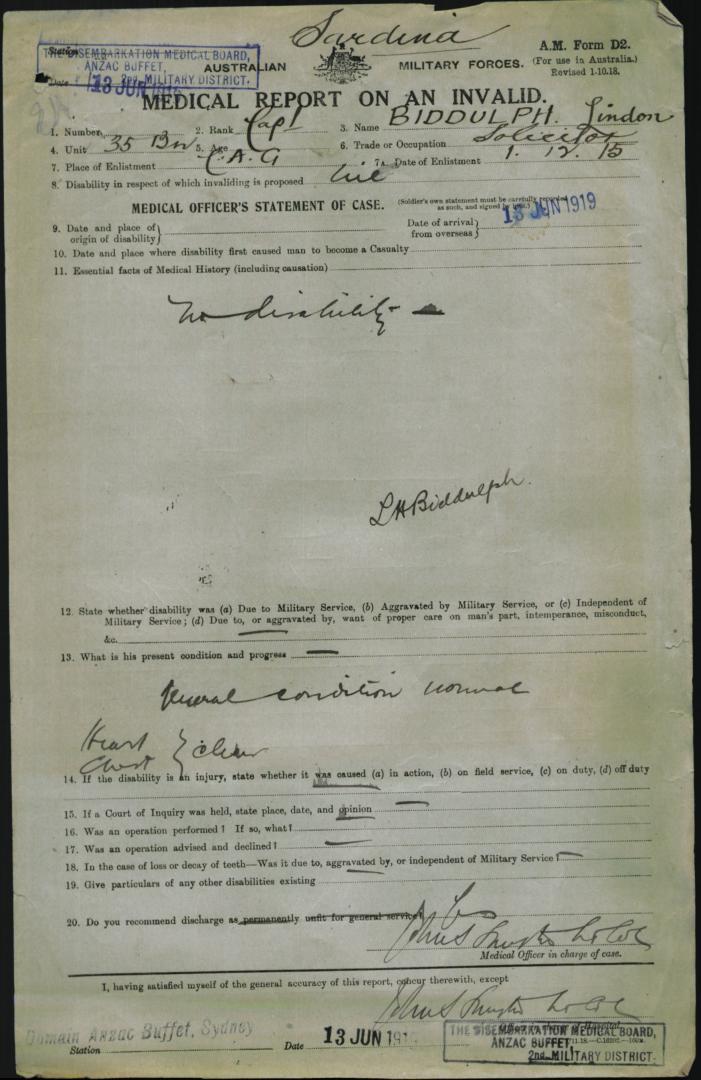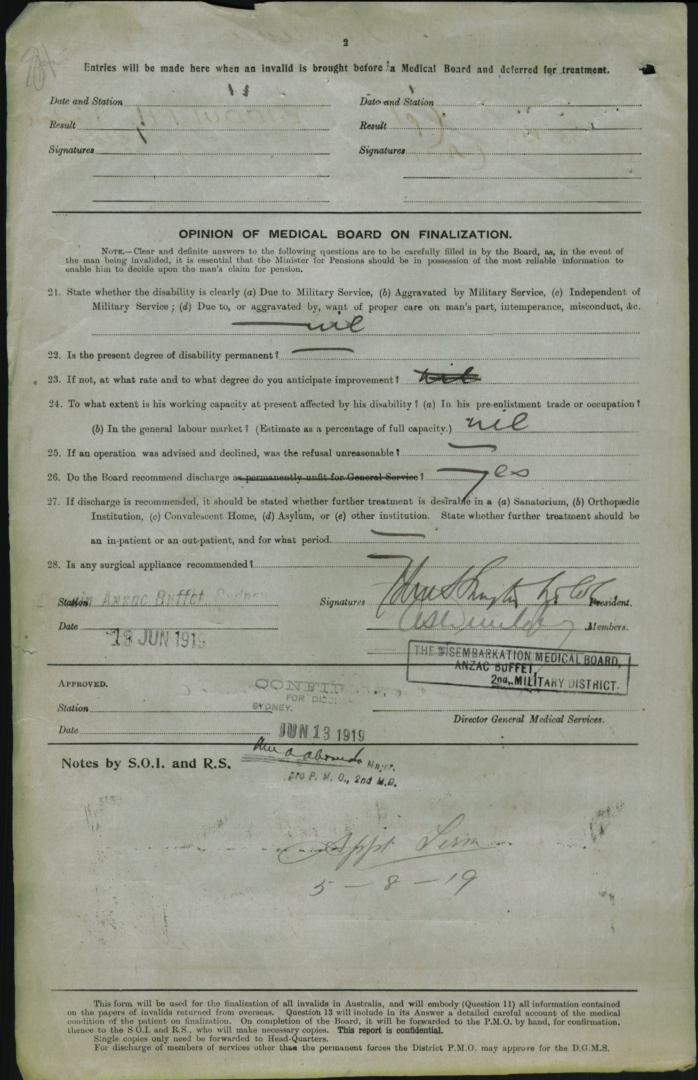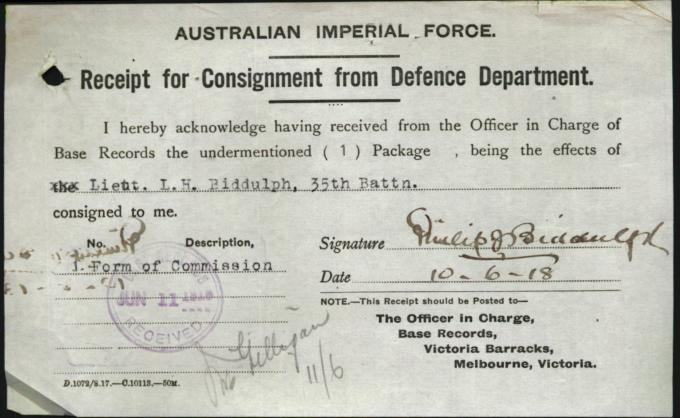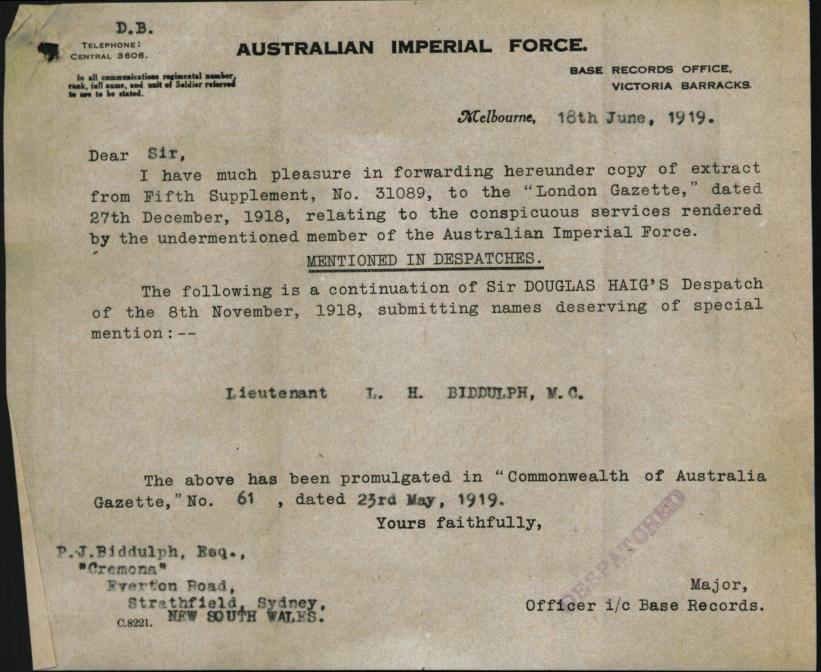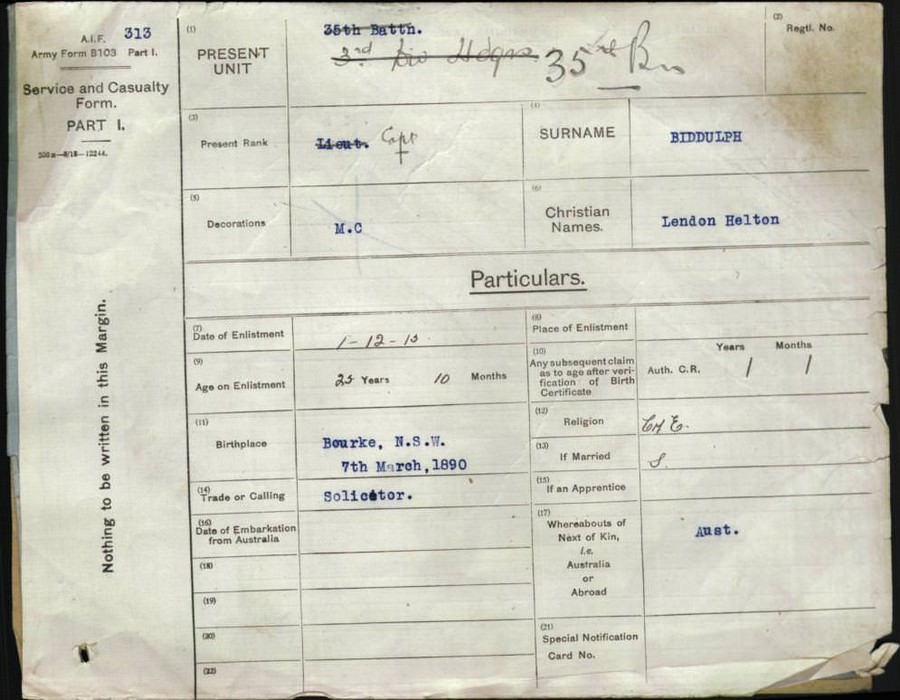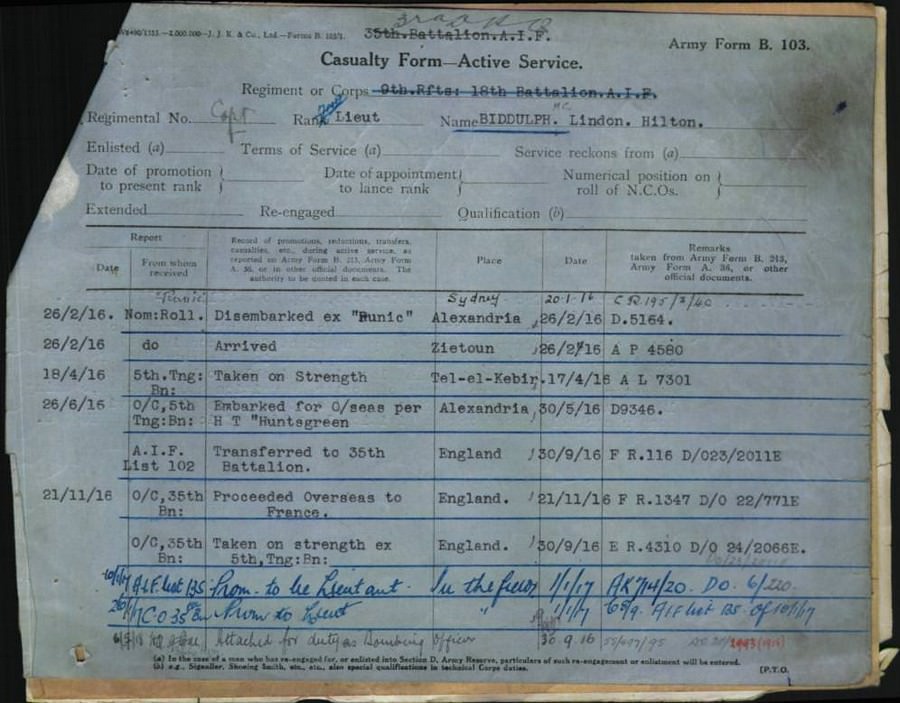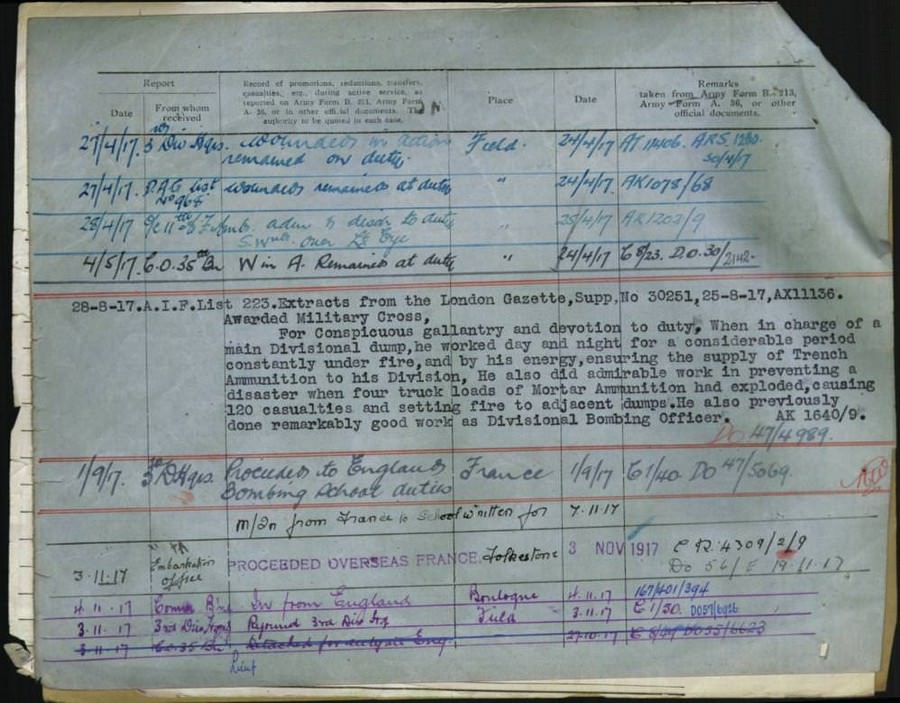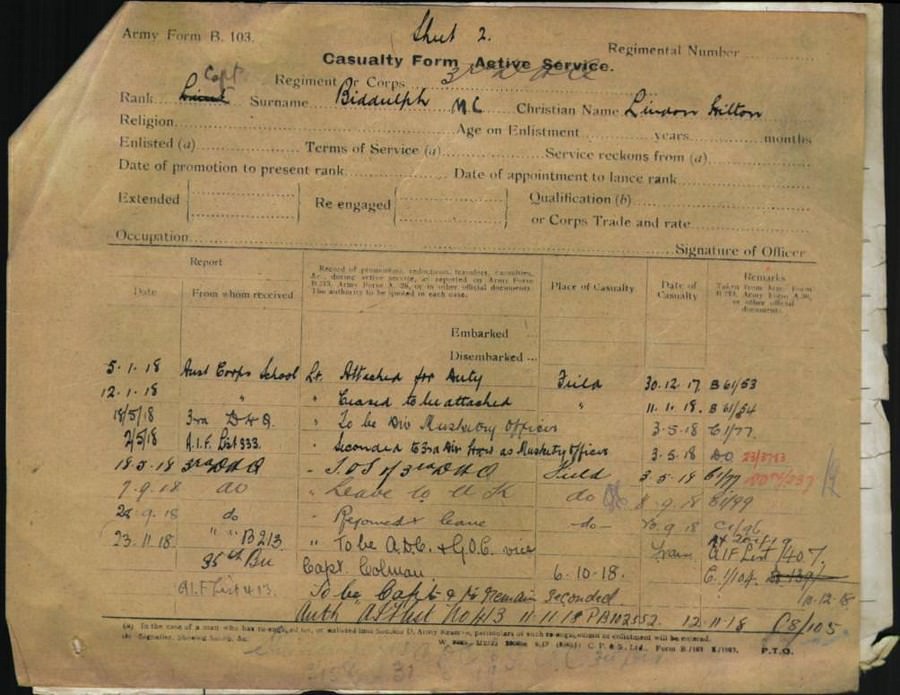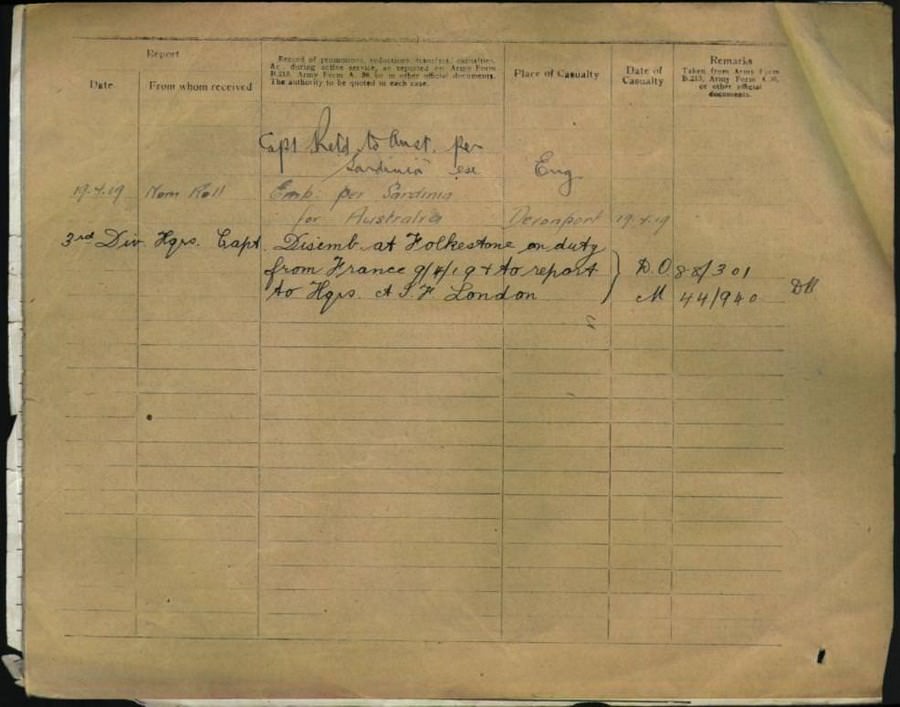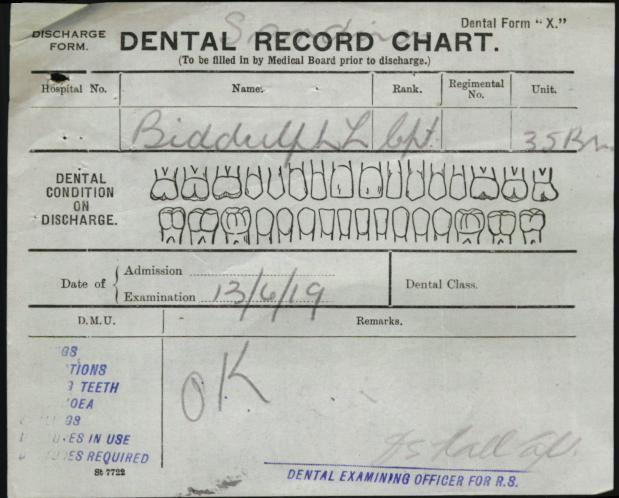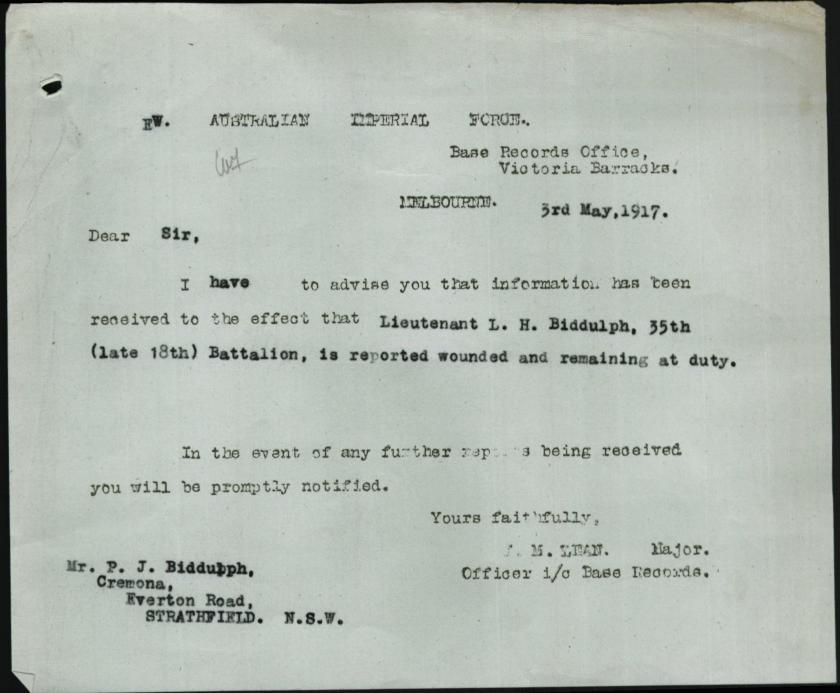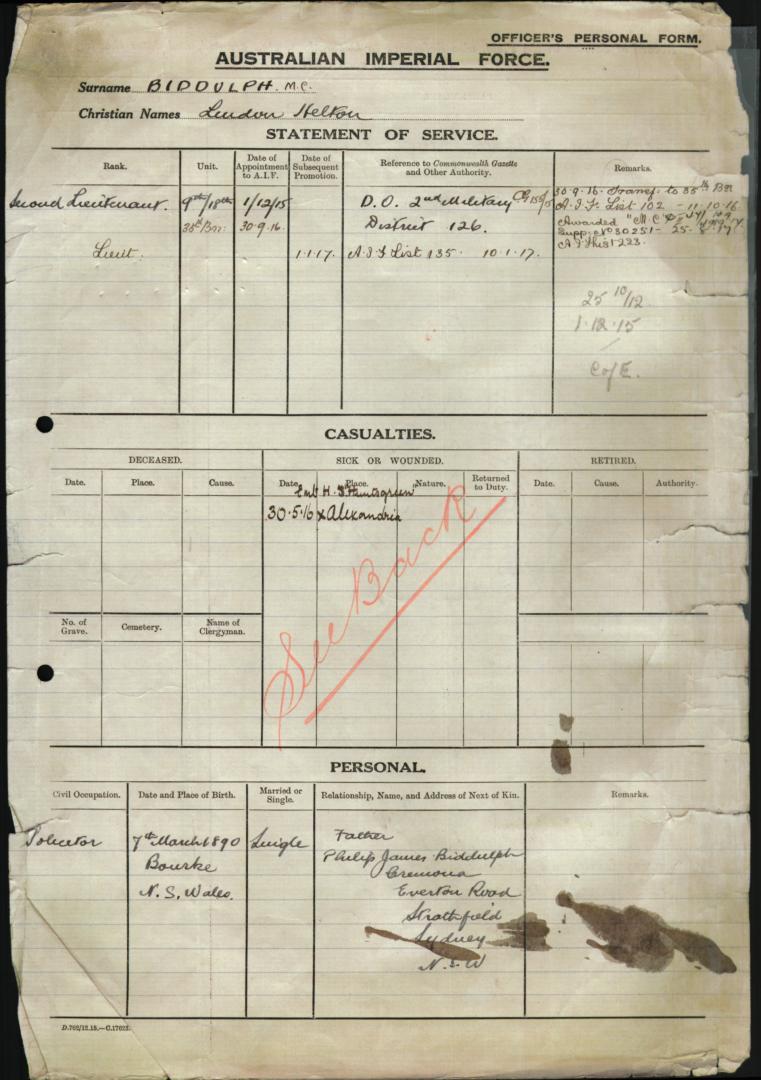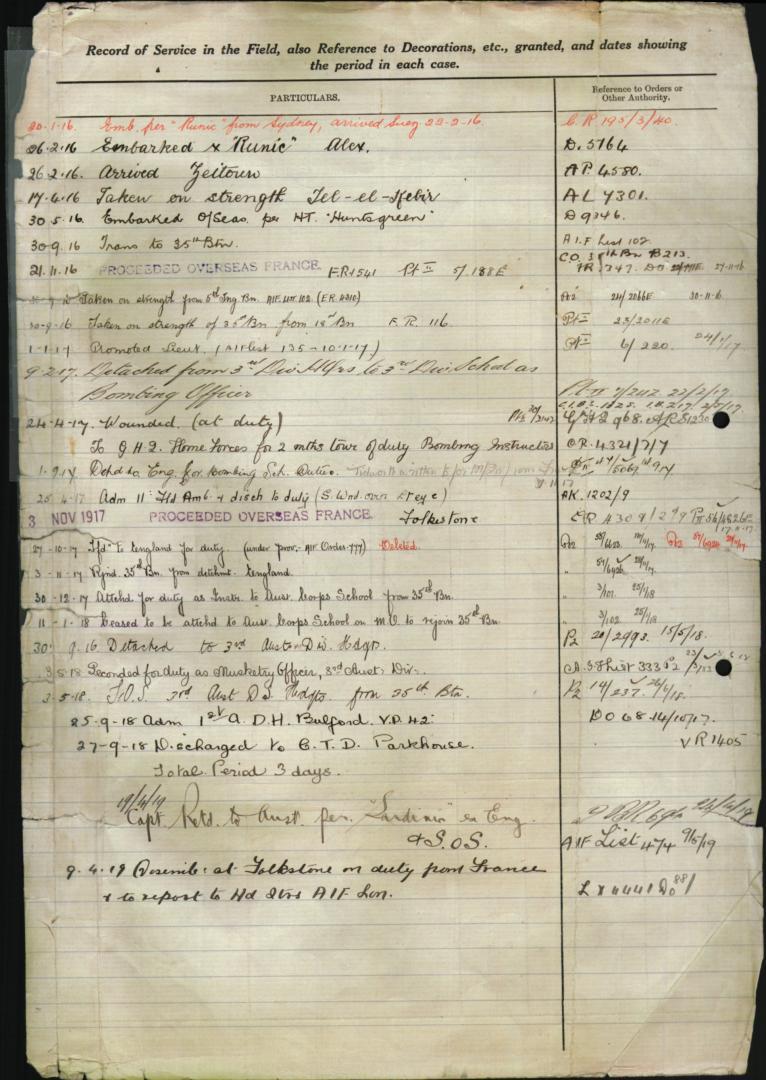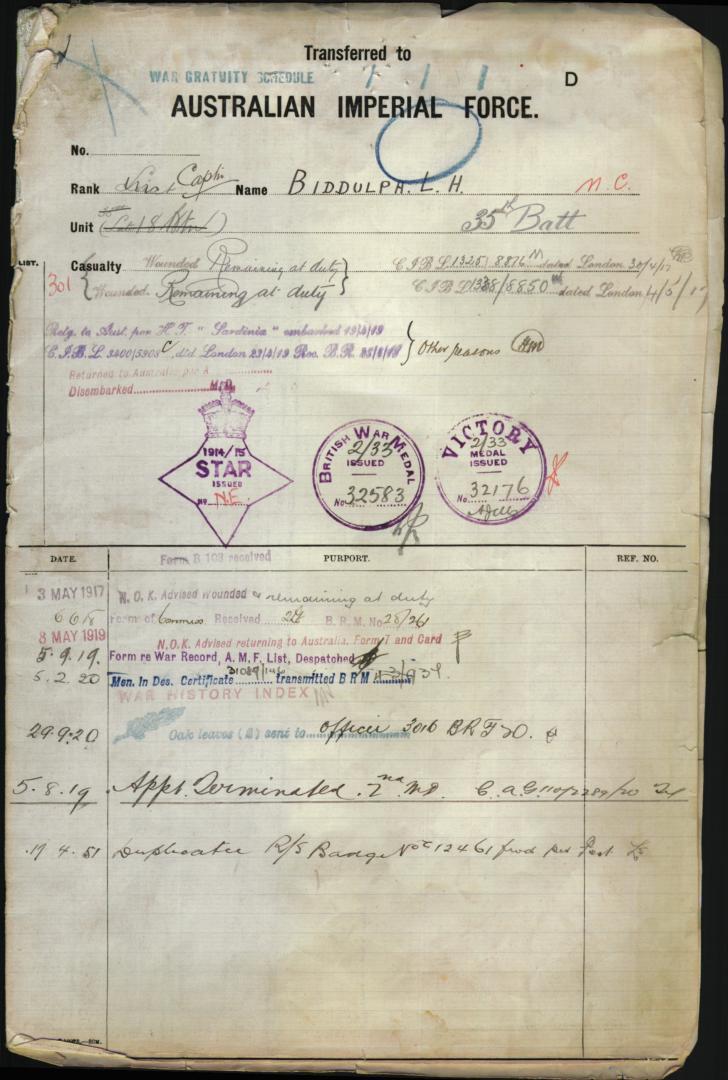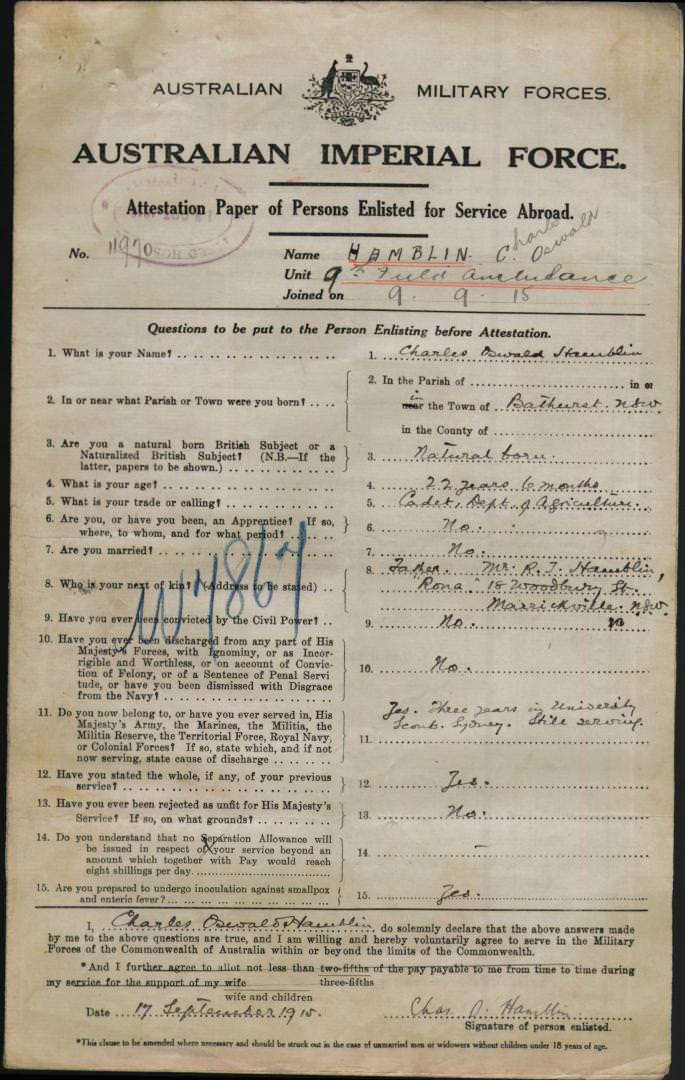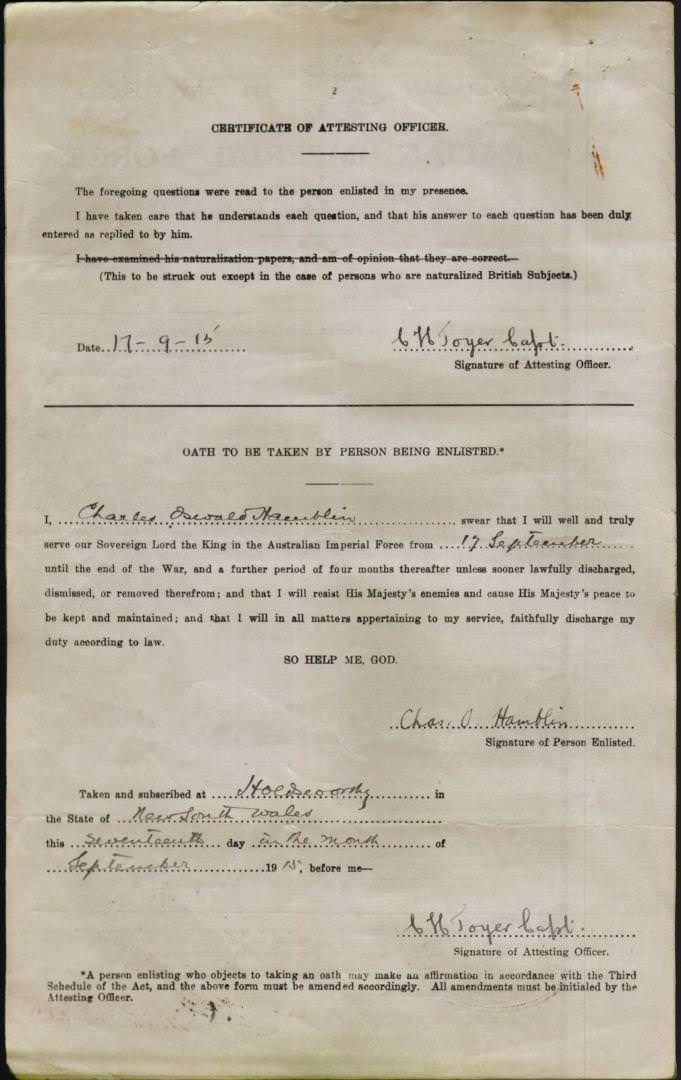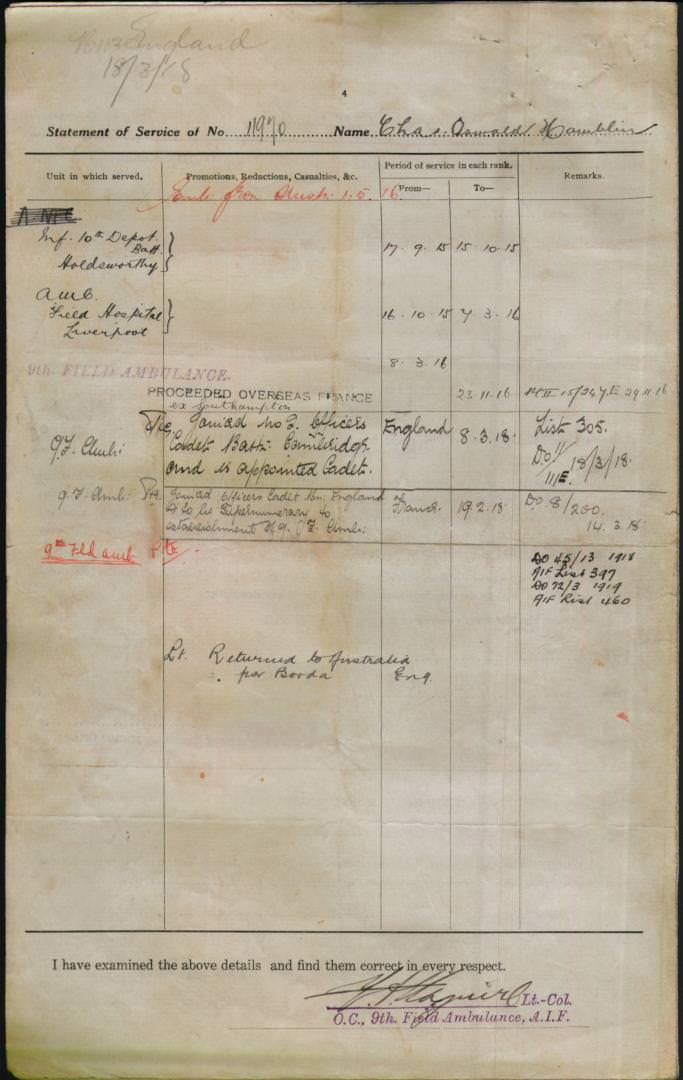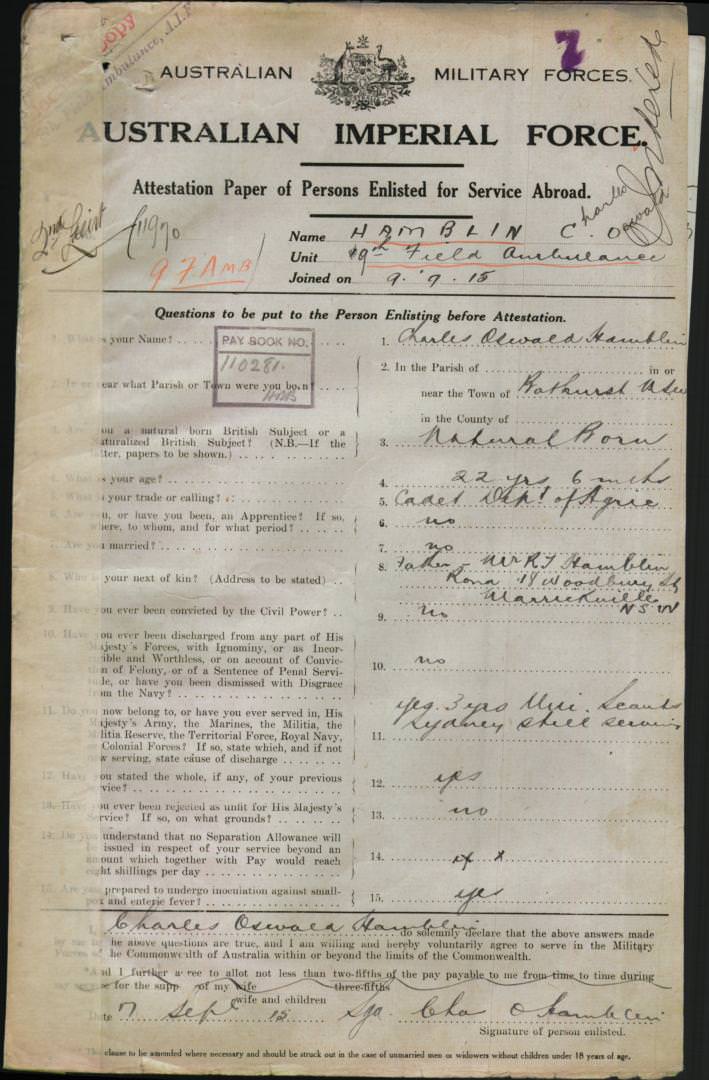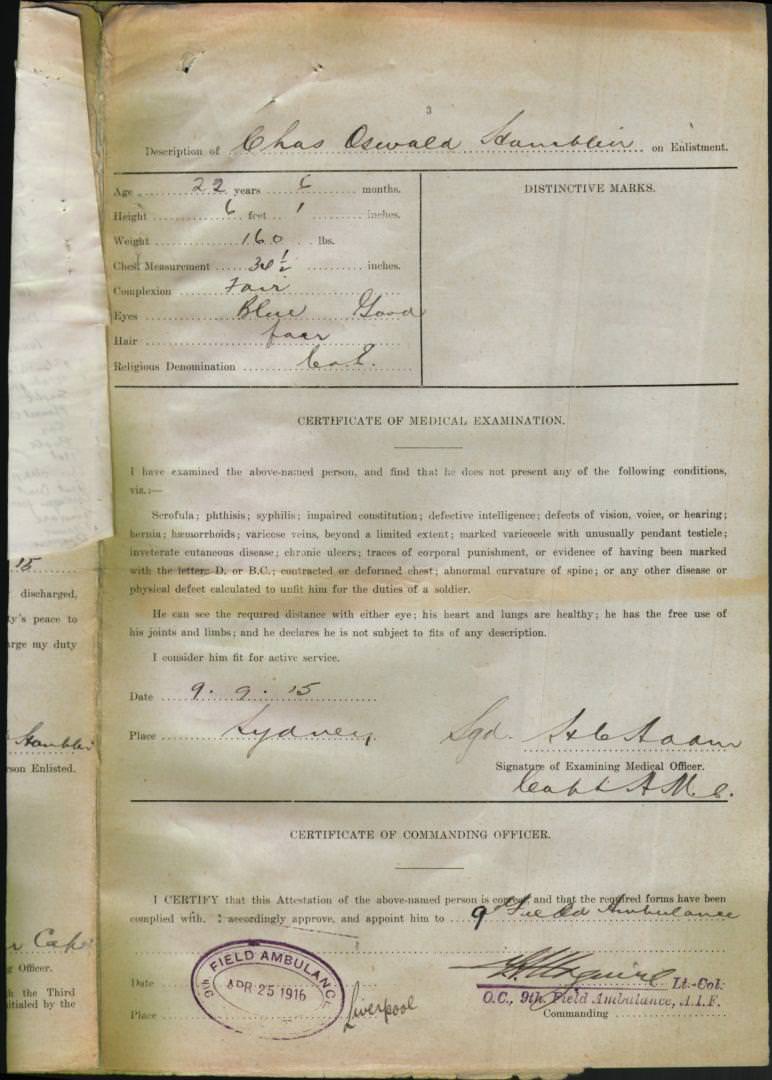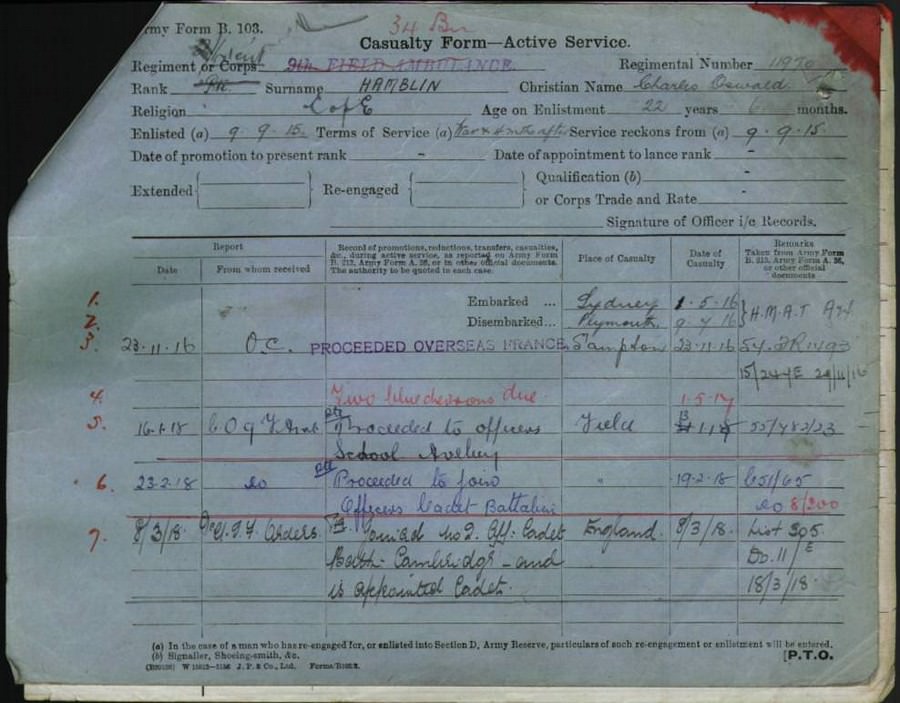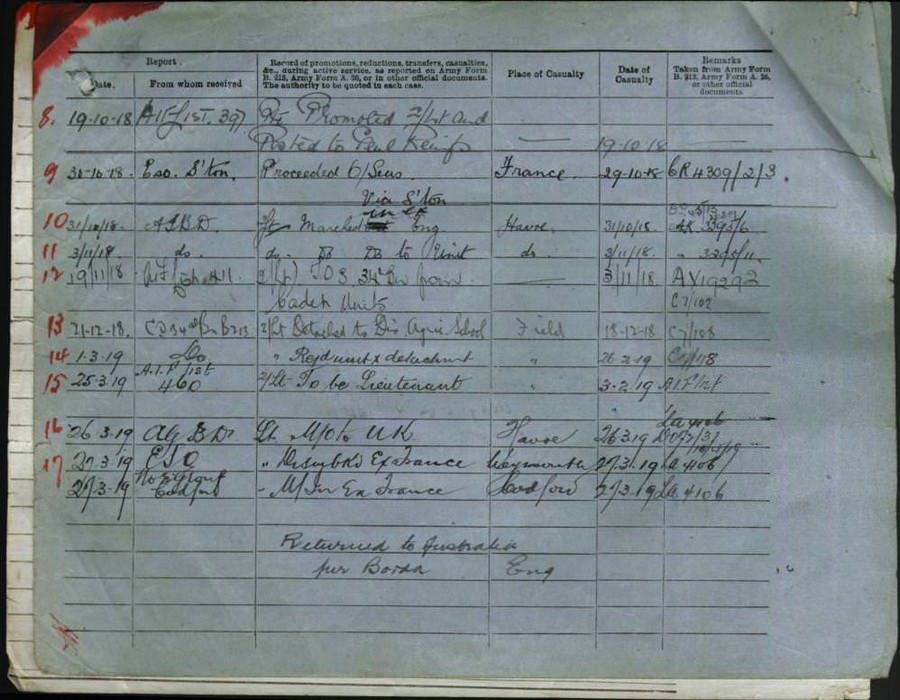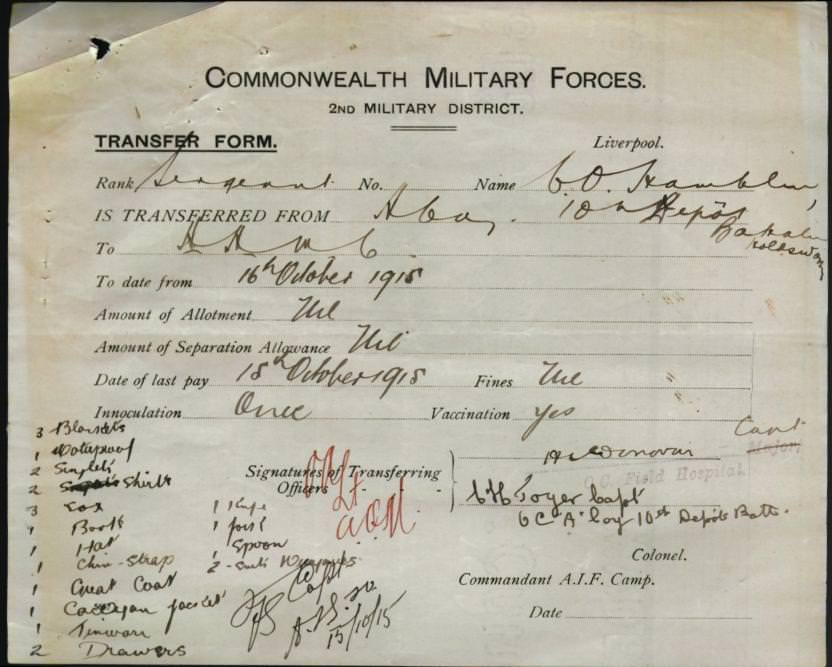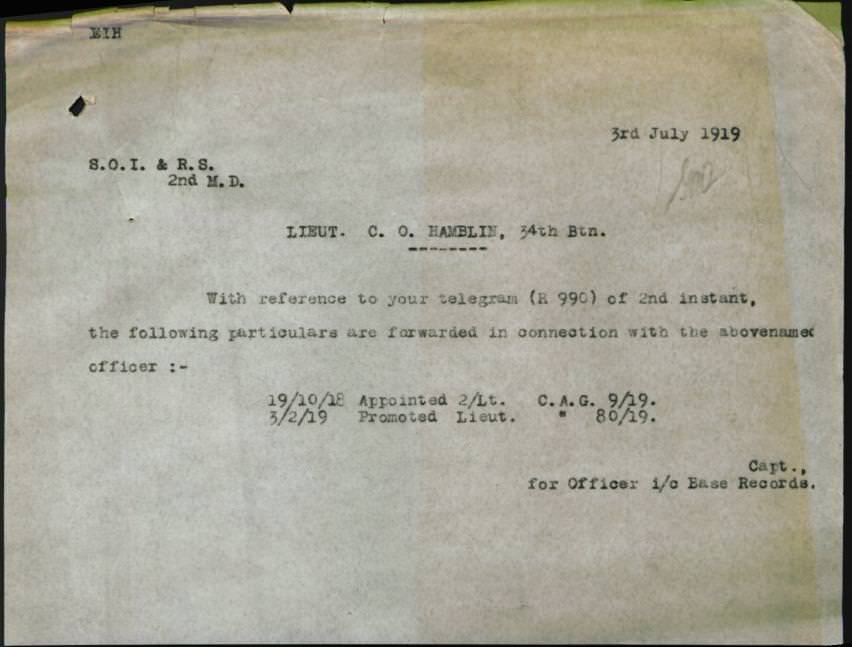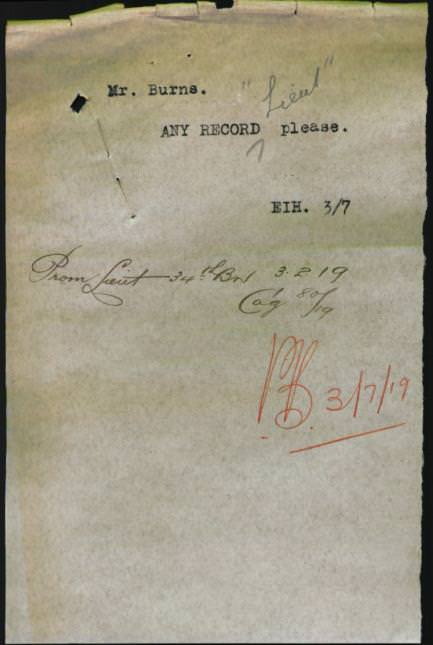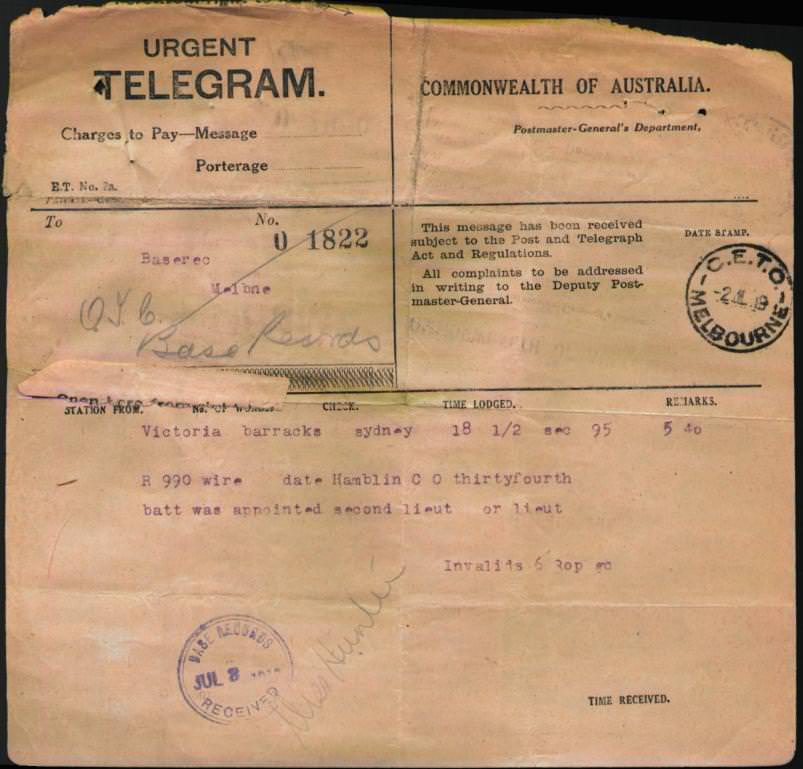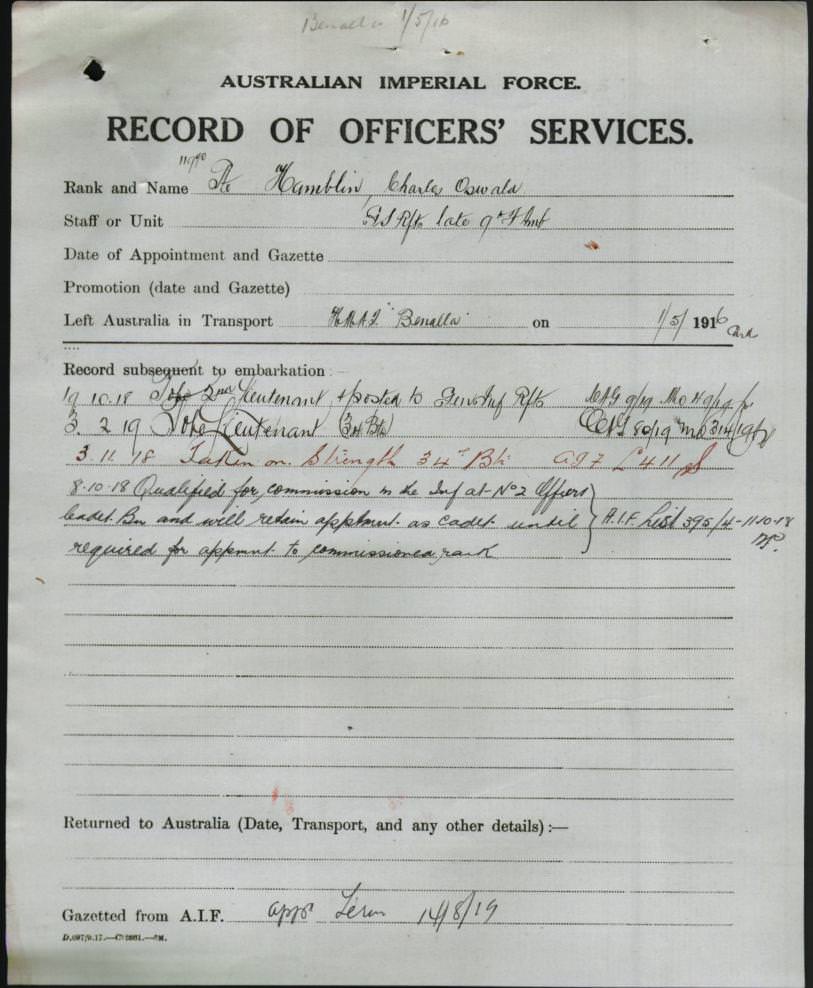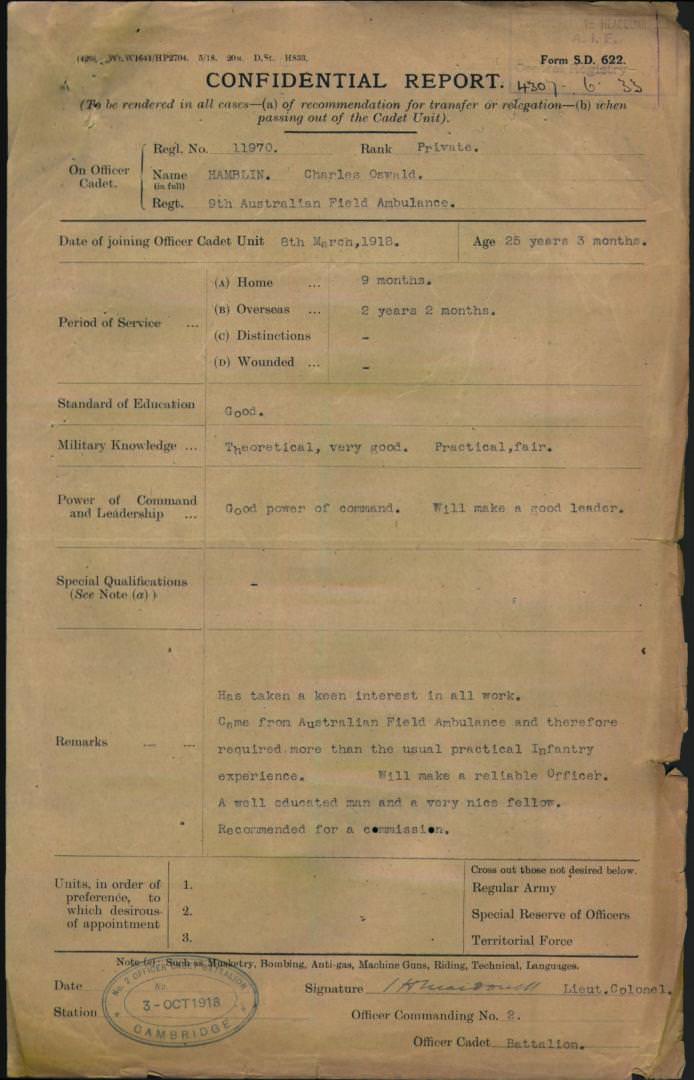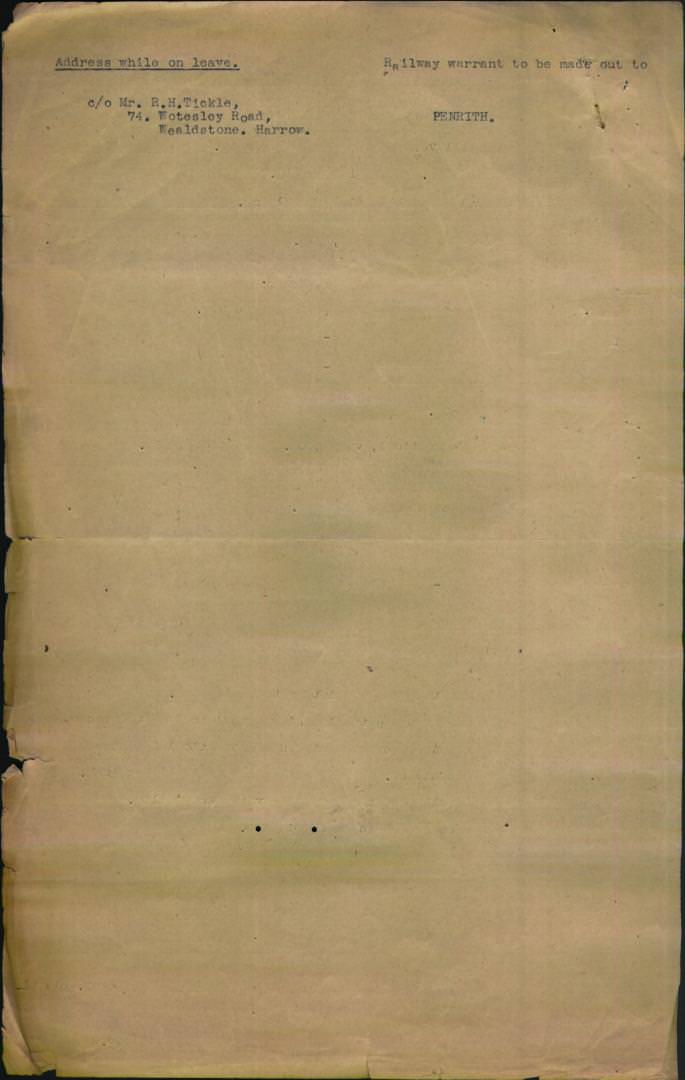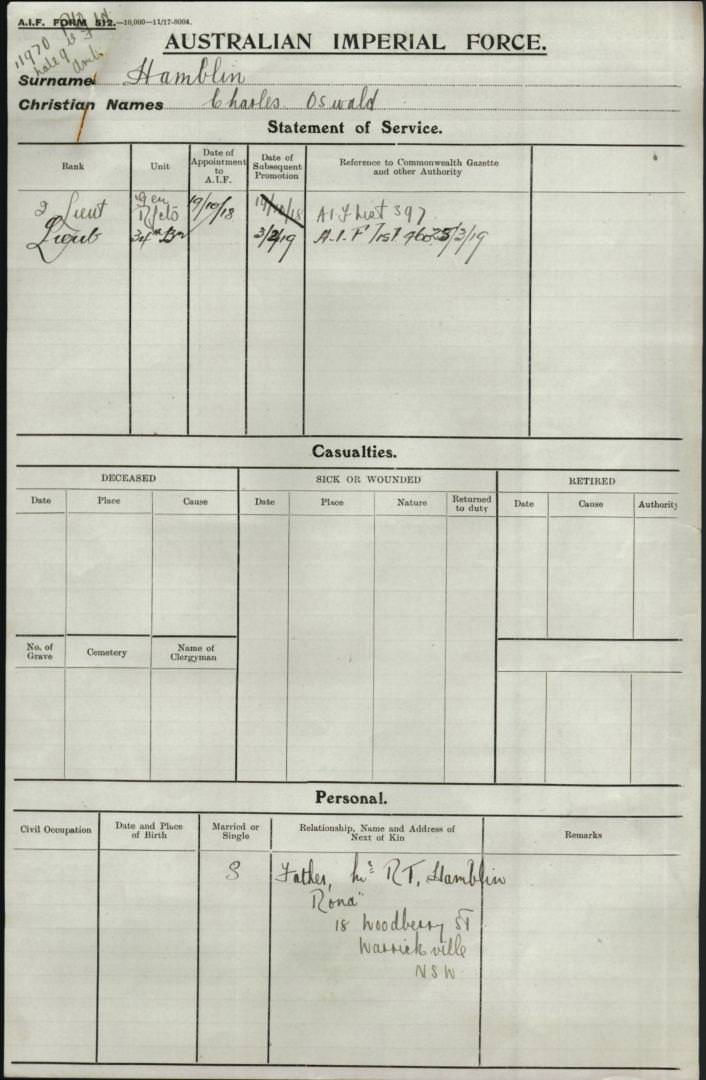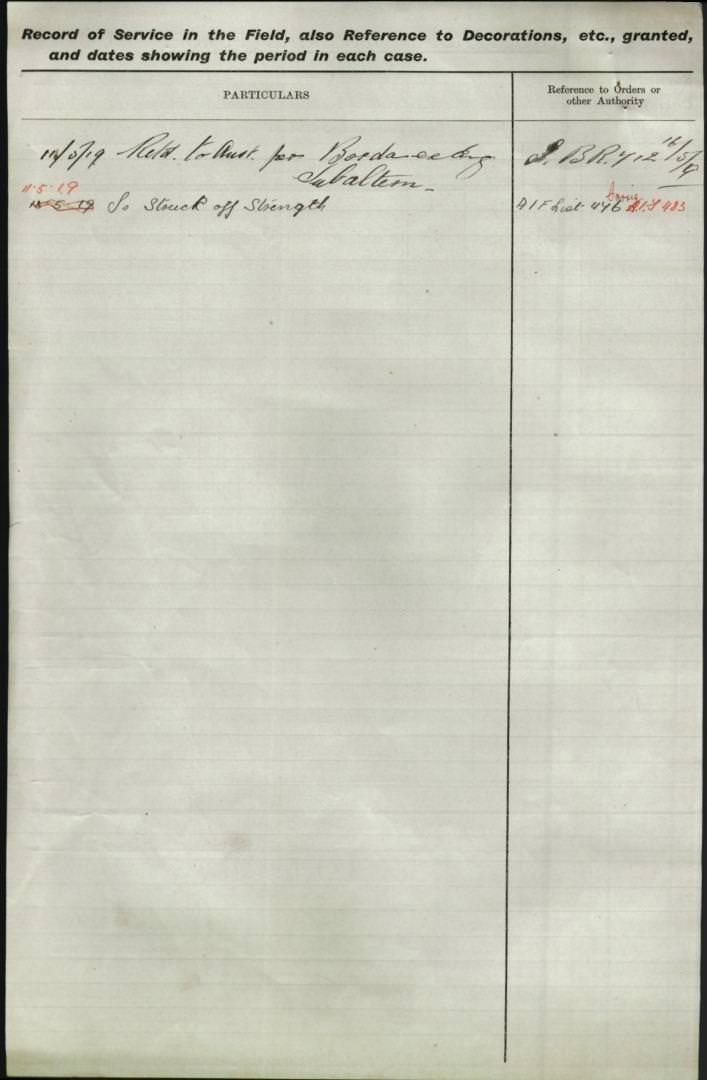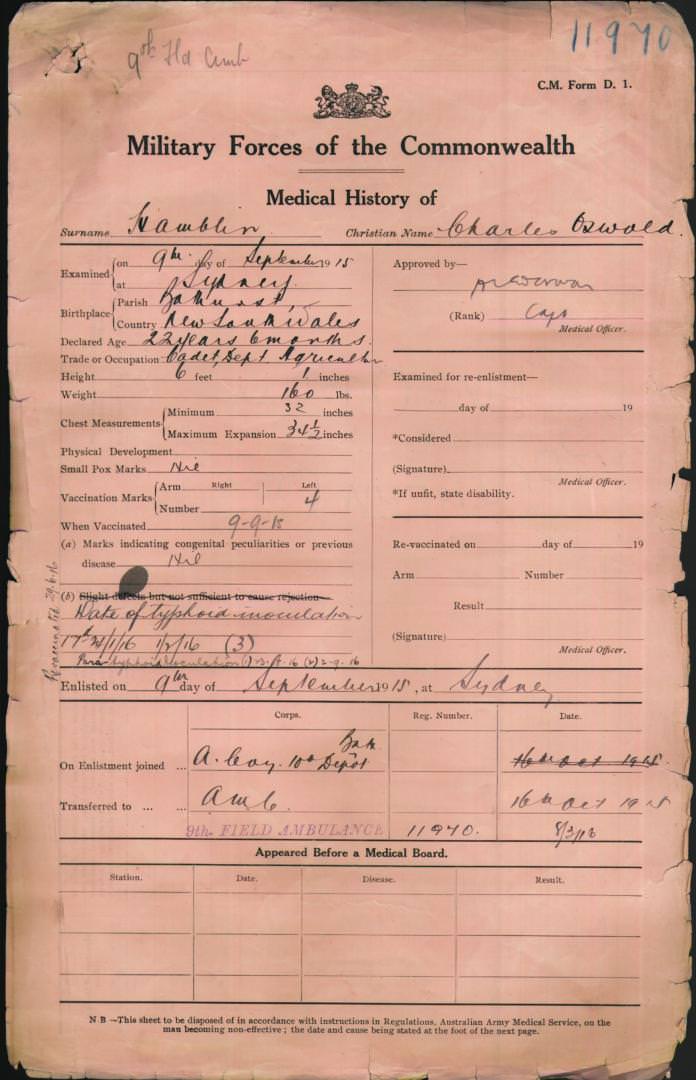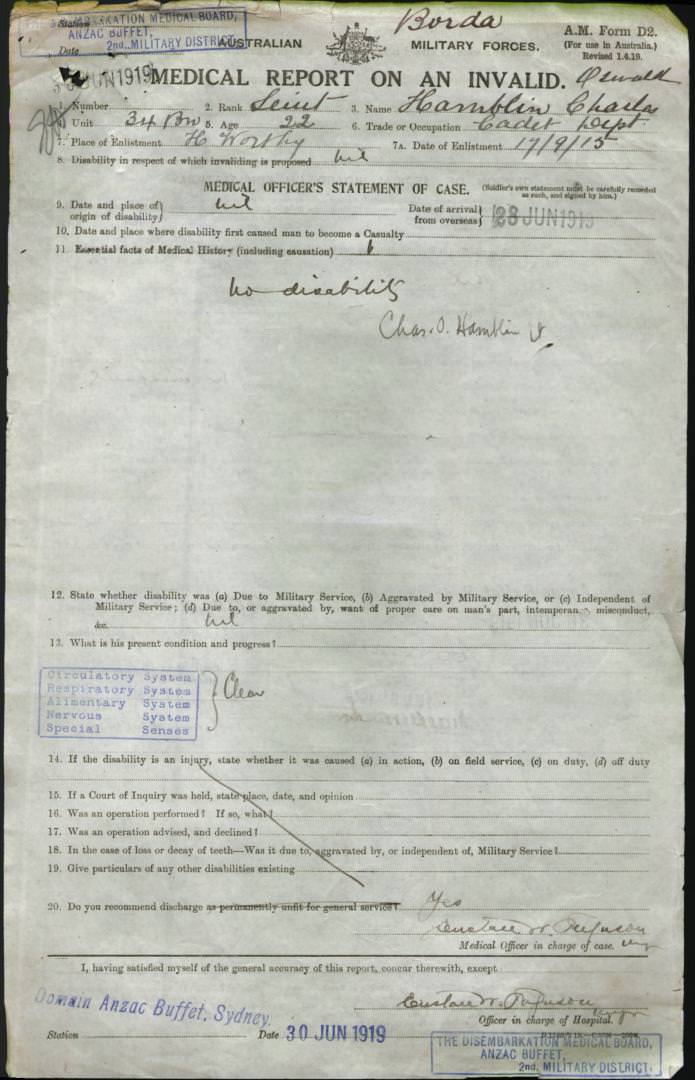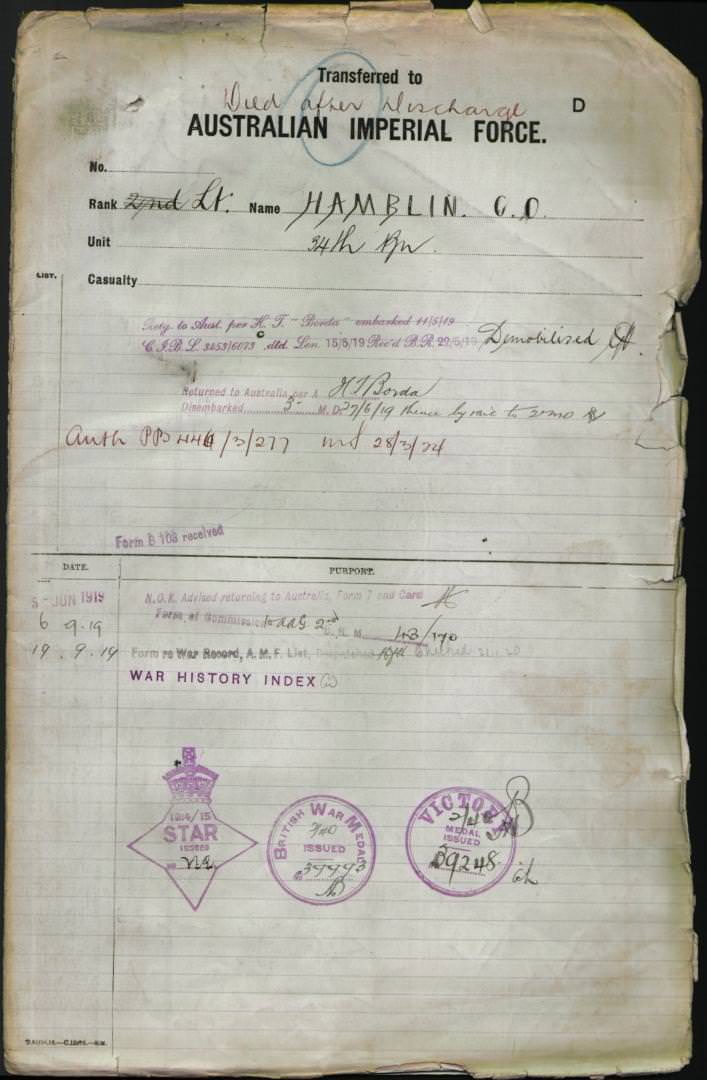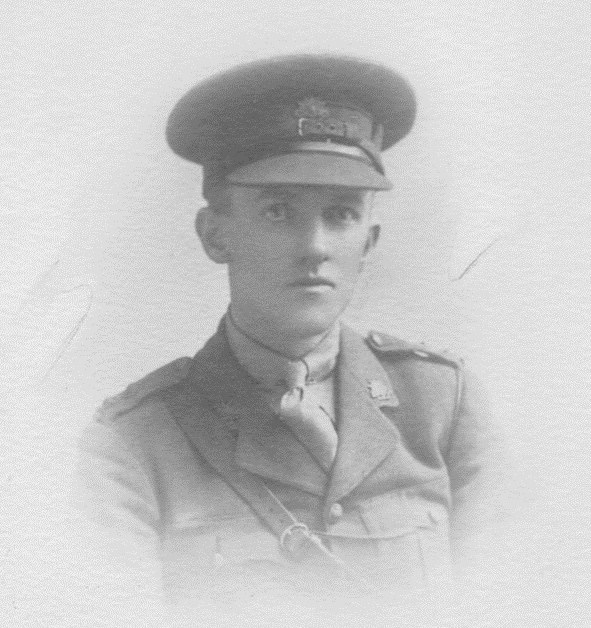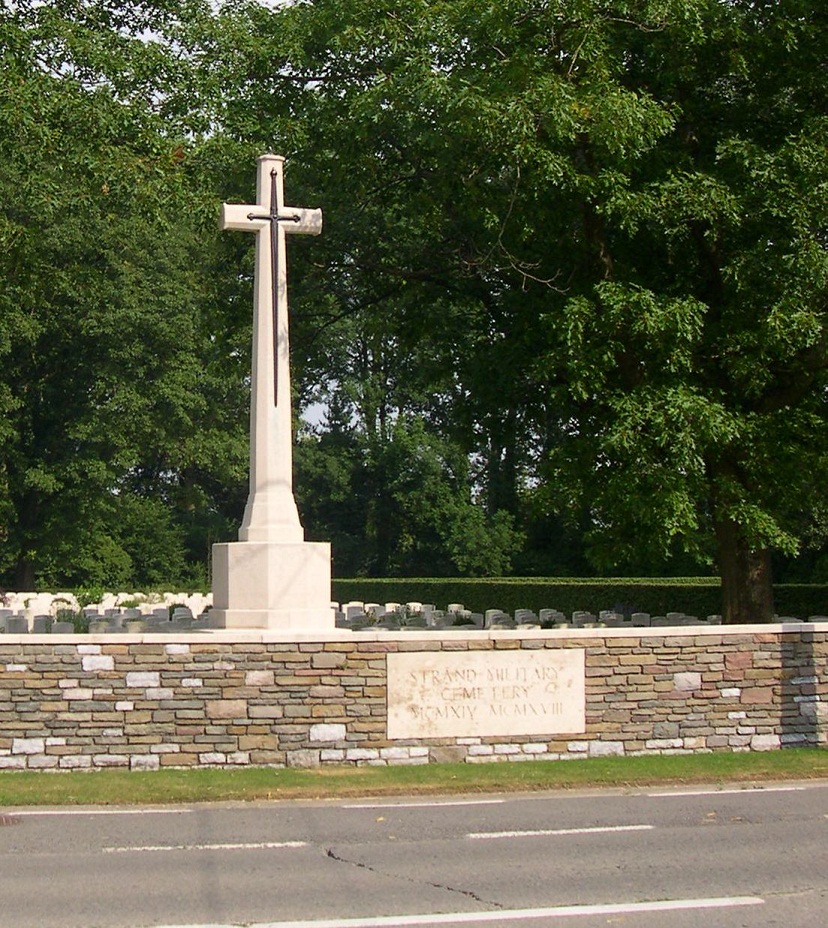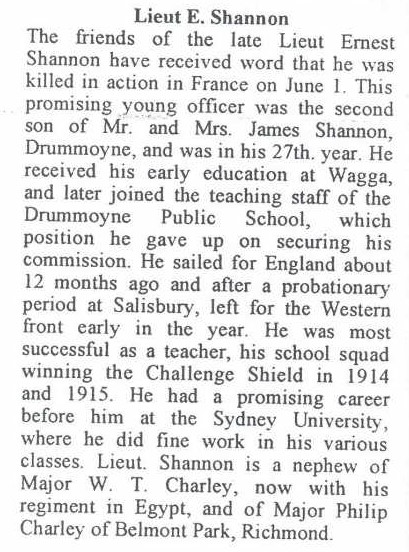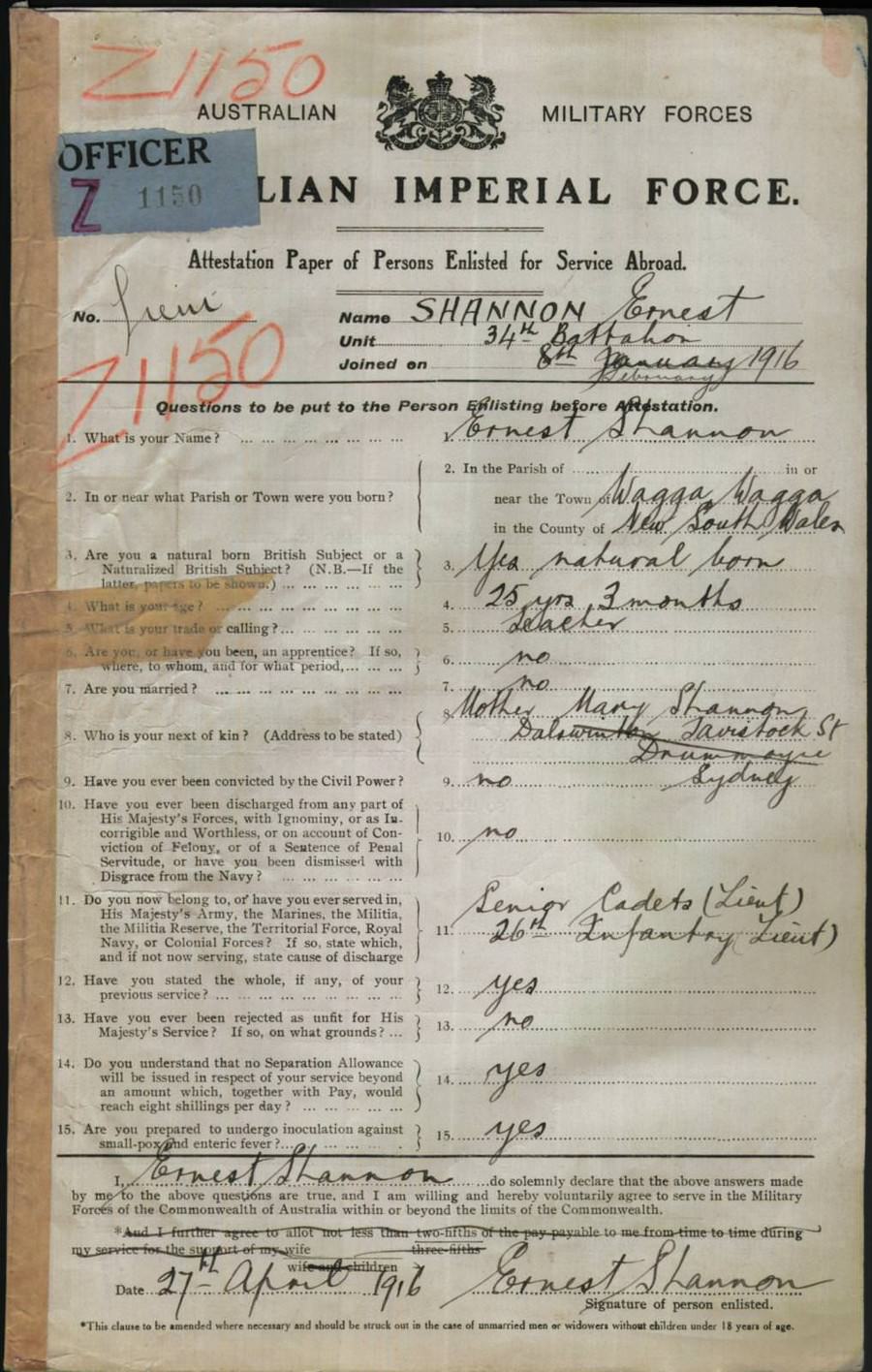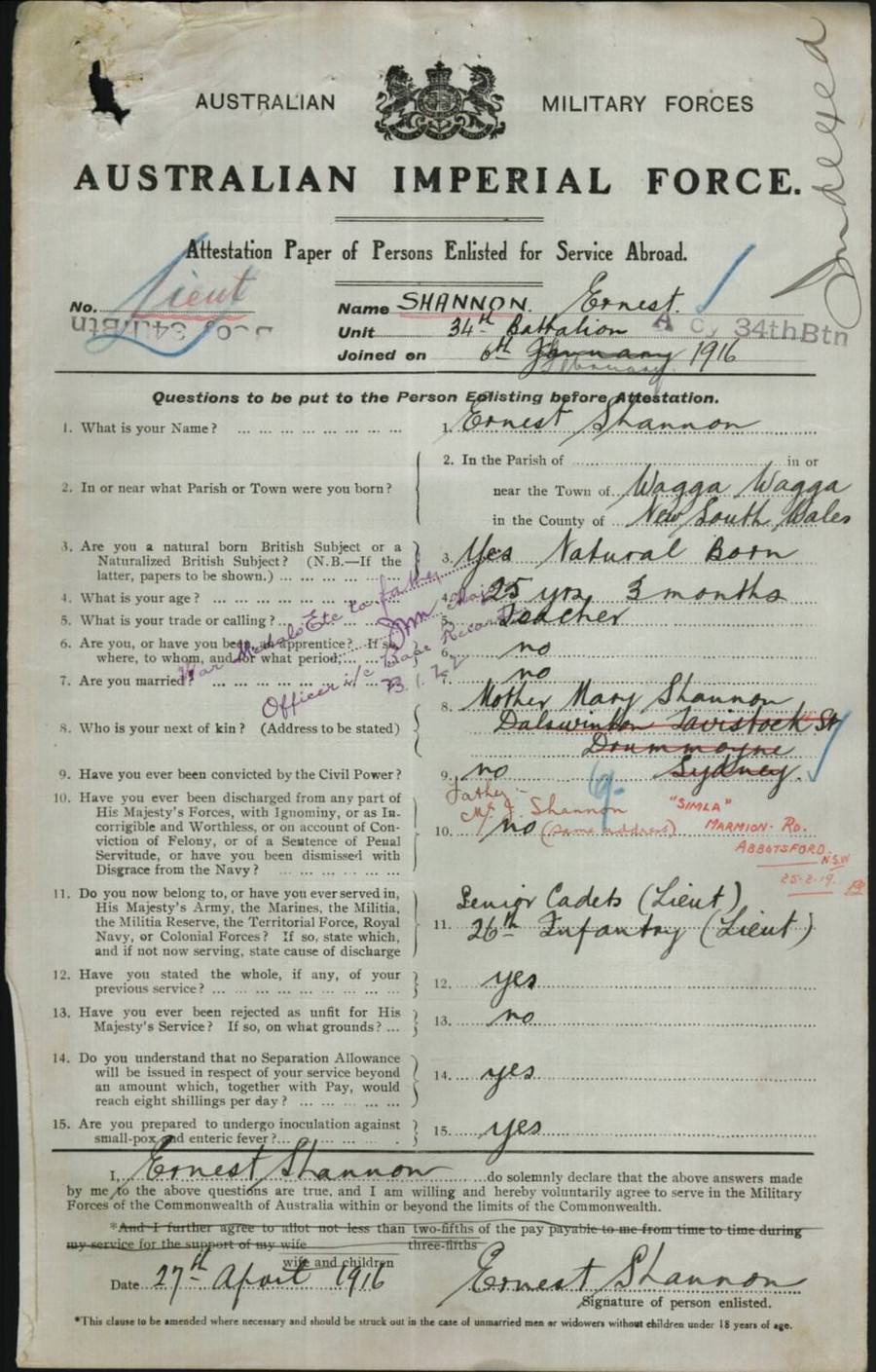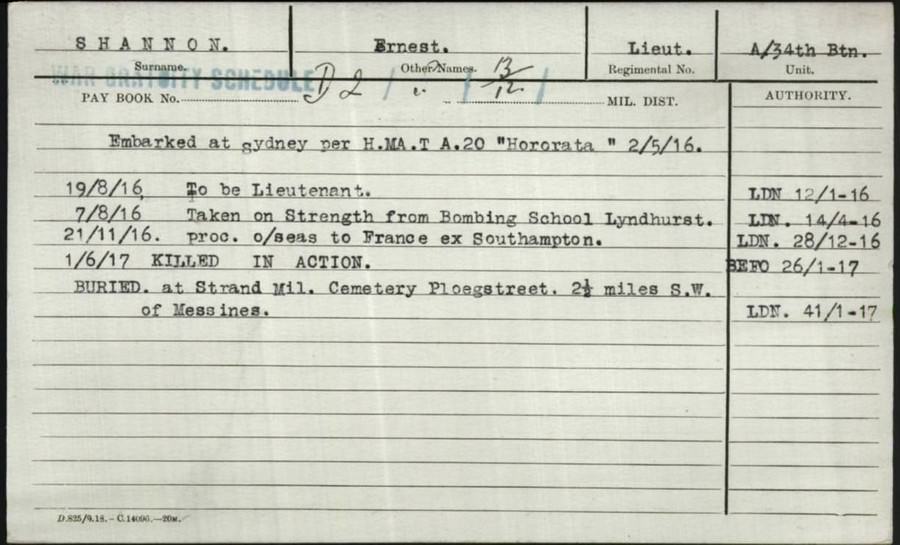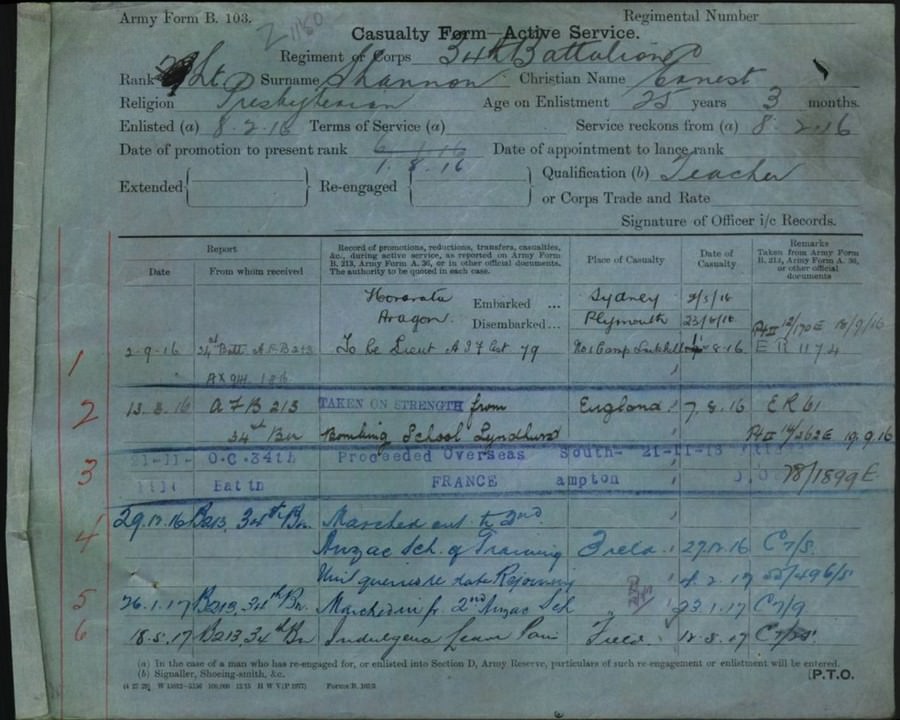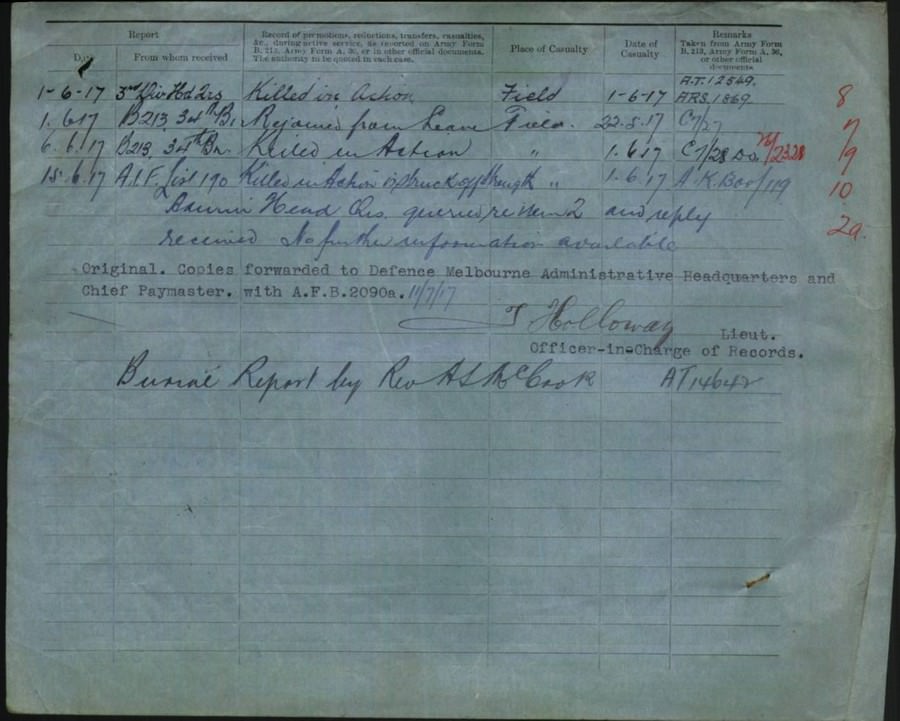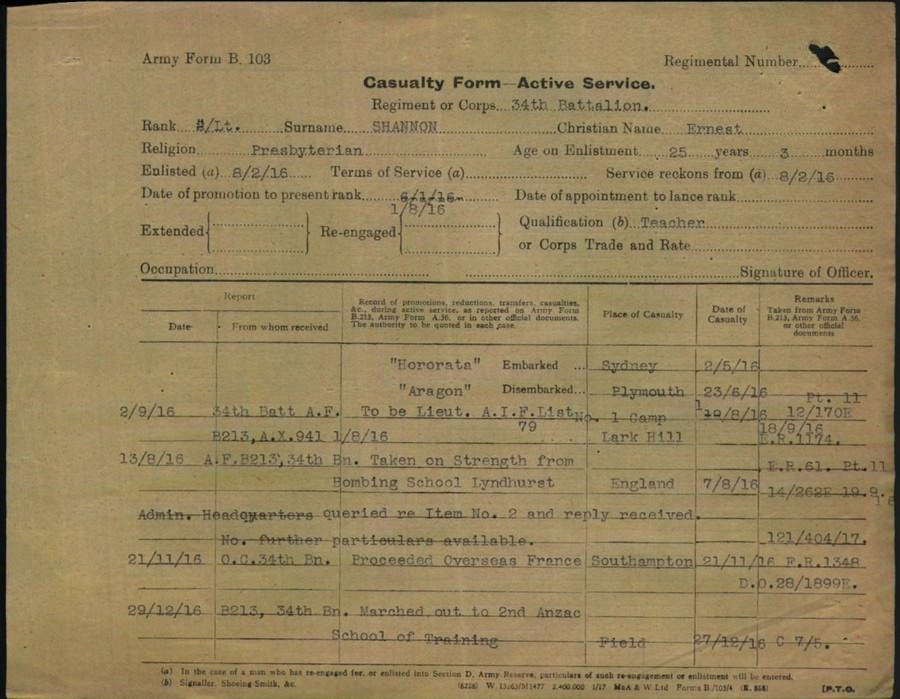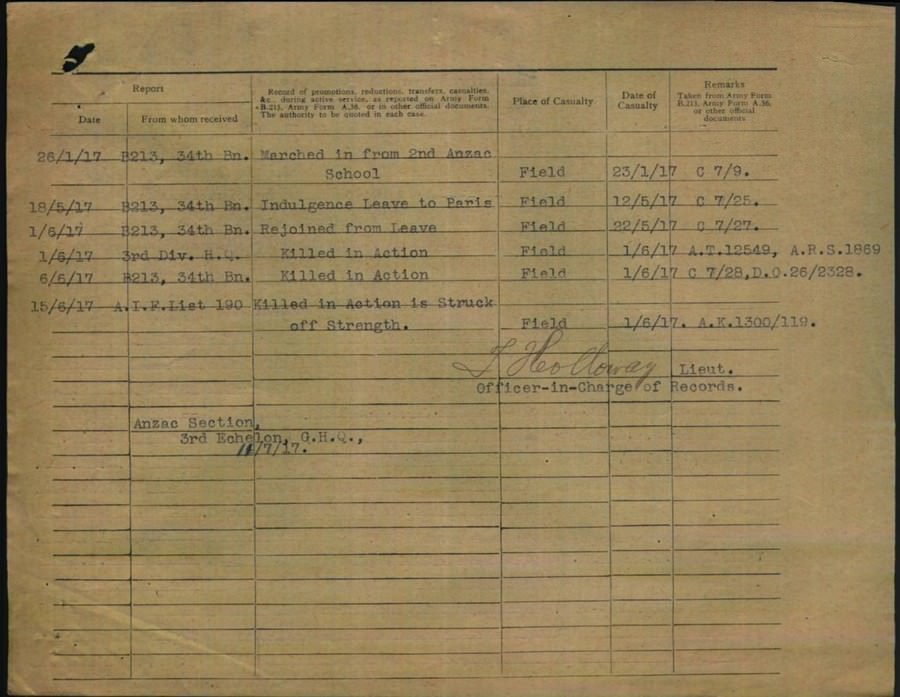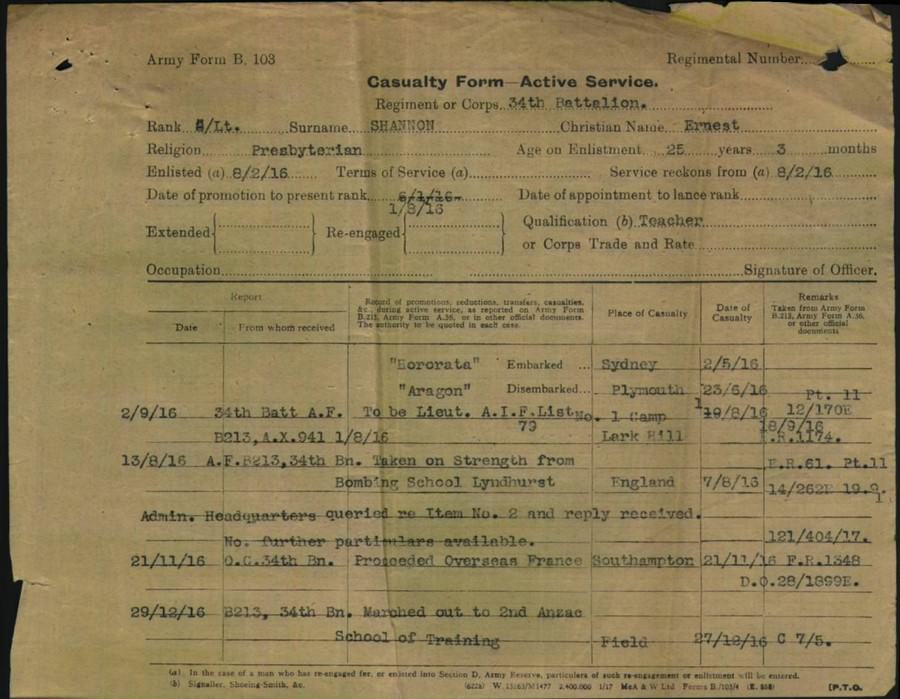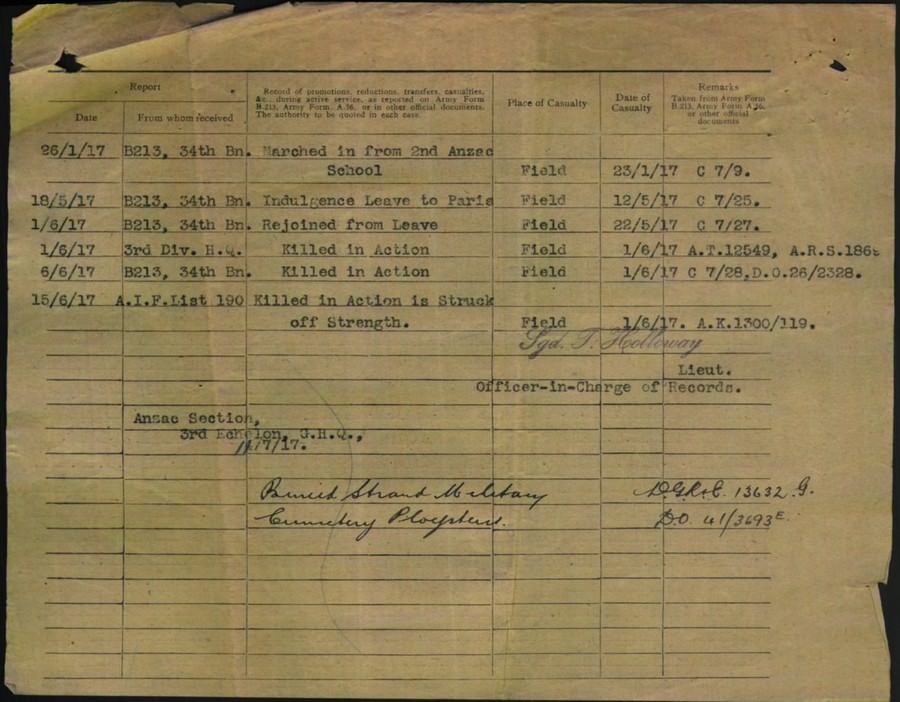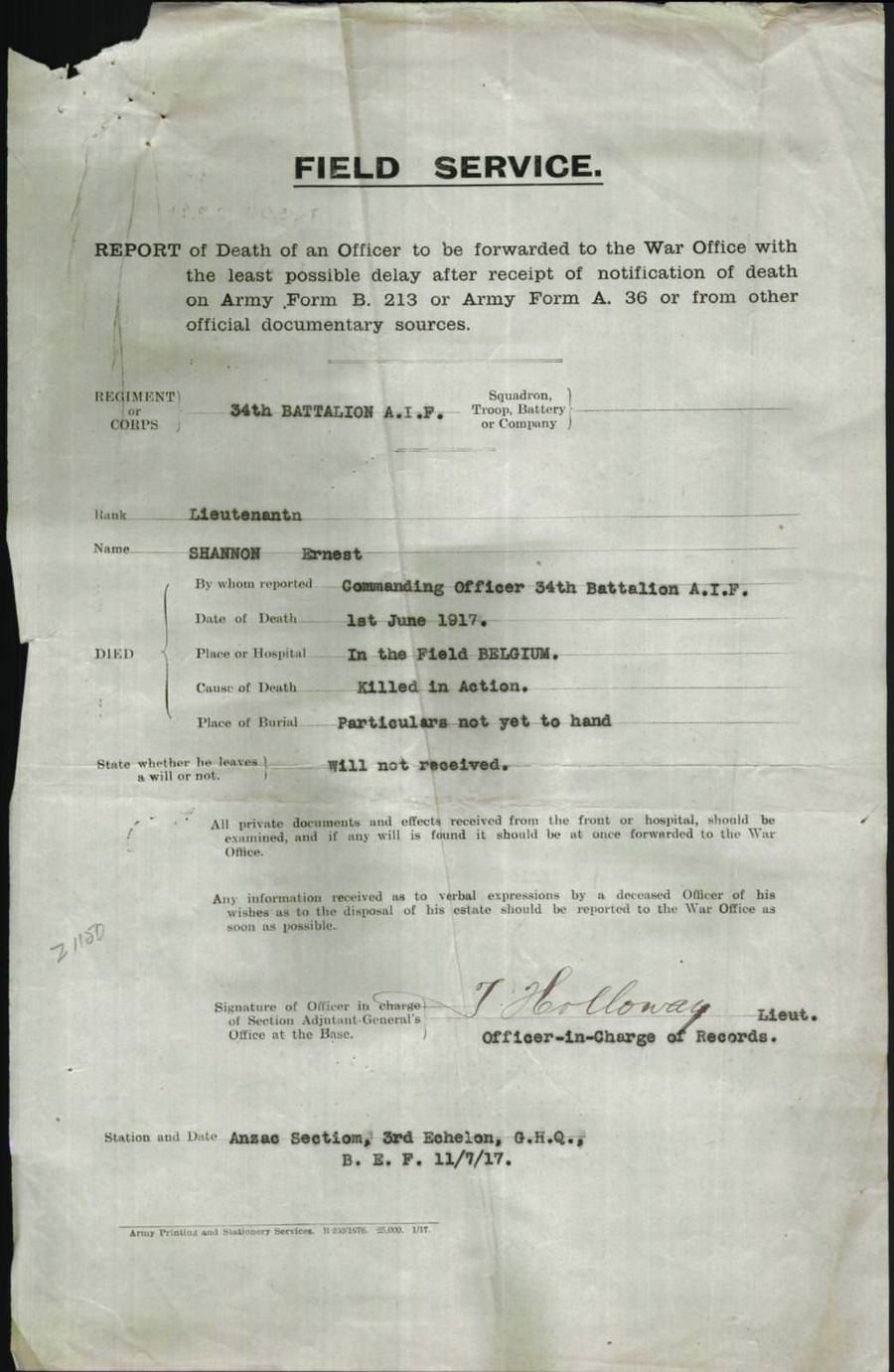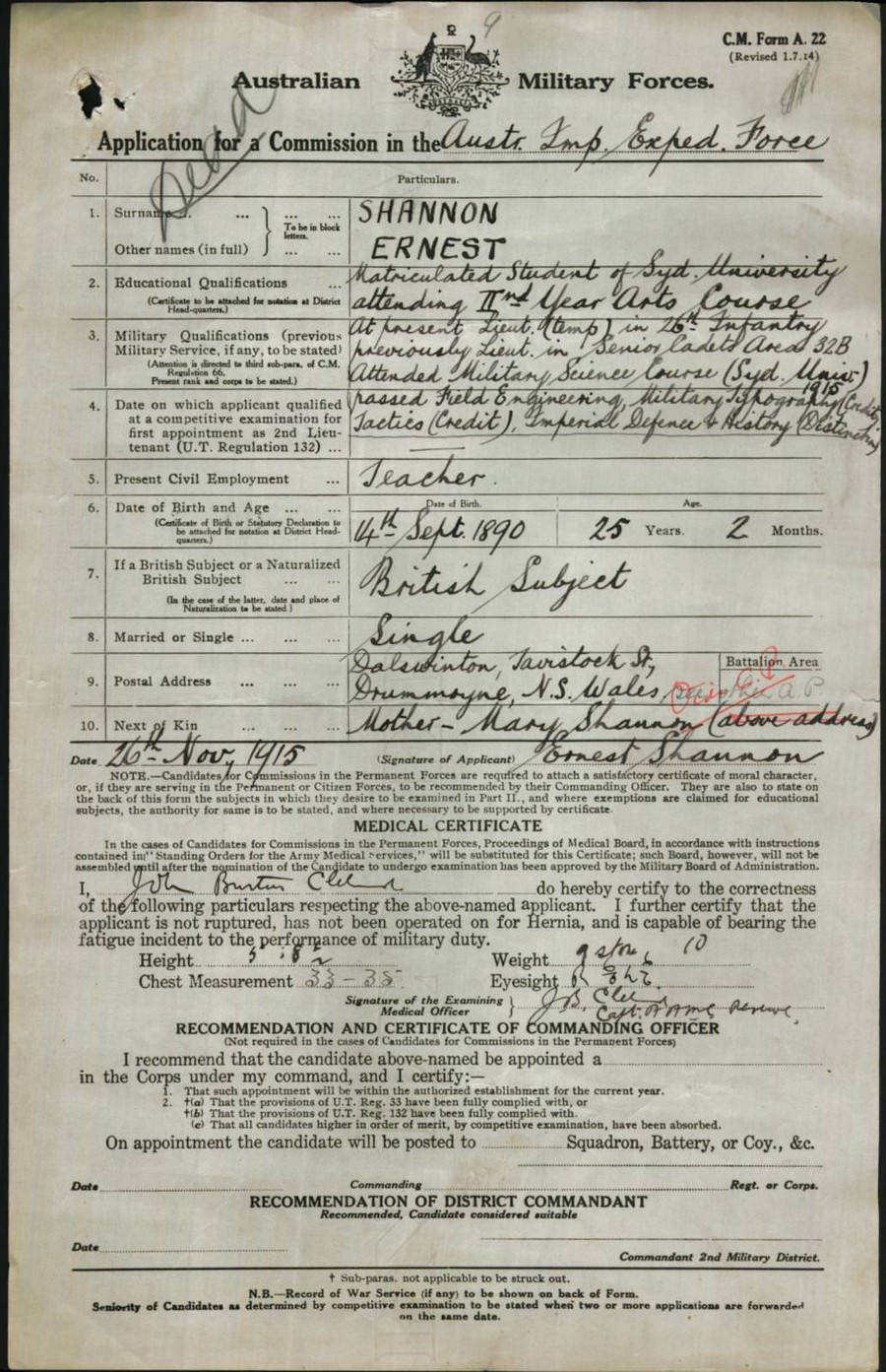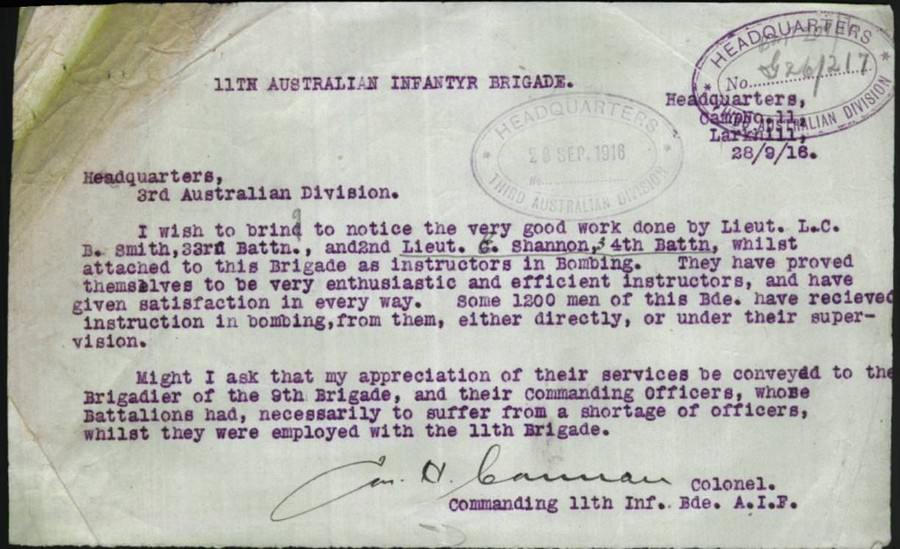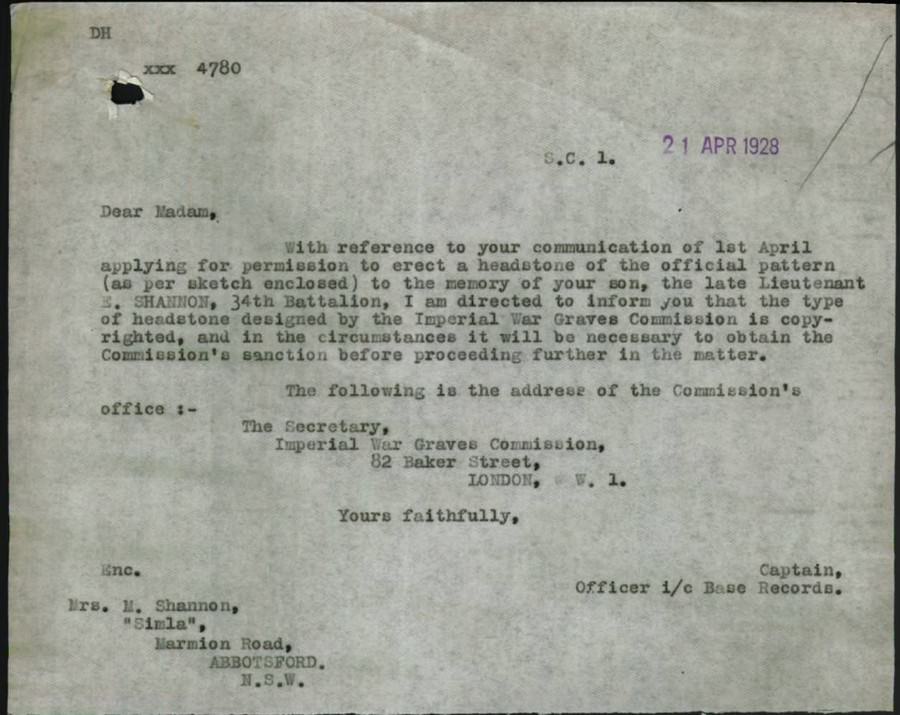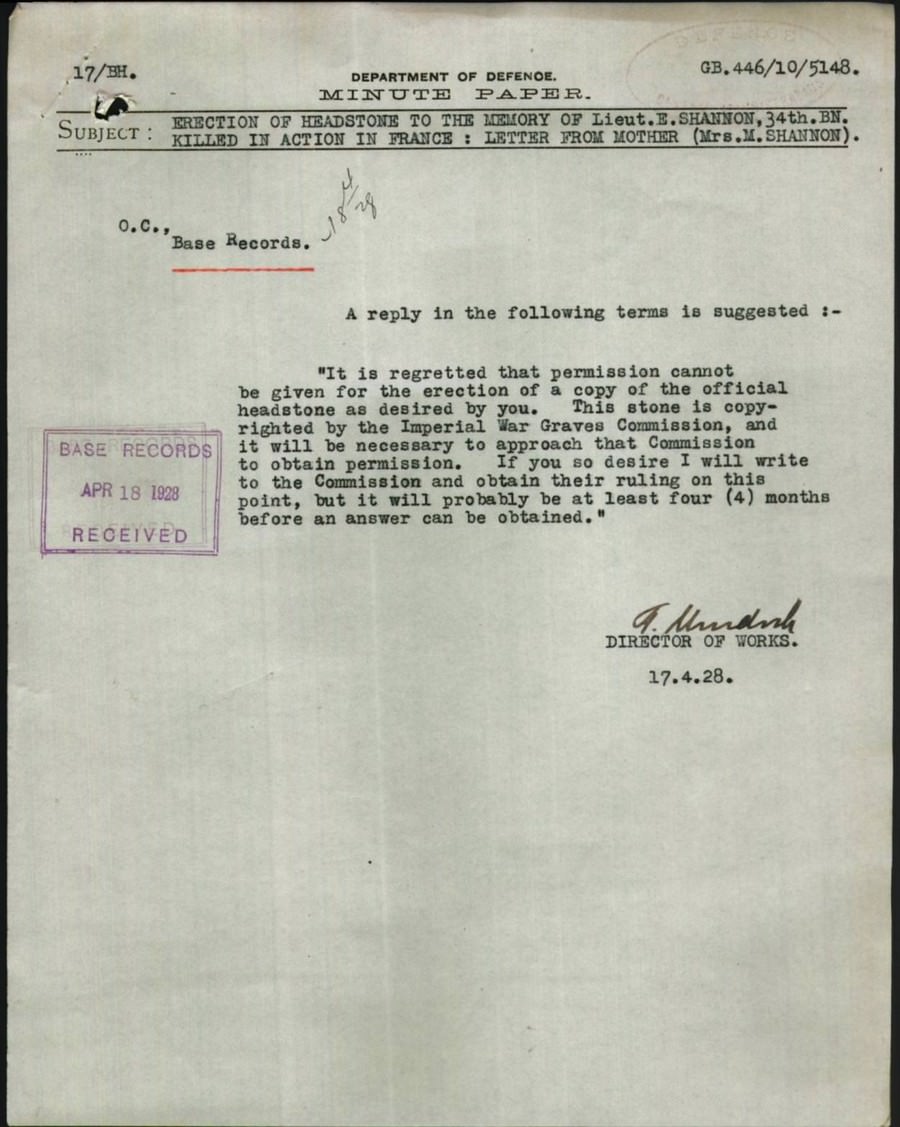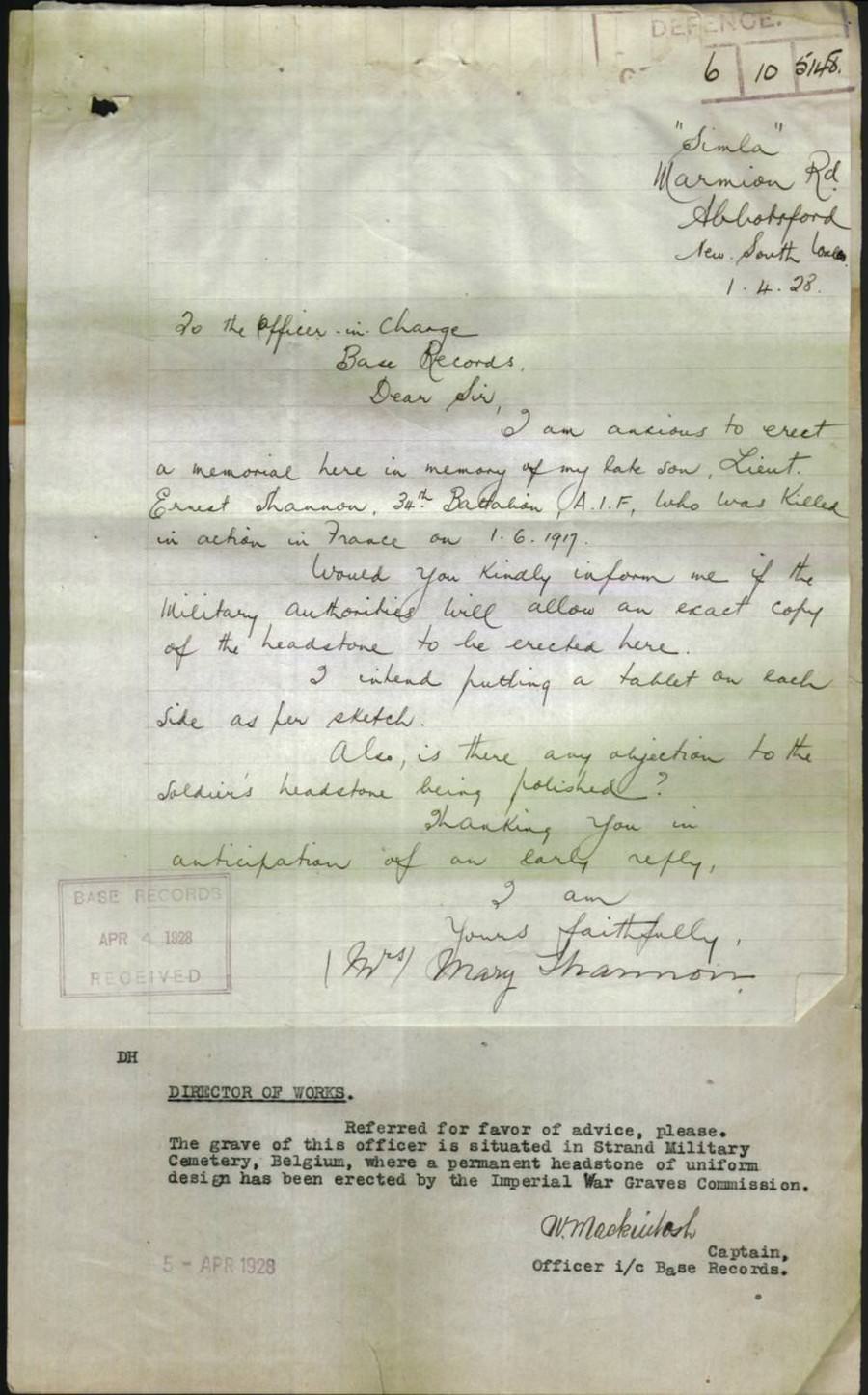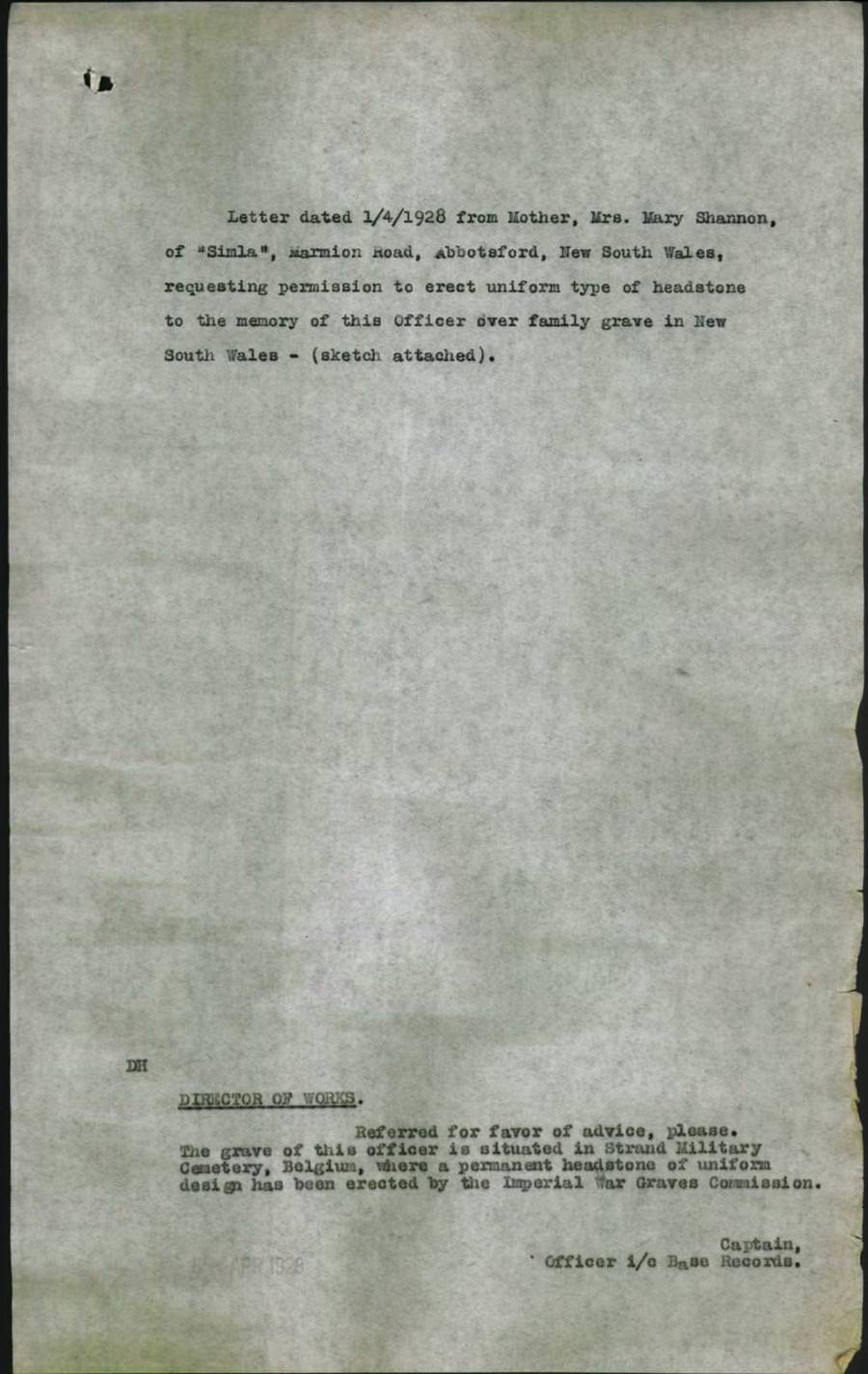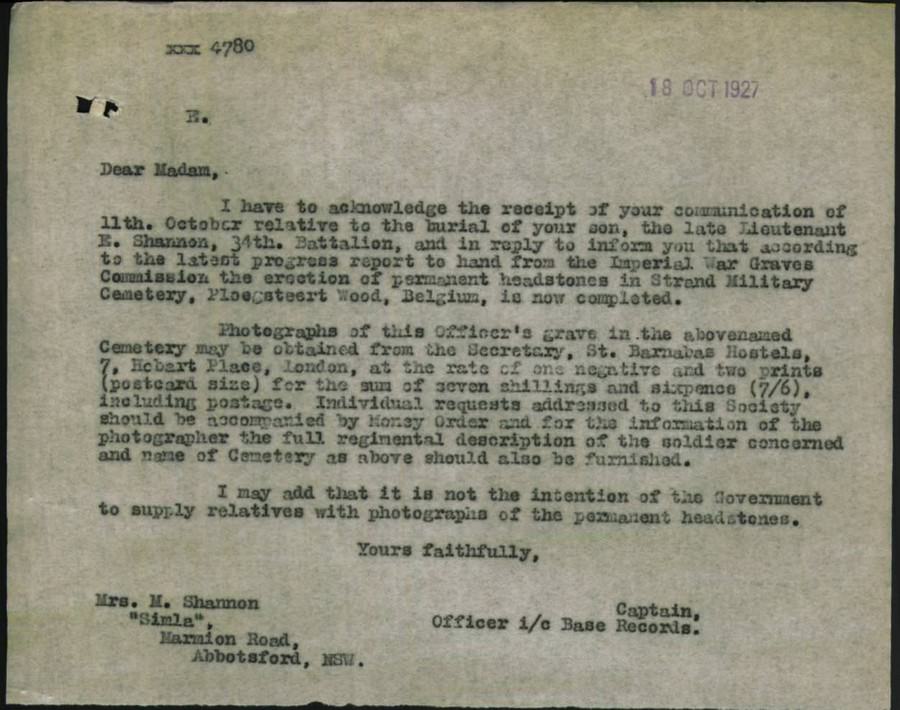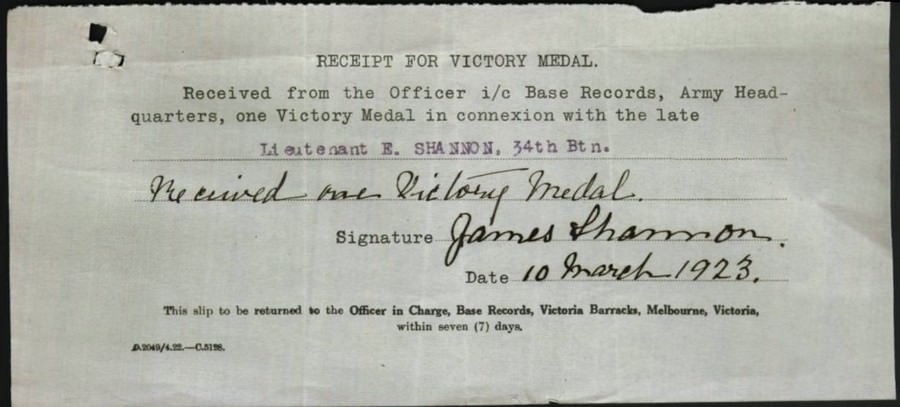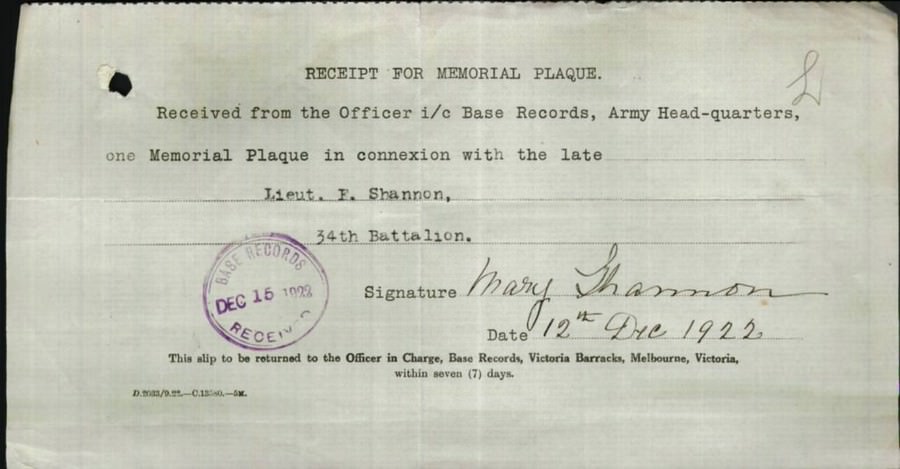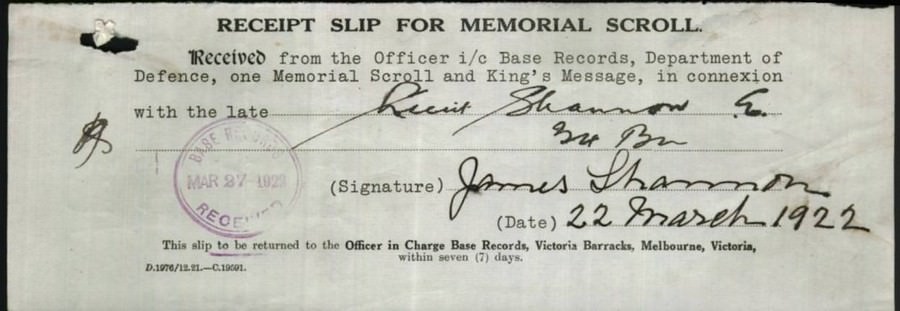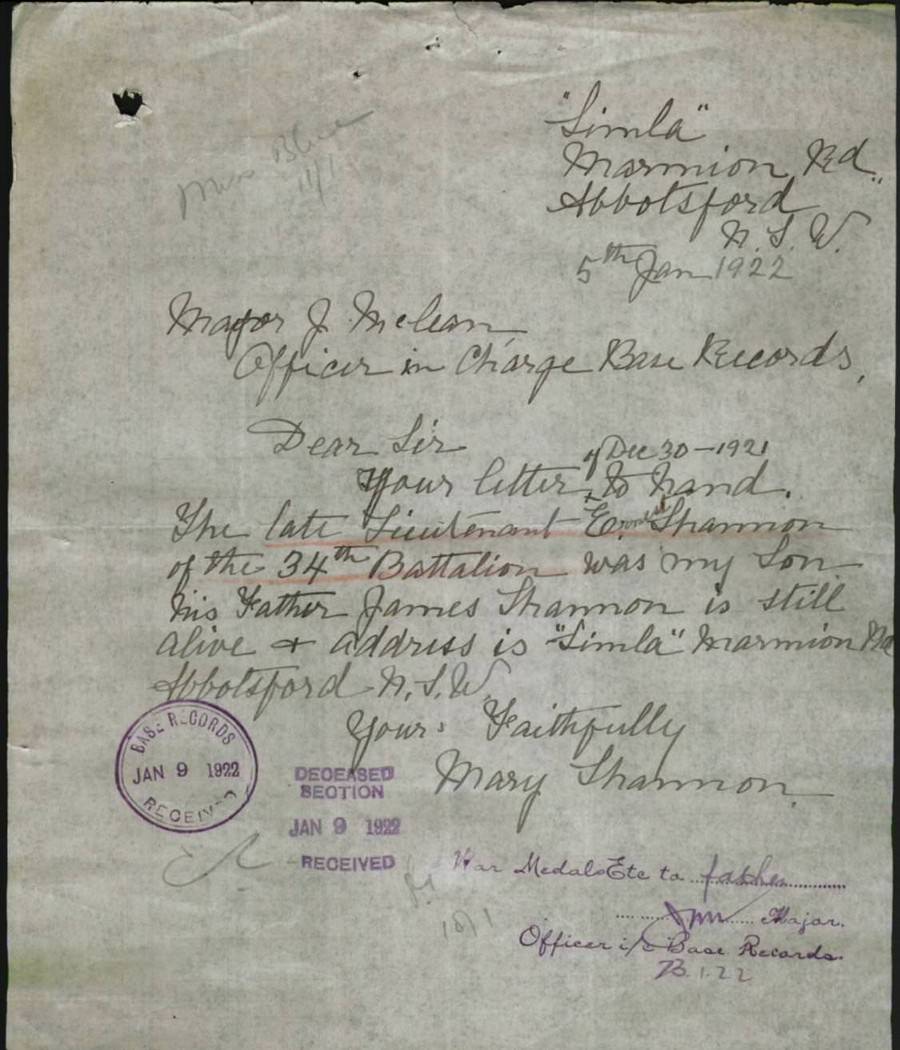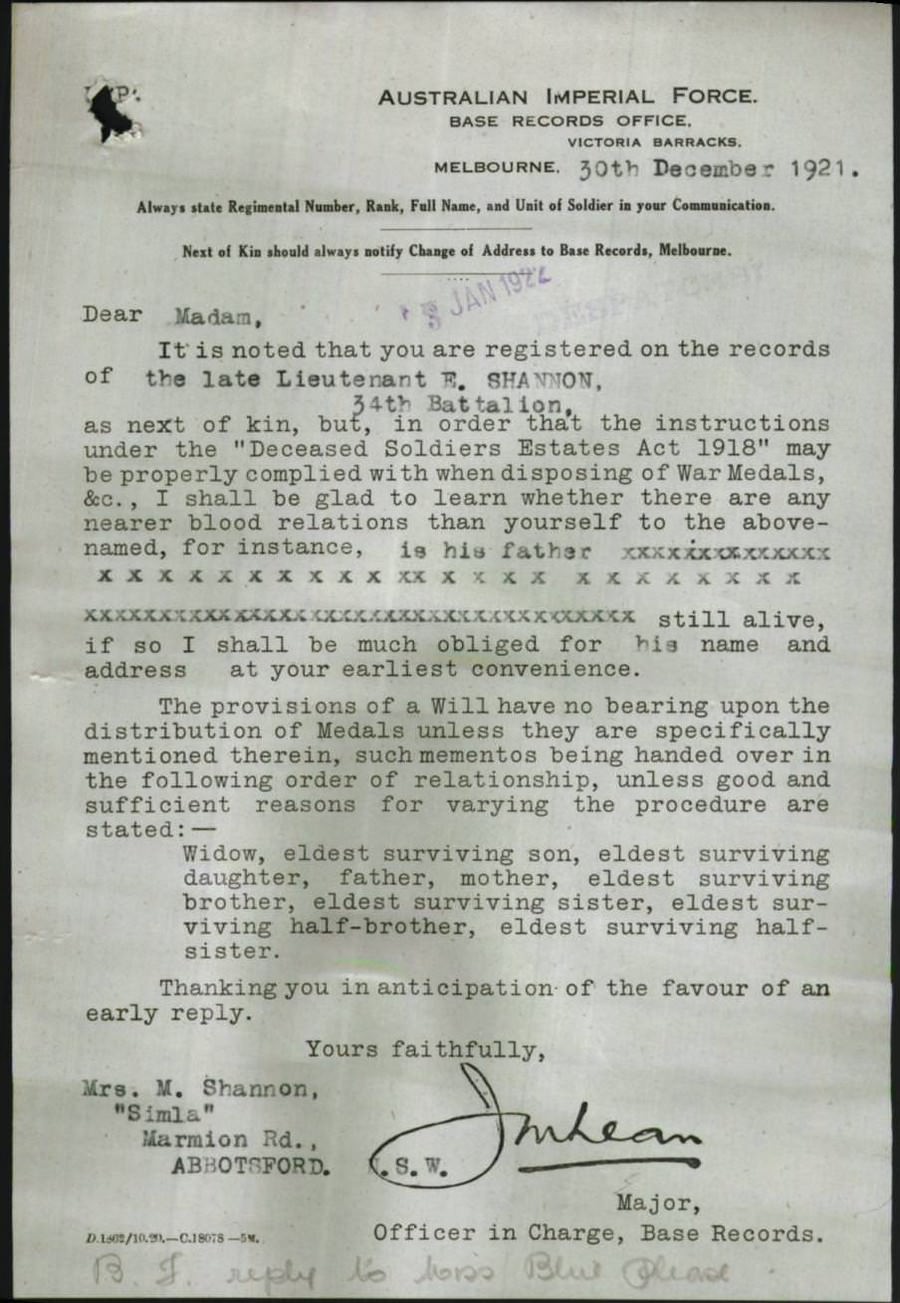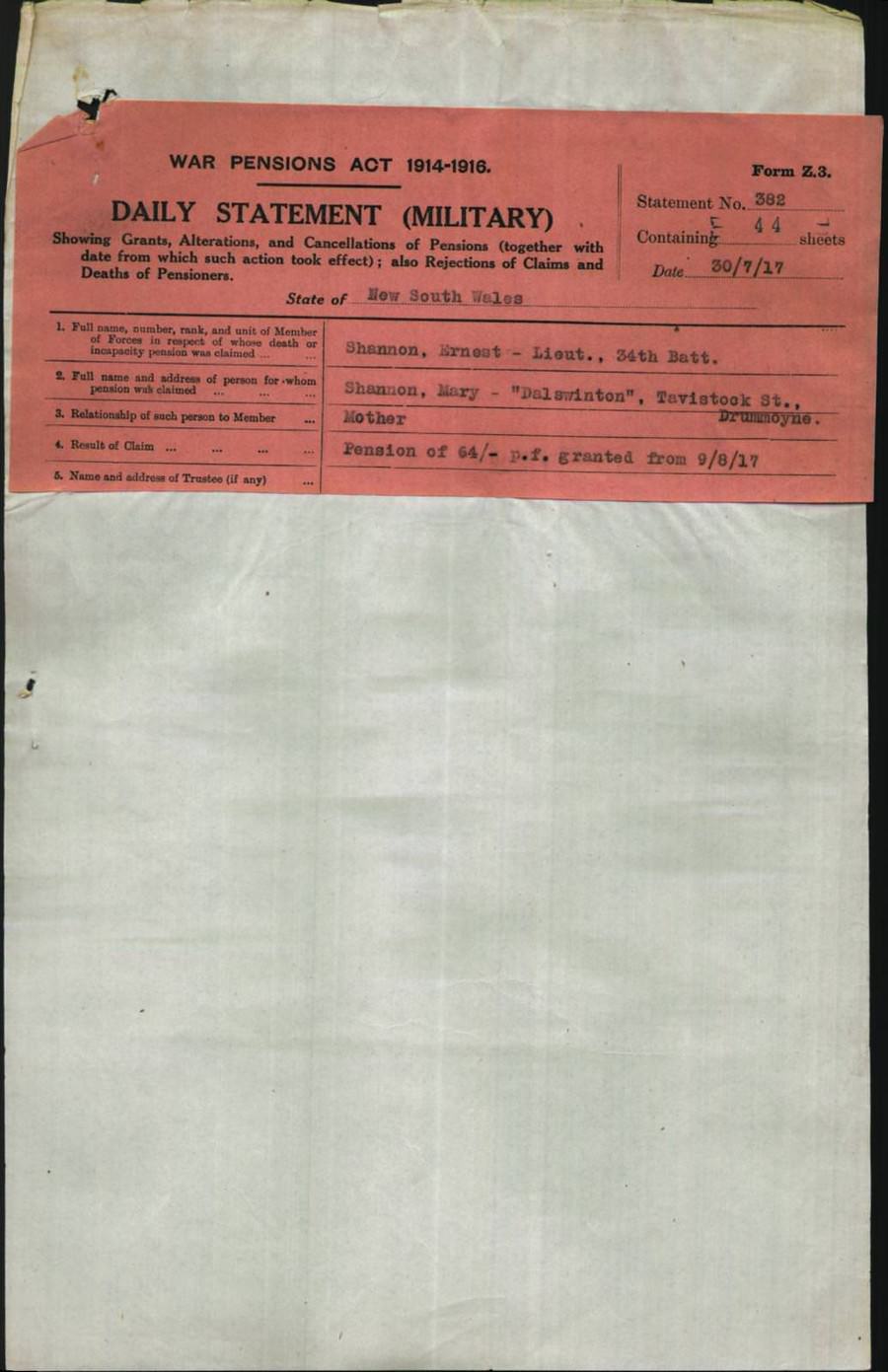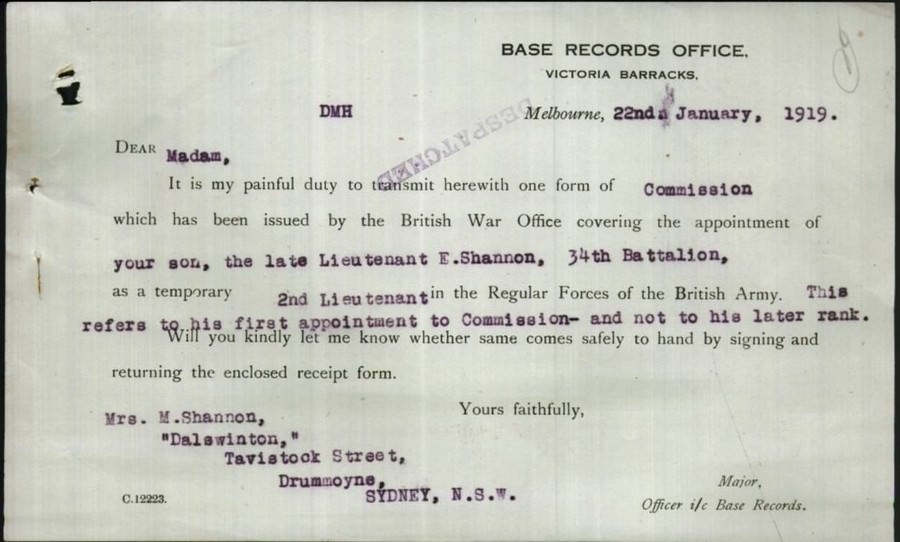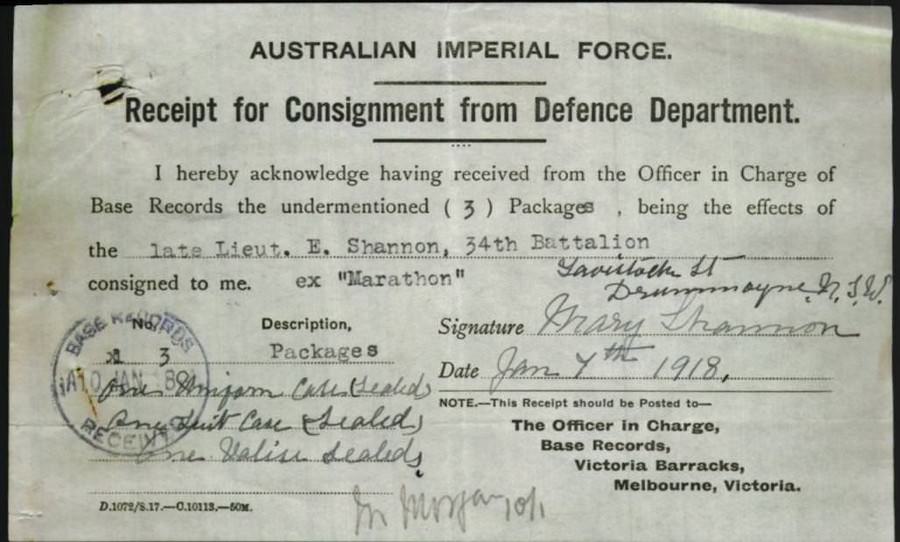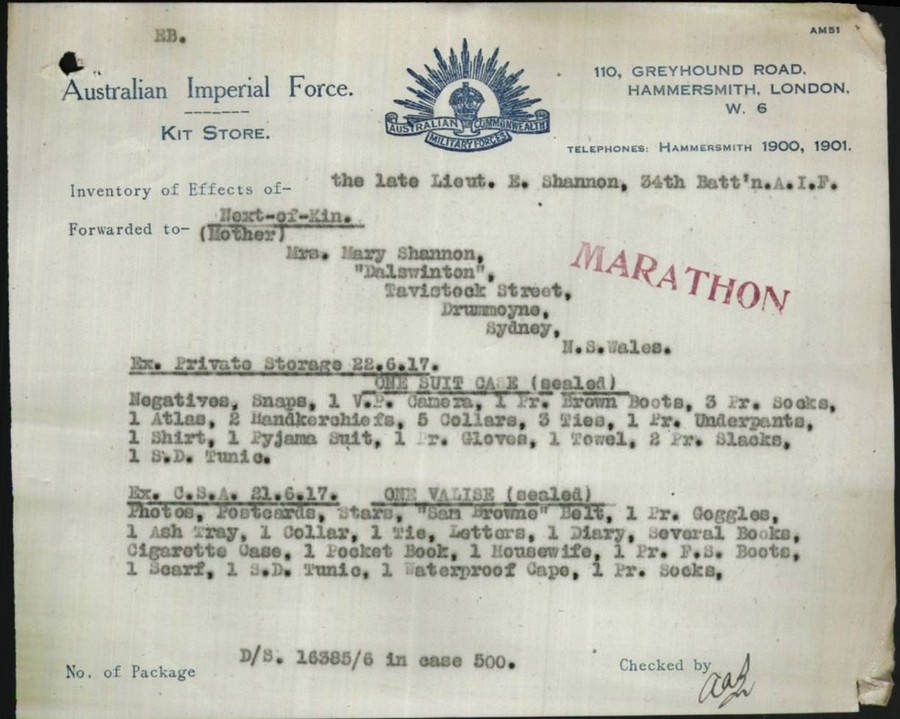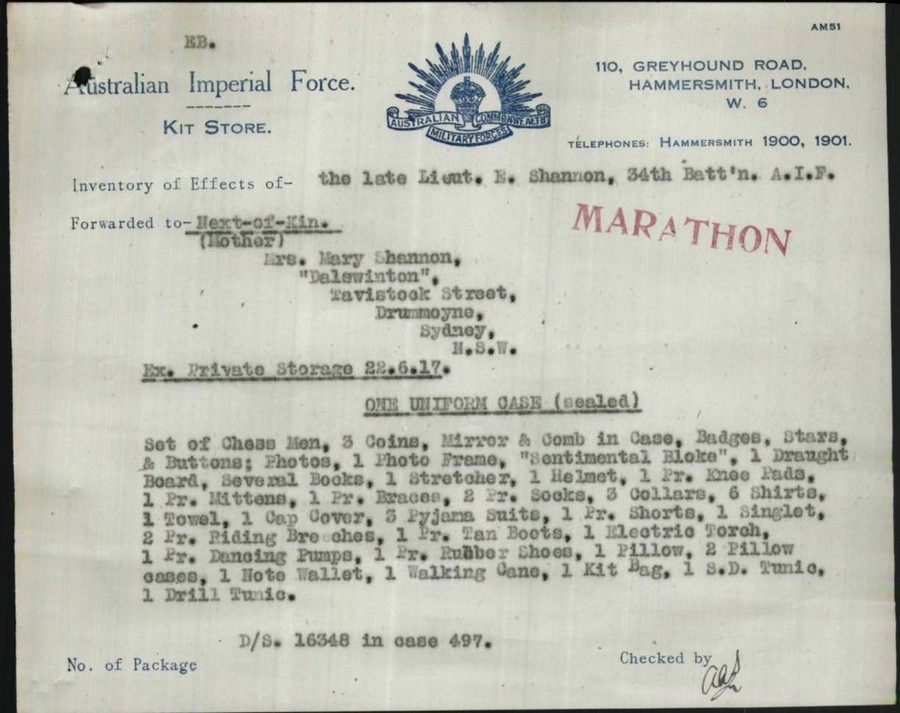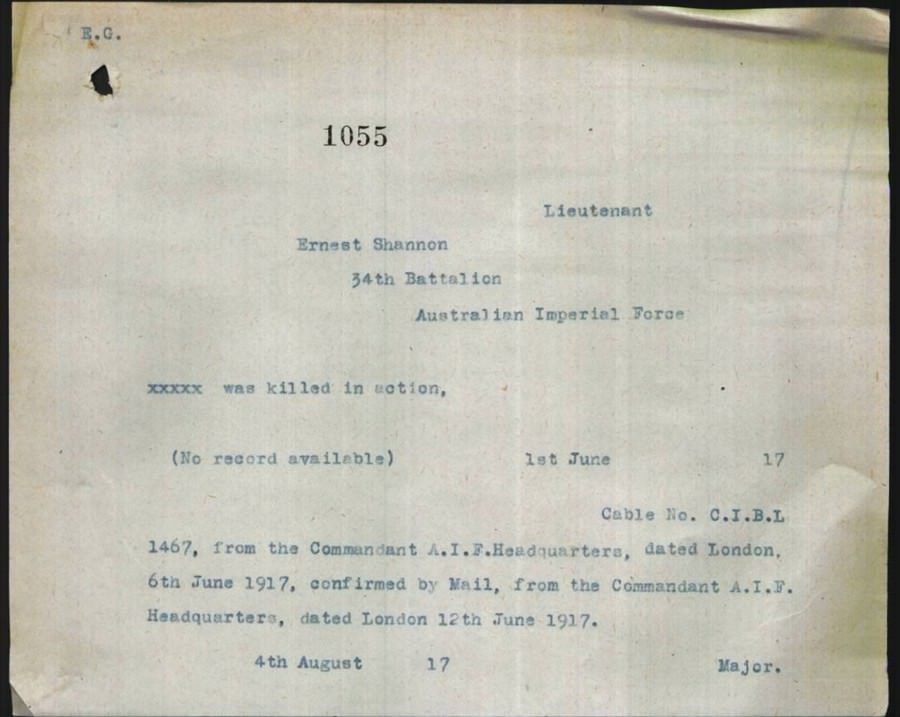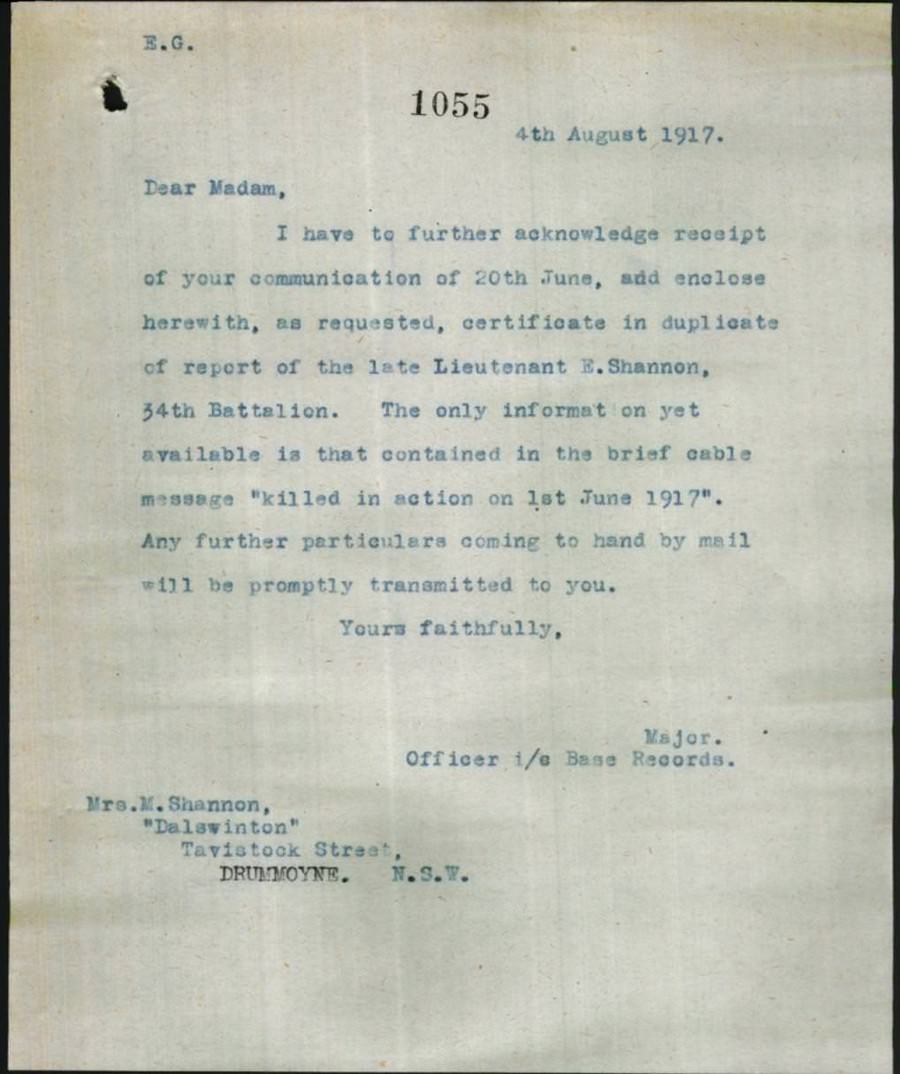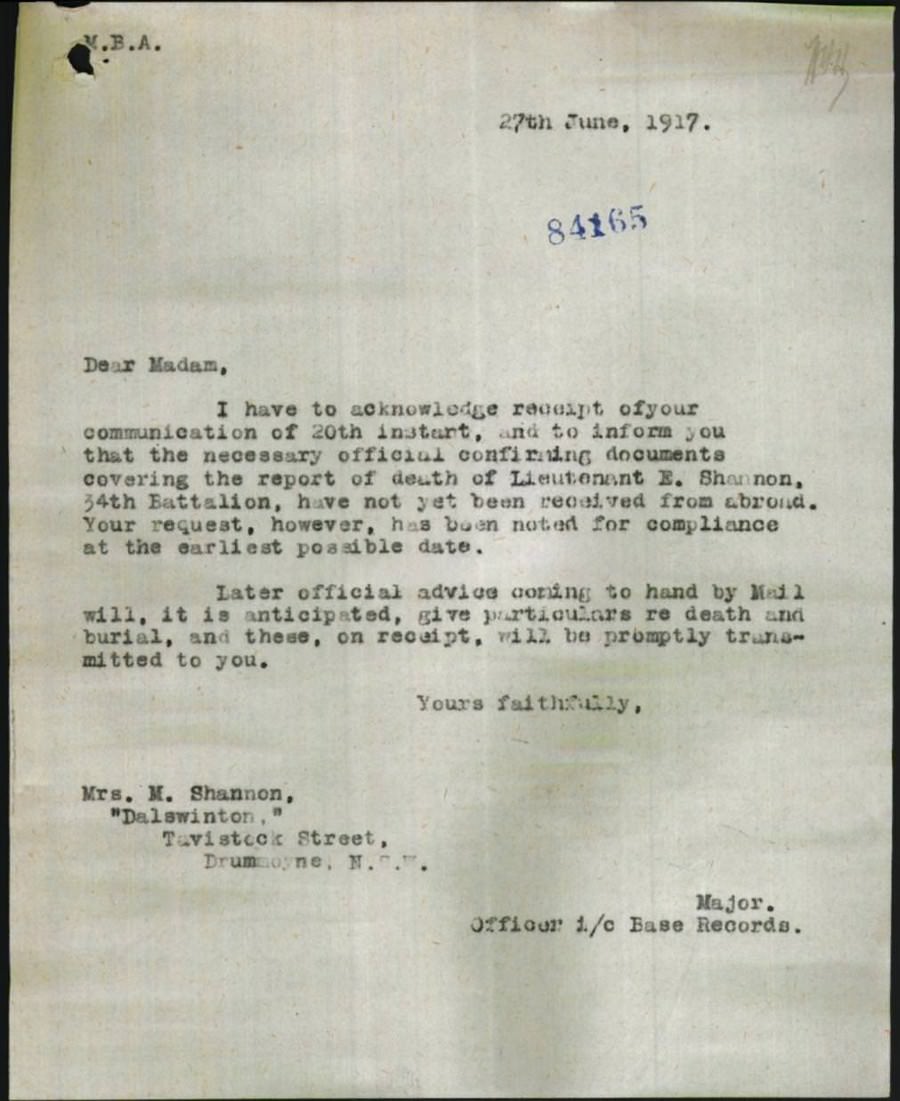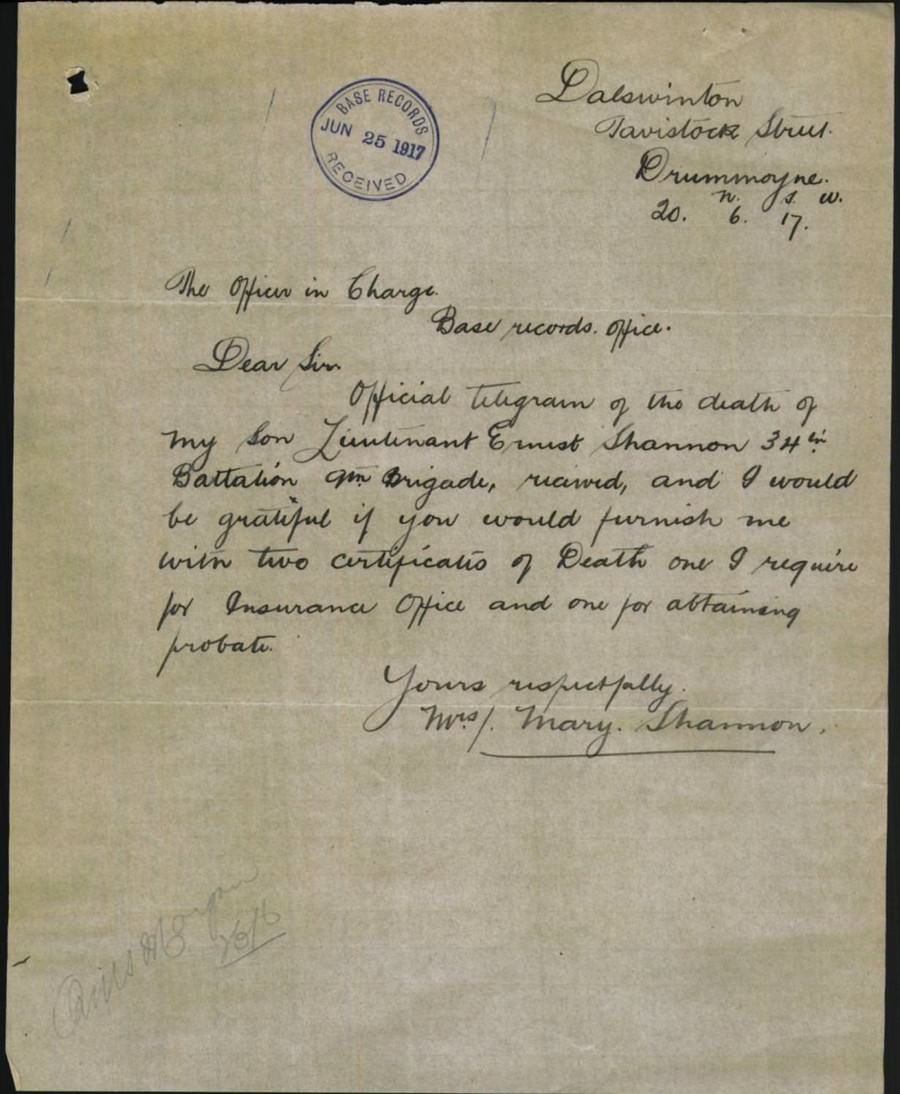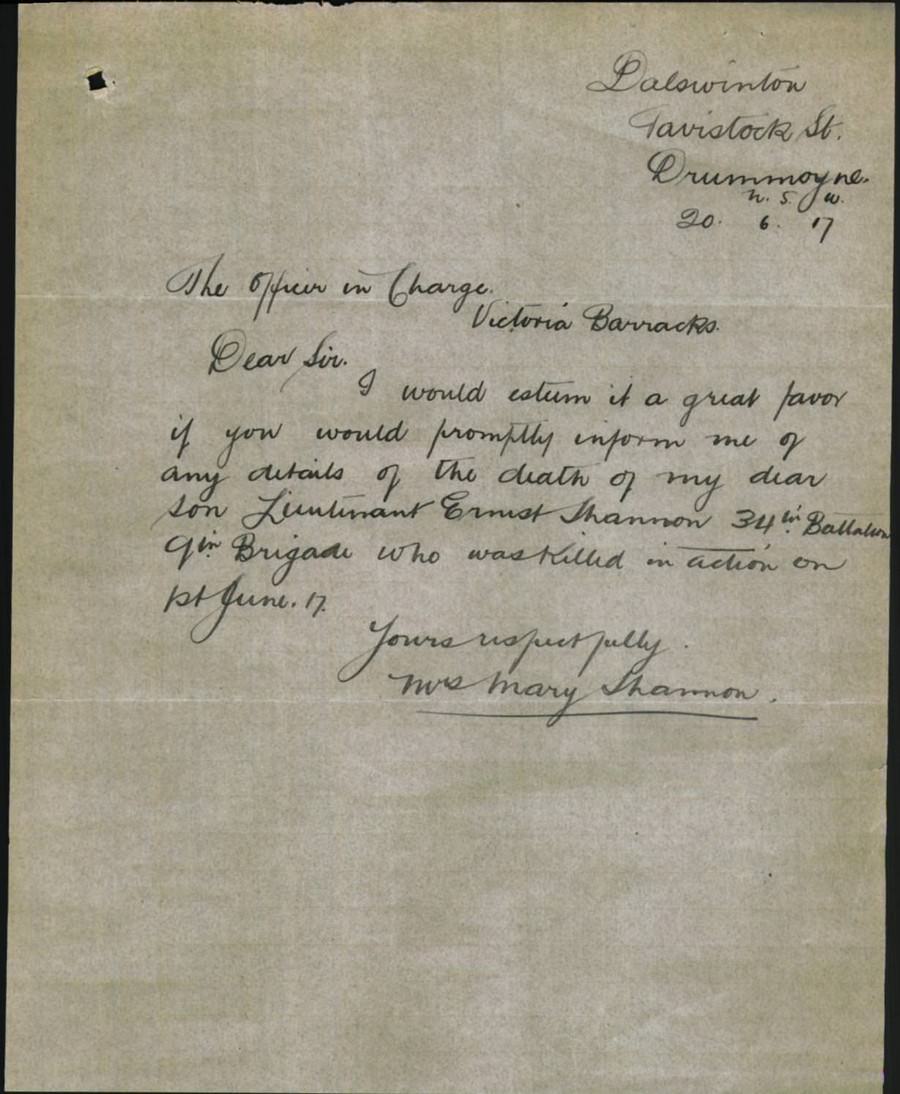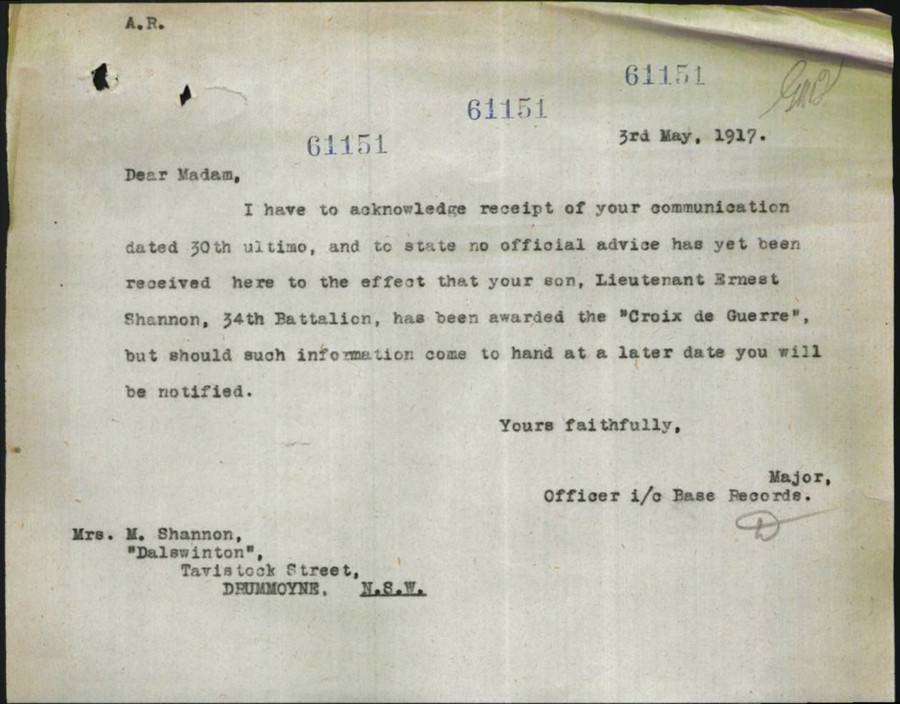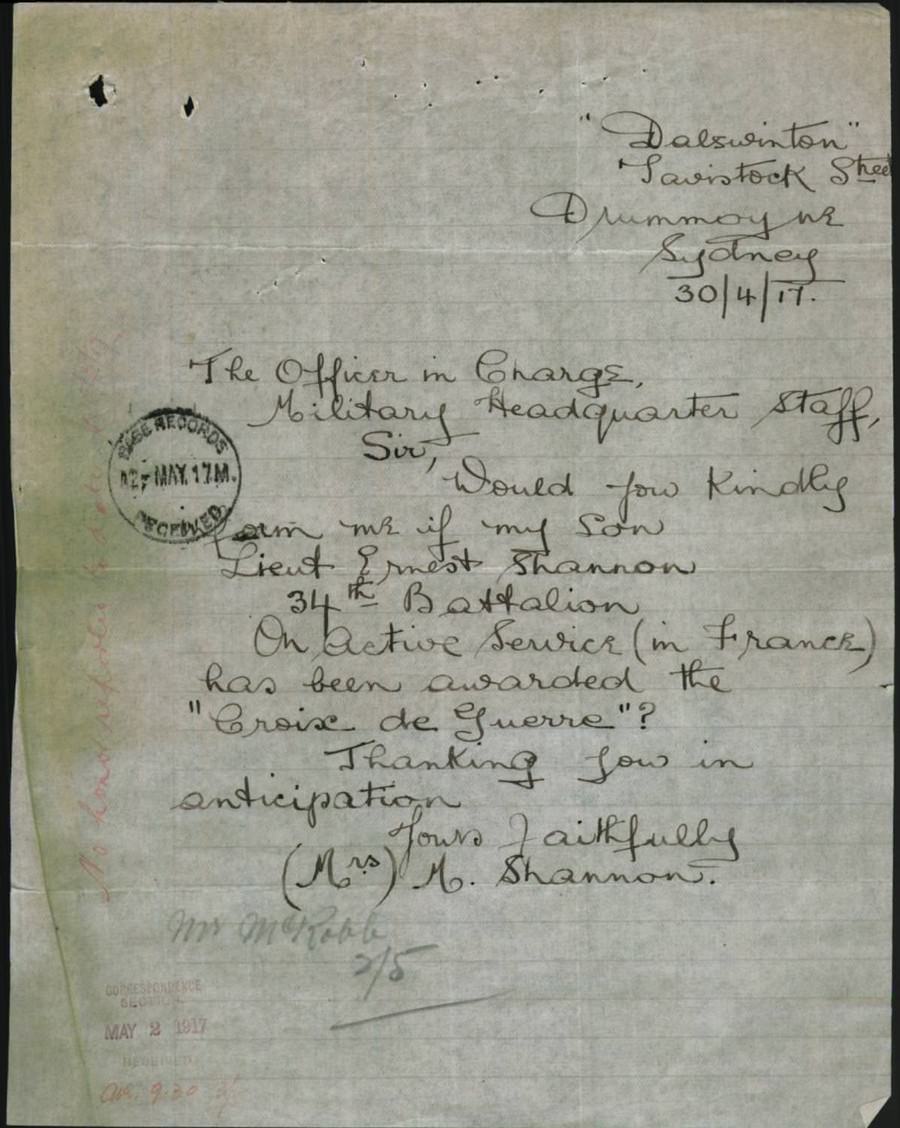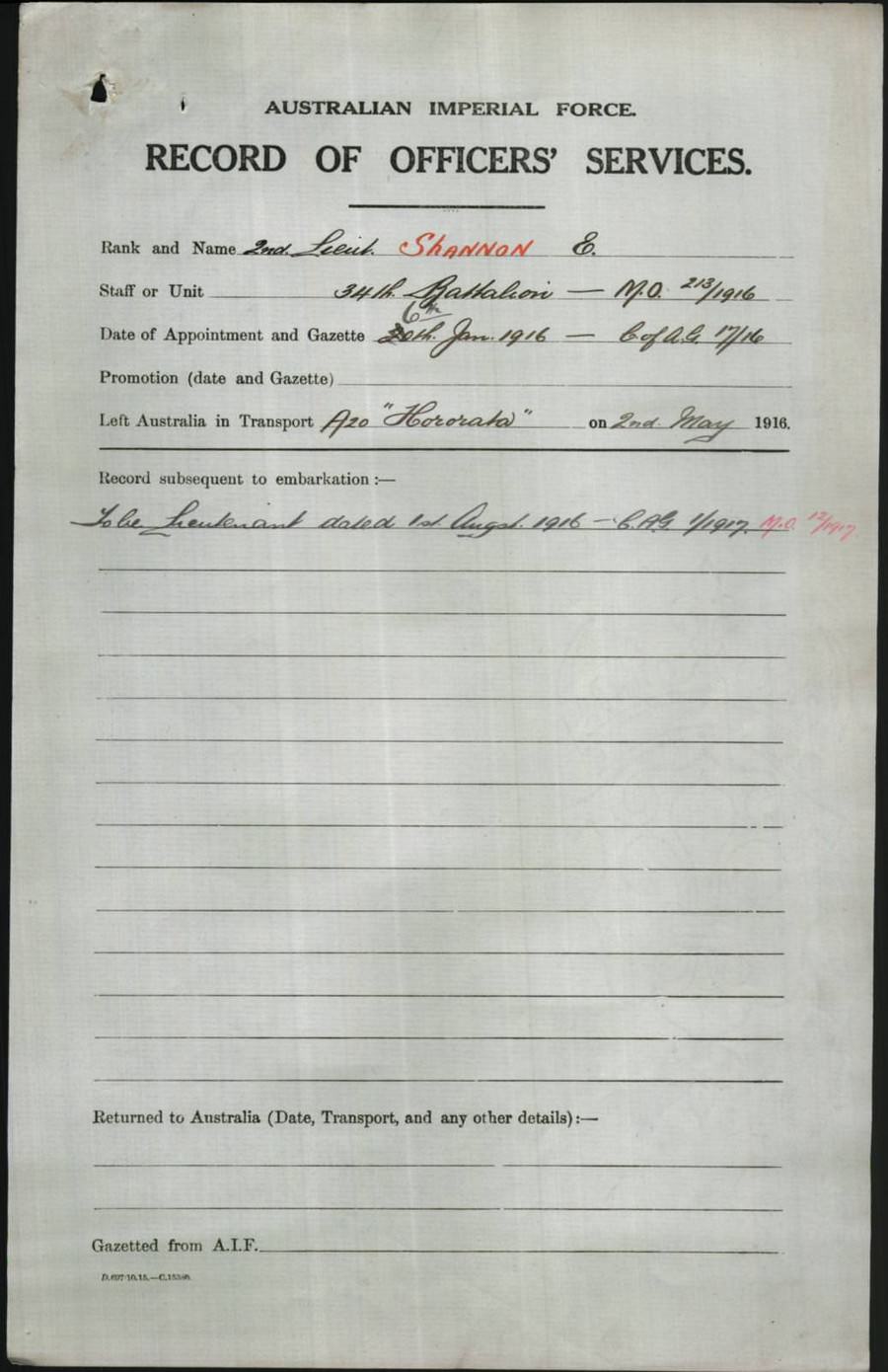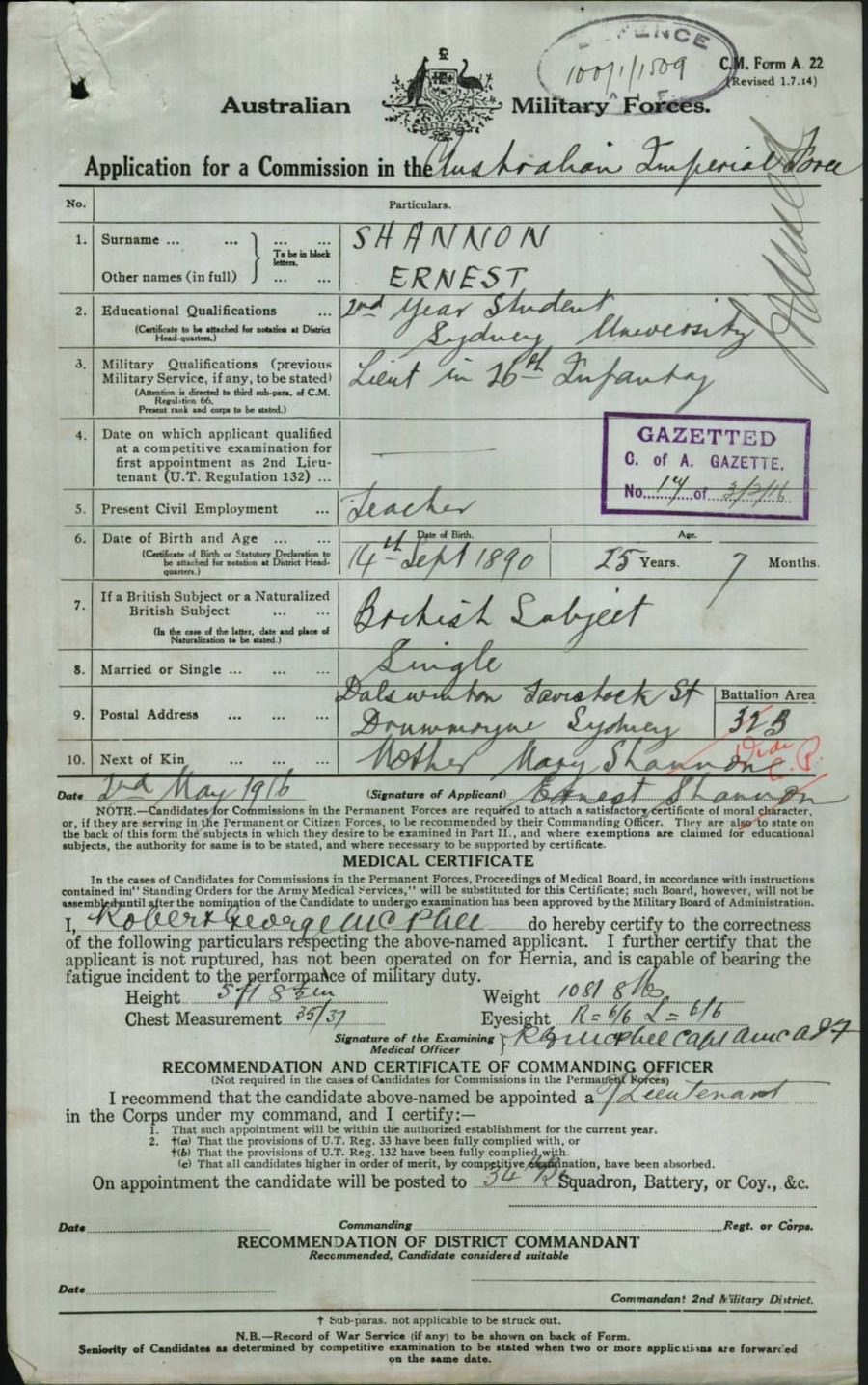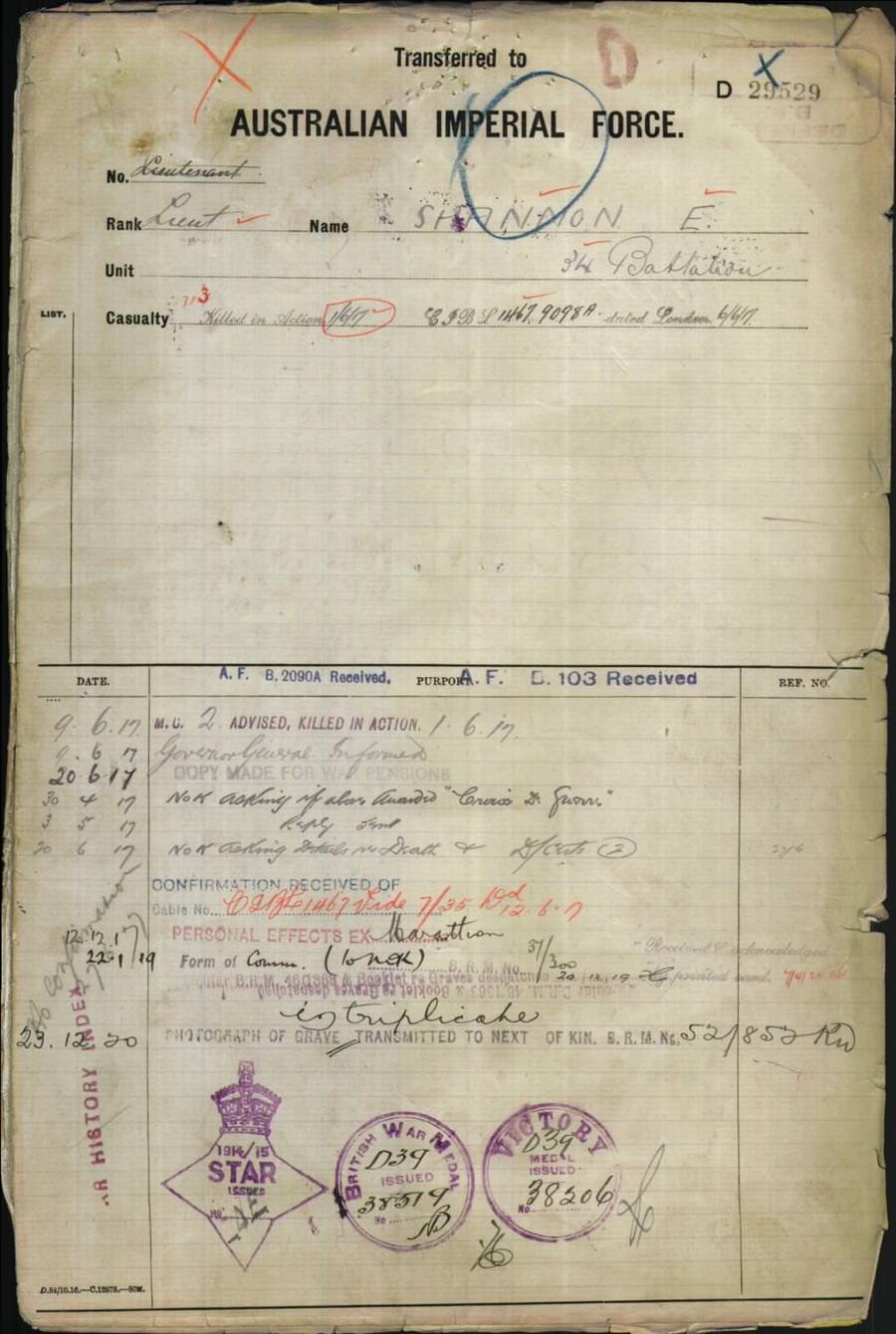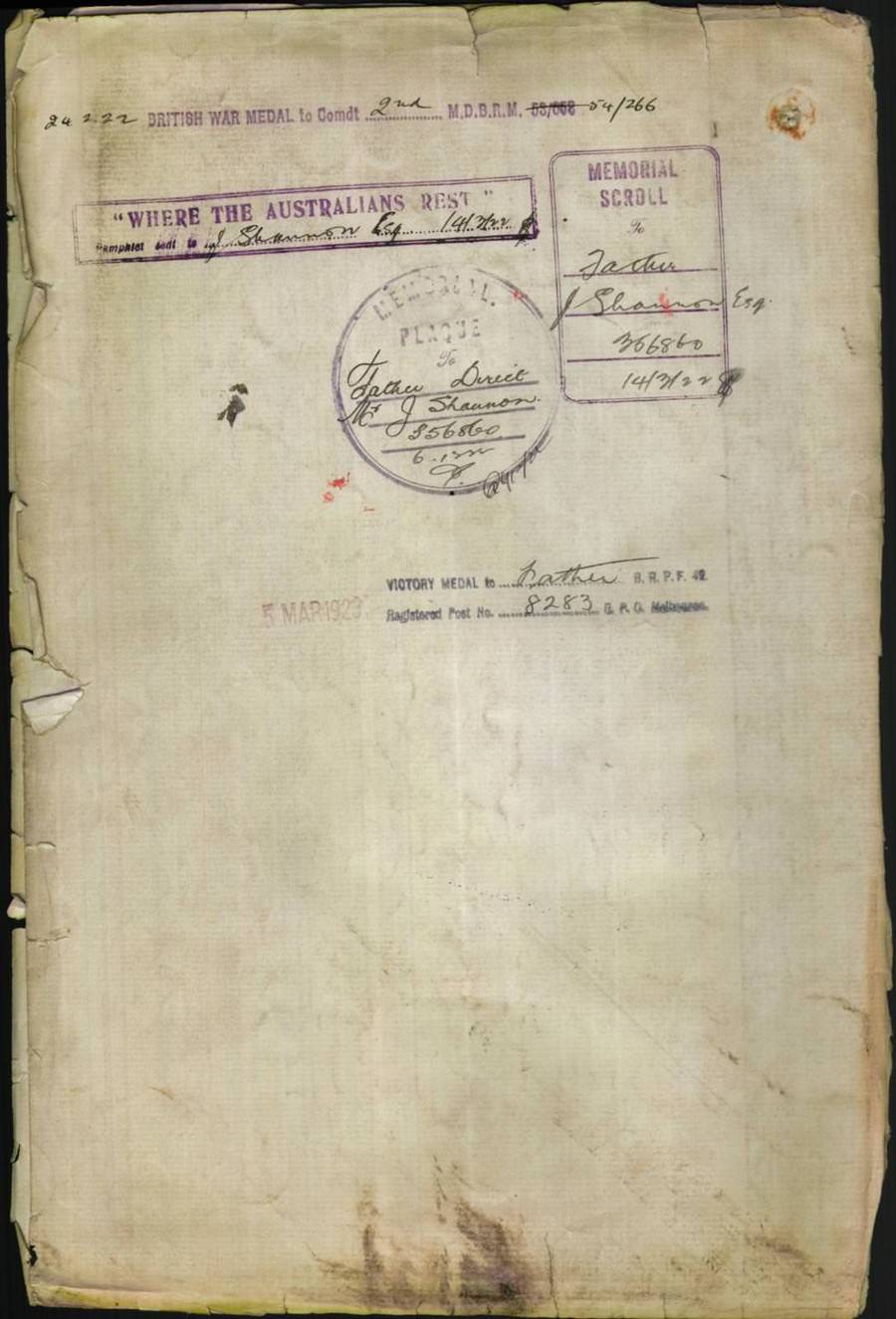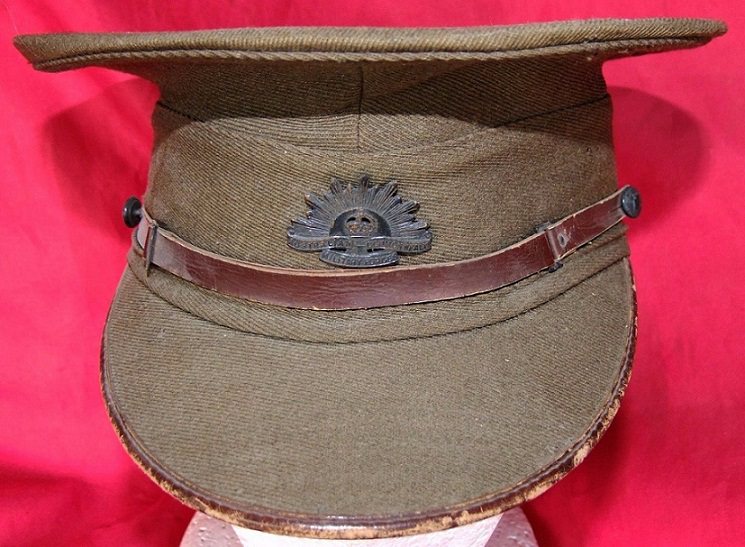
34th BATTALION A.I.F.
Captain: Telford Graham GILDER. M.C.
Born: 21st August 1894, Paddington, New South Wales, Australia. Birth Cert:25998/1894.
Married:
Wife: Dorothy Susan Gilder. nee: Nettleton.
Died: 1982. New South Wales, Australia. Death Cert:10458/1982.
Father:William Alfred Gilder. (18..-1937) Chatswood, N.S.W. Death Cert:14657/1937.
Mother:Ida Elizabeth Gilder.nee: Grave. (18..-1951) Chatswood, N.S.W. Death Cert:12093/1951.
INFORMATION
Telford Graham Gilder served with the Sydney University Scouts whilst he was a Law Student before he enlisted with B Company 34th Battalion AIF on the 6th of January 1916 with the rank of 2nd Lieutenant and was an original member of the Battalion. On 1st May 1916, the Battalion left by Train from Farley Station for the Showground in Sydney, equipped with kit bags and necessary clothing, and was reviewed in Moore Park by General: Gustave Mario RAMACCOTTI. On the following morning, 2nd May 1916 the men embarked on the transport HMAT A20 "HORORATA" and sailed at 4:00 pm".

H.M.A.T. A20 "HORORATA"
12th October 1917
THE BATTLE OF PASSCHENDAELE I
At 1:30 am rain showers began. By 2:30 am it was raining lightly but steadily, by 3:30 fairly heavily. the infantry moved through the pitch dark in single file. In some battalions each man held on to the equipment of the man ahead of him; if touch was broken, those in front had to come back. The news that the line as reported by the 66th division was not held only just reached the incoming troops. Accordingly, in the right brigade (9th) the leading Company Commanders Captain: Clarence Smith JEFFRIES. V.C. and Captain: Telford Graham GILDER M.C. both of the 34th Battalion stopped their men at the entrance to Broodseinde railway cutting, and themselves went to make sure that their column might not run into the enemy.
At Keerselaarhoek Cemetery they found the tape duly laid, and met the officer of the 36th Battalion who had laid it, and by 3:00 am the time set, the 34th battalion was extended on its jumping-off position. But during the previous halt and afterwards, as it lay on the tape, the battalion was persistently shelled and suffered many casualties.
The first shell killed three signallers. Lieutenant: Albert Leslie WATSON. a signal officer of the 34th Battalion, a brave and enterprising leader who also was at the head of the column was severely wounded and all his staff hit. After establishing a forward command post Lieutenant: Thomas Fraser BRUCE 36th Battalion was also killed. Lieutenant Colonel: John Alexander MILNE. 36th Battalion supervising the assembly was knocked down by a shell but continued to command. Captain, Chaplain: Charles MURPHY was also wounded.
(BEAN; History of World war 1 Vol IV p911) Charles Edwin Woodrow BEAN
Only one Australian Division, the 3rd, was wholly employed in the days offensive. but the division was to capture Passchendaele an in spite of the depressing conditions, it was eager to achieve the distinction of doing so. One unit carried the Australian flag, to be planted in Passchendaele, and although officers and men in general were not enthusiastic concerning such "stunts" the Commander-in-Chief had been informed, and had told General: MONASH that, when this flag was planted, the news would be immediately cabled to Australia.
Some keen spirits looked on the operation simply as a dash for Passchendaele. One young company commander of Monash's reserve battalion, the 33rd, in face of a strict prohibition, led on his company as soon as the barrage fell. Starting from a line 350 yards in rear of the general alignment, the 3rd Division was out of touch with its neighbours from the outset. The heavy shelling on the tapes had made orderly disposition there almost impossible, as German Machine-Guns, undisturbed by the barrage now opened immediately, no opportunity offered of restoring proper formation.
The 9th Brigade went forward in the utmost confusion and a terrible mix up as reported by Captain: Robert Derwent DIXON D.S.O 35th Battalion at 6:40 am and "Great Confusion" was the description given by Captain: Henry Vince CARR 35th Battalion. Even on the ridge, the mud was difficult, the hope, if there ever was one, of catching up before the quick barrage finished.
The 9th Infantry Brigade's intended direction lay not along the ridge and the Passchendaele road, but diagonally across them, and parallel to the railway, which most of the brigade could not see. As the jumping-off line was practically at right angles to the ridge, the brigade tendered to advance alone the heights. The Machine-Gun fire at the start came, on the 9th Brigade's right, from the ruined house near Defy Crossing; on its center from, "Hillside Farm"; and on its left from Augustus Wood.
The pillbox opposite the center was supported from the rear by a trench in which were Germans with Machine-Guns, and here occurred a delay which threatened to wreck to whole attack. it was not until an hour after the program time that these places were rushed by the neighbouring portion of the line under Captain: Henry Vince CARR and Captain: Robert Derwent DIXON. D.S.O of the 35th Battalion. The trench contained 35 Germans and 4 Machine-Guns. Part of the line was also held up by a pillbox close to Passchendaele road near the highest point of the ridge.
Here there was practically no shelter from attack, but Captain Clarence Smith JEFFRIES. V.C. of the 34th Battalion managed to organise a party, with Sergeant: 21 James BRUCE and another N.C.O Corporal: 2036 Vere Cummings STEVENSON and a dozen men, and outflanking it, charged the place from the rear, capturing 25 Germans and 2 Machine-Guns. These actions set free the advance. The pillbox captured by Captain Clarence Smith JEFFRIES. V.C. being not far short of the first objective, the 34th Battalion dug in there.
Great loss had been uncured; the 34th Battalion had only three officers left and there were wide gaps in the line. The right flank had swung far away from the railway, along which the 4th Division was attacking, but on the left Captain: Telford Graham GILDER M.C. of the 34th Battalion who had been wounded by a Machine-Gun bullet, but was carrying on found the 10th Brigade digging in slightly to his left under Captain: LATCHFORD, 38th Battalion, and fell back seventy yards to join it.
The Advance to the second objective was to begin at 8:25, the low clouds had opened, and fleecy cirrus with patches of blue were widening overhead and the sun had come out. The 9th Brigade had been so late in reaching the first objective that, while most of the 34th Battalion dug in, the 35th Battalion, allotted for the second phase, moved straight on. Standing on the Passchendaele road, Captain: Henry Vince CARR and Captain: Robert Derwent DIXON. D.S.O of the 35th Battalion endeavoured to decide where the barrage then was; at first Carr thought it may be behind them, but finally decided that it was ahead.
The confusion at the start had split the brigade into mixed parties of all battalions and many of the 34th went on with the 35th, the main body of which, about 100 in all, now advanced along the south-eastern side of the ridge in order to catch the barrage. The hour was probably a little before that for the second advance. A German Machine-Gun in the gap between the brigade's right and the railway immediately opened with deadly effect.
Major: John Bruce BUCHANAN 36th Battalion, the senior forward officer was killed. At this critical juncture Captain: Clarence Smith JEFFRIES. V.C. of the 34th Battalion, again accompanied by Sergeant: 21 James BRUCE, led out a few men from the first objective and made for the gun. it was shooting in short bursts, and he was able to work up fairly close. Seizing a moment when it was firing to the north, he and his men rushed at it from the west. It was switched round, killing him, and sending his men to the ground.
But when its fire eased they worked round it, rushed the position, seized 25 Germans and 2 Machine-Guns. This gallant and effective action Captain: Clarence Smith JEFFRIES. V.C. was posthumously awarded the Victoria Cross for removing the chief danger to the advance along the crest, but as soon as the 35th Battalion crossed to the eastern side of the hill it became the target of a number of field and heavy guns which, from the hedges and other cover in various parts of the landscape, fired over open sights.
After passing a corpse on its right, the 35th Battalion settled down on what its officers took to be the second objective, although on the extreme right they were actually short of the first. Captain: Henry Vince CARR, now the senior officer on the spot, reported; 8:35. On objective, with about 100 Captain: Robert Derwent DIXON. DSO and three officers. Casualties 25 or 30 per cent. Captain: Henry Charles Dight CADELL M.C Lieutenant: Charles Teesdale MAIN Lieutenant: Keith Maitland DAY reported killed and Lieutenant: Frank HORNE Lieutenant: Christopher Kyffin MEARS Lieutenant: Charles John HENRY were wounded. Prisoners sent back 400-500. Contact on flanks uncertain, being heavily shelled.
Three posts were established under surviving officers, right Lieutenant: Norman Beade D'ARCY M.C centre Lieutenant: Joseph Francis ADAMS left Lieutenant: Harold Sydney WYNDHAM. In this brigade the battalion for the final objective was the 36th, and a report came along that it had gone through. Actually, it had advanced with the 35th, but, on the left, penetrated to the second objective, which bad been reconnoitered during the previous halt by the commander of the company Captain Robert Austin GOLDRICK. M.C.
He went up the road towards Passchendaele. The barrage, he said afterwards was no hindrance to him, although he left the line lying as close to it as possible "or where he thought it was." He was unable to detect the intensification of the barrage for the second phase, but led his men forward at the proper hour.
As no other battalion was there, he now established the line with its left on the road 600 yards from the church, about the point reached by the 66th Division's troops on October 9th. In front of the position Captain: Robert Austin GOLDRICK. M.C. and Lieutenant E.H FLEITER (39th Battalion) found hidden in a shell hole men of the 66th Division. One had a broken arm, the other trench-feet. They took the Australians at first for Germans. When reassured, "we knew the Australians would come," they said, 'We prayed hard."
From the direction of the church, which lay straight down the highway, no fire came. two Germans ran up the road and surrendered. South-east of the village, along the Moorslede road, were the Germans who seemed "very windy," and near the road two 5.9-inch howitzers began to blaze at the troops digging in.
The 9th Brigade had taken its second objective and the 10th its first, but the position of the officers in charge of these advanced lines was full of anxiety. On the eastern slope Captain: Henry Vince CARR 35th Battalion, the senior officer in this part of the 9th Brigade's front, could see the 4th Division somewhat ahead of its right, and by 10:55 he had discovered that the 36th was on the left, but farther left than the 10th Brigade was far behind on its first objective . The German Guns ahead were sniping with dreadful accuracy. Carr on the western slope, sent back for instructions: "what am I to do?"
Word of the true situation reached headquarters slowly. As on the 9th, the first news was all encouraging. General: MONASH in the Ypres ramparts heard shortly after 7 that both brigades were "well away"; but by 8:26 he had ample evidence that the first objective was taken. At 9:25 the intelligence officer examining prisoners (Lieutenant: Frederick Morley CUTLACK Official War Correspondent) reported having heard from the wounded men that the second objective had been reached.
At 10:28 headquarters was informed of a statement of a wounded man, that the 38th Battalion had gone through. A further report that Australians had been seen at Crest Farm although quickly contradicting but probably true nevertheless. Which confirmed Monash's impression that his division was succeeding. Concerning the New Zealand brigade on his left, however, there was no word until, at 10:50, there arrived the tragic information that the New Zealand Division was stopped by the enemy alone the entire front.
Monash has already heard at 9:55 that the 10th Brigade was held up by fire from Bellevue Spur. Believing that his division was still advancing, he asked that every gun that the New Zealand Division could spare should be turned upon that ridge to suppress the fire. Meanwhile, he would order the reserve (39th) battalion of the 10th Brigade to be ready to assist in holding the ground already won. The reserve battalion the (33rd) of the 9th Brigade he was still keeping back to assist in the capture of Passchendaele.
Shortly after noon news of the true situation arrived. Lieutenant Jackson of the 40th Battalion had established at Waterfields pillbox near the Ravebeek a forward report-centre from which a series of messages, admirably accurate, was flashed by lamp to the headquarters of Lieutenant Colonel Lord of the 40th Battalion. Thus Brigadier General McNicoll of the 10th Brigade was able to inform Monash of the precise position of Giblin's Line. He added that the situation was very serious and the casualties very heave. At the same time from the front line of the 9th Brigade arrived a pigeon message, sent by Captain: Richard GADD of the 36th Battalion.
We are on the Blue Line (second objective) with composite force all three battalions, both flanks in the air.
The New Zealand Division was to make a second attempt at 3:00 pm, and Monash was of the opinion that from the 9th Brigade, well forward on the ridge, patrols might still work northward around Crest Farm. His reserve, the 33rd Battalion (9th Brigade), was accordingly ordered to attempt this at 4:30 pm and the 10th Brigade's forward line being meanwhile reinforced by its own reserve, the 39th Battalion.
These orders went out, but none of them were fulfilled. The New Zealand Division had been defeated by obstacles which no hastily renewed bombardment could have overcome. no infantry in the world could have crossed the Ravebeek mud, penetrated the dense wire, and attacked the crowded pillboxes of Bellview with the assistance of a barrage which did not even screen the advance. No blame can attach to the artillery. Its commander, according to the New Zealand official history, had reported on the previous day that his guns might be unable to give efficient support.
This magnificent division, which lost nearly 3,000 men, had been held up in almost exactly the same position as the 49th three days before-the left brigade penetrating half-way to the first objective, the right stopped almost at the start. The Germans were reinforcing. The New Zealand battalion commanders knew that their men had no chance of succeeding by renewed attack, and the order was eventually cancelled.
As for the Australians, of the two battalions that MONASH had now ordered to participate, the 39th had already to a large extent been involved in the fighting, and the 33rd, endevouring to reach its position of readiness for outflanking Passchendaele, had suffered great loss. No less than 6 of its Officers were killed or mortally wounded. Captain: Wilfred Frank HINTON in command of the forward company, Lieutenant Leonard Rockley BROWNLOW Lieutenant: Thomas Acheson ARMSTRONG Lieutenant: Albert George KILPATRICK Lieutenant William REES-REYNOLDS and Lieutenant: Norman Francis GOBLE.
By the time Lieutenant Colonels Henderson DSO 39th Battalion and MORSHEAD attempted to carry Monash's orders, they found that the attacking force of both brigades was back almost at its starting point. What had happened was as follows.
Neither Major: GIBLIN near the Ravenbeek nor Captain: Henry Vince CARR on the ridge had received their messages sent several hours earlier. The 9th Brigade's line was still being battered by the German Guns. Captain: Richard GADD 36th Battalion, whose troops were being wiped out, informed Captain: Henry Vince CARR 35th Battalion that Lieutenant Colonel: John Alexander MILNE D.S.O 36th Battalion had now come forward to Hillside Farm. CARR accordingly sent Captain: Robert Derwent DIXON. D.S.O with GADD to explain to Milne the desperate nature of their situation. Milne said that he would try to get their troops relieved after dark, but till relieved they must hold on.
(BEAN; History of Word War 1 Vol IV page 921) Charles Edwin Woodrow BEAN
Meanwhile, however, the German artillery was annihilating some parts of their line. All leaders of Carr's three posts were out of action. Lieutenant: Joseph Francis ADAMS was Killed in Action and Lieutenant: Norman Beade D'ARCY M.C and Lieutenant: Harold Sydney WYNDHAM were wounded. Of the remaining officers of the 36th Battalion, Major: John Bruce BUCHANAN and Lieutenant: Fredrick William PUTNEY had been Killed in Action and Captain: Robert Austin GOLDRICK M.C wounded. Farther back Lieutenant: Sydney COOK had been Killed in Action and Lieutenant: William WAND and Lieutenant: Herbert Reginald MAILER were wounded.
At 3 o'clock rain began to fall steadily. at 3:15 pm Captain: Richard GADD 36th Battalion, thought agreeing with Captain: Henry Vince CARR 35th Battalion that to hold on meant annihilation, refused, in view of his Colonel's orders, to retire. Carr consented to wait while Gadd again sent word to Lieutenant Colonel: John Alexander MILNE D.S.O. Carr himself at 12: 30 had sent Captain Robert Derwent DIXON. D.S.O to the headquarters of the 35th Battalion at " Seine", from which no word had been received all day.
At 3:45 pm, no reply having come from Milne, and Dixon not having returned as he had been kept at 35th Battalion headquarters awaiting the arrival of an order from brigade headquarters concerning the projected operation by the reserve battalion, Gadd agreed to withdraw and Carr sent along the line a note: The 35th Battalion will retire.
When visiting Gadd, Carr had warned the troops of the probable order to withdraw, and he now saw that the left had already begun to retire. He told men whom he passed to get back as fast as they could to the 34th Battalion (which he believed to be on the first objective). Captain: William James GORDON M.C 36th Battalion, strongly dissatisfied with the order, went straight to Lieutenant Colonel: John Alexander MILNE D.S.O urged that the forward position was tenable, and with Milne and Major: John Martin HAWKEY M.C rushed out to stop the withdrawal. But it was too late.
The 34th was not, as Captain: Henry Vince Carr 35th Battalion, believed, on the first objective. The Commander of the line, Captain: John William RICHARDSON 34th Battalion, on hearing of the extreme weakness of the force at the second objective, had reinforced it. He and his only remaining officer's Lieutenant: James Clement BURGES Lieutenant: Bruce Gray McKENZIE Lieutenant: John Abbott LONGWORTH had all been Killed in Action while organising on the first objective, and the first objective now lay empty. The retiring troops, being without orders as to the position to be taken up, streamed back past Milne's headquarters.
All that Hawkey, Gordon, Gadd, and others could then do was to lead a fraction of them forward again to the first objective, where they remained during the night. Captain: Robert Derwent DIXON. D.S.O. with Captain: John Grieve PATERSON adjutant of the 35th, went up to organise the 35th there, but could find none of it's men. When eventually re-formed the remnant of the 35th was temporarily attached as a Company to the 33rd Battalion.
9th-12th October 1917 saw the 3rd Division, 9th and 10th Infantry Brigade in action during the Battle of Passchendaele, which saw massive losses and suffering in the Australian ranks. The casualties numbered 3,199 men in 24 hours during the height battle. The 34th Battalion lost every officer that day, either killed or wounded including their Medical Officer, Major: Gother Robert Carlisle CLARKE and some of his staff were killed while dressing the wounded. The spirit of some of the wounded is illustrated by the case of Corporal: 3170 Winsleigh Alexander MURRAY 35th Battalion, (formerly a Methodist Minister from Newcastle) gave up his place in a queue waiting for stretcher bearers and was never heard of again.
The Battle of Passchendaele saw 60 Officers and 1,322 other ranks loose their lives.
9th Infantry Brigade Casualties.
| 33rd Battalion. AIF |
11 Officers |
273 Other ranks |
| 34th Battalion. AIF |
15 Officers |
323 Other ranks |
| 35th Battalion. AIF |
18 Officers |
296 Other ranks |
| 36th Battalion. AIF |
15 Officers |
383 Other ranks |
| 9th Machine Gun Company. AIF |
1 Officer |
36 Other ranks |
| 9th Light Trench Mortar Battery. |
- Officer |
11 Other ranks |
13th January 1918.
Informant: Captain: Telford Graham GILDER. "Concerning Private: 453 Robert HENNESSEY. I have much pleasure in giving you all the information that is in my possession. He was with me in the attack at Passchendaele on 12th October acting as my Batman, which position he had held for some 12 months. I became a casualty and he escorted me back to our Headquarters. Whilst I was interviewing my Battalion Commander he was twice wounded in the hand and also in the head. These wounded however did not appear serious and we was quite able to walk and was in full possession of his senses after they had been bound up.
The last I saw of him was when he started to walk out to the Dressing Station along the Ypres-Roulers Railway Line about 5.30 p.m on 12th October. Apparently he did not reach there as he as he has not been reported from any hospital. As shelling was very heavy it is quite possible that he was hit on his way out. His description is as follows:- Height 5'7" stocky build, slightly, Age 38 or 39 years, bandy legged, complexion medium, hair, dark, a few grey hairs, clean shaven. Born in Cumberland, England and emigrated to Australia about 5 years ago where he took up Coal Mining in the Newcastle - Maitland district N.S.W.
He was following this trade also in England. His mother and other relatives live at Ashington, Cumberland, England. I would be very glad if you could give me her detailed address. I hope this information will be of assistance to you, and that yet by some wonderful chance he may be found to be alive somewhere.
34th Battalion, France.
MILITARY CROSS
London Gazette 18th January 1918. Page 959 Position 10.
Commonwealth of Australia Gazette 23rd of May 1918. Page 1126 Position 10.
30th March 1918.
9:30 am: weather wet, Battalion left CACHY and marched to BOIS LE ABBE, where they bivouacked in readiness to go forward as Counter attack troops. "B" Teams were sent to BLANGY-TRONVILLE. Battalion moved up as support Battalion to 33rd Battalion AIF who were attacking on north side of BOIS DE HANGARD and LANCERS WOOD. Battalion moved West and south of CACHY when approaching BOIS DE HANGARD advanced in Artillery formation. Battalion halted just north of BOIS DE HANGARD in position of readiness to support 33rd Battalion AIF.
6:00 pm: About 6:00 pm A Company 34th Battalion was detailed to go forward to report to Commanding Officer 33rd Battalion AIF who were on left flank of attack. In moving up A Company extended into 4 lines of skirmishes and laid down with cover fire from line near 33rd Battalion Headquarters. Officer Commanding A Company Captain: Telford Graham GILDER went forward to reconnoitre 33rd Battalion's line. B Company 33rd Battalion was found to have suffered heavy casualties and enemy were still holding the top of ridge. It was therefore decided to attack enemy's position on ridge.
Shortly before 8:00 pm A Company 34th Battalion moved forward in two waves each of two platoons. When 100 yards in rear of 33rd Battalion Head Quarters the 2nd wave inclined to the left and came up on the left of the leading wave and the whole Company attacked the ridge in one line. The enemy were driving out of what apparently was there Picquet Line where two Machine Guns were captured. The line extended its advance and drove the enemy out of his continuous line at the point of a bayonet, and advanced a further 50 yards at this point 7 prisoners were captured, 4 of whom actually went prisoners rage.
The number of enemy casualties was estimated at 60 killed and wounded. Machine Gun fire was very heavy from enemy lines on the left flank and was responsible for the death of 2nd Lieutenant: 1973 Reuben PARKES a very gallant officer and most of the casualties were suffered by this company. The enemy continuous trench system was then occupied for about 2 hours. In the meantime patrols were sent out to the right flank to try to establish communication with the 33rd Battalion AIF. These patrols encountered enemy posts behind our own line on this flank. Touch was eventually gained through a patrol of the 33rd Battalion under Captain: Telford Graham GILDER. On information received from Lieutenant: 916 Robert Cecil KING That it was impossible for the 33rd Battalion to push forward on to the line which the 34th Battalion were holding, it was decided to move back to the line which the 33rd Battalion had then dug in on about 250 yards to our rear.
(BEAN; History of World War1 Vol IV p911)
We then dug in our men filling a gap of about 650 yards in the 33rd Battalion line apparently the enemy did not discover our tactical withdrawal until some time later at about 1:30 am, the enemy appeared on the sky line advancing in extended order. This apparent counter attack was completely broken up by our Machine Gun and Lewis Gun fire. About 3:00 am "A" Company 34th Battalion were relieved by a Survey Regiment Company then moved to CACHY. "B" Company 34th Battalion also occupied a position in 33rd Battalion line but did no actual fighting and had no casualties.
34th Battalion War Diary
COUNTER ATTACK OPERATION. AFTERNOON AND EVENING MARCH 30TH, 1918.
33RD BATTALION A.I.F
At 10;30 a.m. on March 30th the 33rd Battalion moved from billets in CACHY to a position of readiness on the south Western edge of the BOIS D'AQUENNE. The enemy shelled CACHY from 10 a.m. but we suffered no casualties. At 2;15 p.m I reported to you at the Brigade Report Center at H.33,0,35,40 and received your orders to capture and establish a line from the Copse immediately South of the first c in MARCELCAVE to AUBERCOURT, and to capture AUBERCOURT which was in possession of the enemy. The 33rd would work in conjunction with the 12th Lancers, who were 400 strong, and would have the 34th in support.
The following orders were issued by me verbally to Company Commanders at 2;45 P.M. "B" Company Lieutenant: 5017 John Graham Antill POCKLEY will establish a line from the Oppue just South of the first C in MARCELCAVE to a point 100 yards east of the Crossroads to V.14.b. "A" Company Captain: John Lovelock FRY will establish a line from 100 yards East of the Cross Roads in V.14.b. to V.20.b.20.00. "D" Company Captain: James William SHREEVE. will capture AUBERCOURT and establish a line on the Eastern and Southern sides of the village. As DEMUIN is held by the enemy particular attention is to be paid to the roads loading over to do LUCE from BEMUIN and COUXCELLES. "C" Company Captain: Walter John Clare DUNCAN will be in reserve in the valley South East of the BOIS DE HANGARD and to be ready to capture DEMUIN.
Battalion Headquarters will be the Reserve Company "D" Teams, according to S.S. 156, will not take into action but will be sent to BLANCY TRONVILLE. At 3;10 p.m the Battalion marched under the command of Major: Francis George GRANT. from BOIS D'AQUENNE and moved across country to the West of VILLERS-BRETONNEUX - AUBECOURT road in U.12. This position was reached at 4;35 p.m. At 3;00 p.m I sent forward two patrols from the Platoon of the 9th Corps Cyclists to reconnoitre North and South of the wood East of BOIS DE HANGARD and then as far forward towards AUBERCOURT and MARCELCAVE as possible. I regret to report that the Platoon Commander Lieutenant: Phillip Charles GRATWICKE was killed.
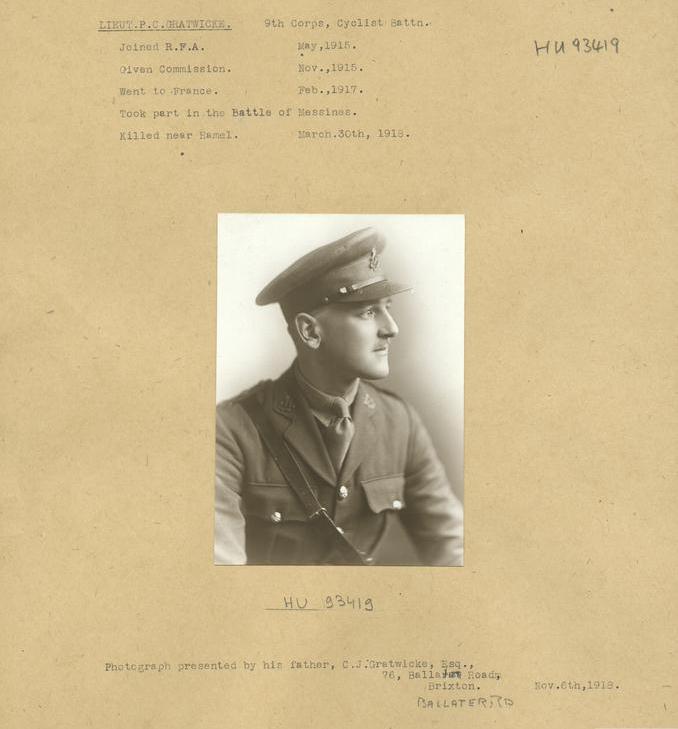
Phillip Charles Gratwicke
Lieutenant: Phillip Charles GRANTWICKE. 9th Corps, Cyclist Battalion. Killed in Action 30th March 1918.
The 12th Lancers proceeded the Battalion and reached the wood East of BOIS DE HANGARD at about 4;15 p.m.(This wood was in future be referred as LANCERS WOOD) My Adjutant, Scout Officer and Cavalry Liaison Officer went ahead with the Cavalry and reconnoitre the position. On our way to LANCER WOOD we passed several bodies of troops particularly had recklessly entrenched in queer places and large parties of stragglers. On reaching the wood we found the whole front line garrison East of LANCER WOOD withdrawing although there was no hostile fire of any kind and no signs of attack. I met two Brigadiers and a Battalion Commander in the wood and informed them what was happening at once. This they promised to do. The Cavalry Commander also helped in this matter by sending a Squadron dismounted to re-establish the line. The infantry went forward with the cavalry but in a reluctant manner. During the whole time we sore forward men constantly leaving the line. The seemed to be no effort to check this straggling.
It was a proud privilege to be allowed to work with such a fine Regiment as the 12th Lancers. Their approach march instilled in the mementos confidence and enthusiasm and I am glad to say greatly counteracted the effect of so much straggling. They lost no time in effectively clearing LANCERS WOOD and get there just in time as the enemy had obtained a footing on the southern and South Eastern edges. The Lancers protected the edges and allowed us to move forward to the attack. On seeing the cavalry there the enemy shelled LANCER WOOD very heavily, chiefly with 5.0s. paying particular attention to our fringes. Fairly heavy casualties to horses were inflicted there, the horses were soon led from the wood to a position West of the VILLER-BRETONNEUX - AUBERCOURT Road. The discipline during the heavy shelling was a subject lesson. During the attack the cavalry protected both our flanks, the left with two Machine Guns. They withdrew at about 7.00 p.m.
All ranks were eager to give every possible help to us, throughout there was whole hearted cooperation. The experience gained in this our first operation with cavalry was invaluable. One was able too judge of the splendid work they are doing for the Army at this present time and they cannot be too highly praised. The 33rd Battalion moved forward from the position of assembly at 3:00 p.m. The formation adapted by Companies was as follows; One Platoon in extended order, followed by two Platoons in line in Artillery formation; the fourth Platoon in reserve also in Artillery formation.
"B" Company moved along the Northern edge of LANCER WOOD and widened its front on clearing the wood. "A" Company moved throughout the wood. Owing to enemy shelling while moving through, the whole company was extended into three lines and resumed normal formation on clearing the wood. No casualties were sustained in the wood. "B" Company worked in single file along the brindle track near the Southern edge of the wood and formed up under cover of the terraced bank on the South East edge. Three casualties were sustained on entering the wood. "C" Company formed up on the sunken road in U.18.a. and not where was first ordered, owing to the hostile shelling.
The movement forward was splendidly carried out. On the right slight opposition was encounter bur easily disposed of. no real opposition was not until we were about 200 yards clear of the wood when all three Companies came very heavy machine gun and rifle fire. They deployed at once and moved forward without flinching. All ranks displayed the greatest determination and eagerness to get to the Bosch with the bayonet, this eagerness was to some extent responsible for the heavy casualties as the principle of advancing under covering fire was not sufficiently observed. On the Left most progress was made in spite of heavy losses, and the enemy hurriedly retired but on discovering later in strength he reformed.
30th March 1918
The enemy was well entrenched and in strong force as we had no artillery support his fire was consequently extremely heavy and unfortunately very accurate. Owing to such strong opposition we were not able to reach our objectives. The attached map shows approximately the line we established. The line is well sited and is a very good defensive position. With determined troops the enemy could easily be held, and any advance he attempted would be very expensive. Owing to casualties and to the wide front the Reserve Company to reinforce the right flank. This Company made good the gap between the right and centre Companies. At the same time I requested the 34th Battalion which was in support in U.18.a. and U.12.c. West of the VILLERS-BRETONNEUX - AUBERCOURT Road, to send a Company to reinforce the left flank. I instructed Company Commander Captain: Telford Graham GILDER. to reconnoitre the position first and then move forward at 6.00 p.m. This Company advanced in two lines of two Platoons each and took the newly-made enemy trenches about 250 yards East of the line then held by us, capturing two light machine guns one of which was damaged, and four prisoner's belonging to 91st Oldenburg Regiment.
Wilhelm CONZE; Company-Leader in the 91st Infantry-Regiment (03 Apr 1917-14 Oct 1917) Wounded, in Reserve Hospital in Gotha (23 Mar 1918-22 May 1918) Transferred to the Replacement-Battalion of the 91st Infantry-Regiment (22 May 1918-01 Jul 1918) Company-Leader in the 91st Infantry-Regiment (01 Jul 1918-30 Sep 1918) In French Captivity (30 Sep 1918-14 Feb 1920) Released from Captivity and back with the Processing-Office of the 91st Infantry-Regiment (14 Feb 1920-29 Mar 1920)
Captain: Telford Graham GILDER. withdrew and made good the gap between the left and center Company's. At 10:00 p.m. I requested the C.O. 34th Battalion to send two company's forward, one to the sunken road in U.18.a the other to a position 300 yards North East of LANCER WOOD. At 11:00 p.m. the enemy attempted a local counter attack against my left company but was repelled. Heavy rain fell from early in the afternoon till late at night. Walking over the ploughed fields under such conditions affected the Lewis guns and rifles. Every man was drenched to the skin and very cold, but this did not dampen his ardour. All maps were soon rendered useless and the writing of messages was extremely difficult. Our flanks were somewhat in the air, on our left the Warwicks were about 600 yard behind. The 66th Division were on our right, but touch with them was not obtained.
In order to secure my right flank the right Support company, of the 34th Battalion supplied a Platoon for patrolling and also to establish a post South of LANCER WOOD on the VILLERS-BRETONNEUX - AUBERCOURT Road. Our front was well protected by Vickers and Lewis Guns. We had five Vickers guns from the 9th Australian Machine Gun Company - two covered either flank and one the center, and we had 25 Lewis guns. We were relieved by the 10th ESSEX and the ROYAL WEST SURREY Regiment of the 18th Division this morning; the relief Battalion Headquarters were established at V.7.d.30.95. The Pre-arranged position was untannable.
Lieutenant Colonel: Leslie James MORSHEAD.
Commanding 33rd Battalion A.I.F.
Telford was detached to serve with the 129th American Regiment on the 20th of July 1918 and re-joined the 34th on the 27 of July.
25th October 1918.
Evidence
Re No 7708 Pte Blasser K.
This man occupied the same dug-out as myself in the line. In 31.7.18 the dug-out was partly blown in by a shell. Private: 7708 Kurst BLASSER received injuries through part of the dug-out falling on him.
(Sgd) Private: 1780 Albert BURGE. 34th Battalion AIF.
34th Bn.
Here with Army Form3428 concerning accidental injuries of Private: 7708 Kurst BLASSER and Private: QUICK. I have made the necessary enquiries and am of the opinion that neither of them were to blame in there respective cases. I have filled in para 4 to this effect. Would you please obtain the C.O's signature and fill in date when signed to this para.
(Sgd) Captain: Telford Graham GILDER. O.C "A" Coy.
Returned to Australia on the 7th of February 1919.
Family Information
Telford was a single 21 year old Law Student from Pymble, N.S.W upon enlistment. His parents William and Ida Gilder were married in 1888 at Sydney, N.S.W. Marriage Cert:8/1888 and had 5 children. William Roy Gilder born 1888 at Paddington, N.S.W. Birth Cert:10463/1888 and died in 1889 at Paddington, N.S.W. Death Cert:4911/1889. Ida C Gilder born 1890 at Paddington, N.S.W. Birth Cert:27595/1890. Telford Graham Gilder born 1894 at Paddington, N.S.W. Birth Cert:25998/1894. Kathleen J Gilder born 1899 at St-Leonards, N.S.W. Birth Cert:25033/1899 and died in 1899 at Manly, N.S.W. Death Cert: 13937/1899. Roy Adamson Gilder born 1907 at Chatswood, N.S.W. Birth Cert:12417/1907 and died in 1969 at Penrith, N.S.W. Death Cert:16616/1969.
Telford is recorded as a Bachelor of Law in 1921.
Military Records

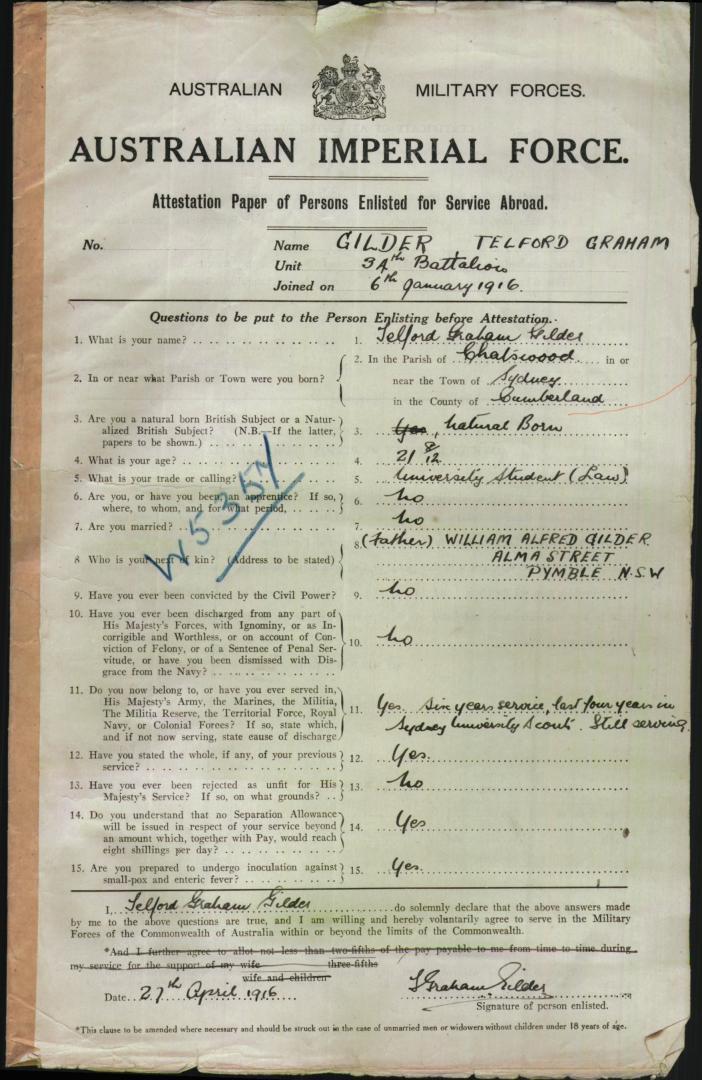
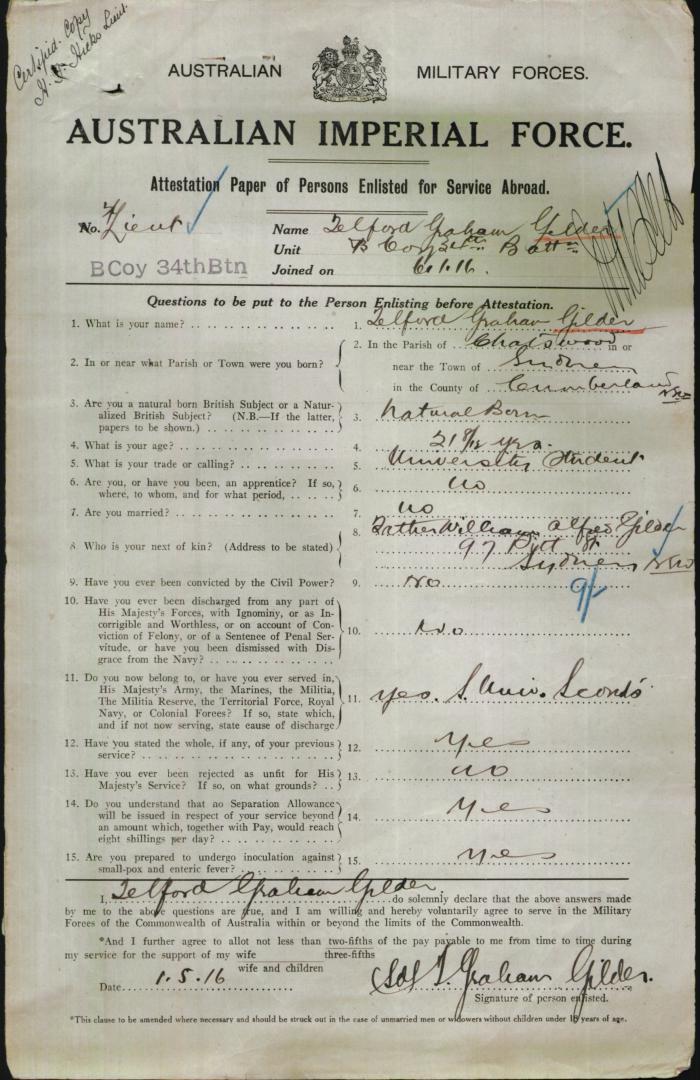
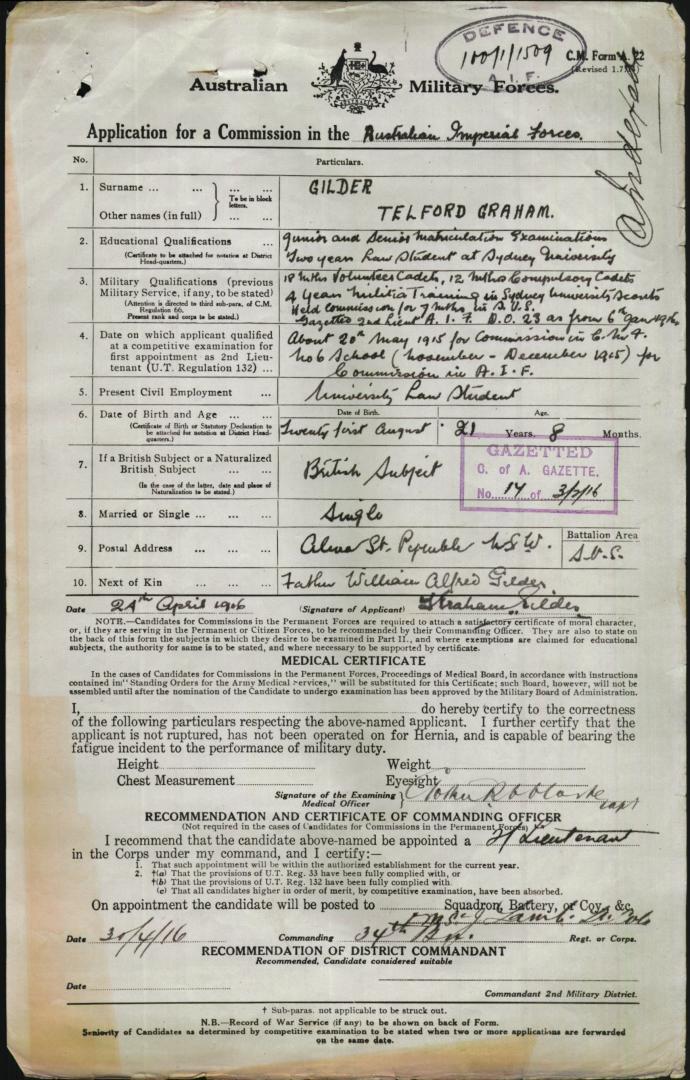


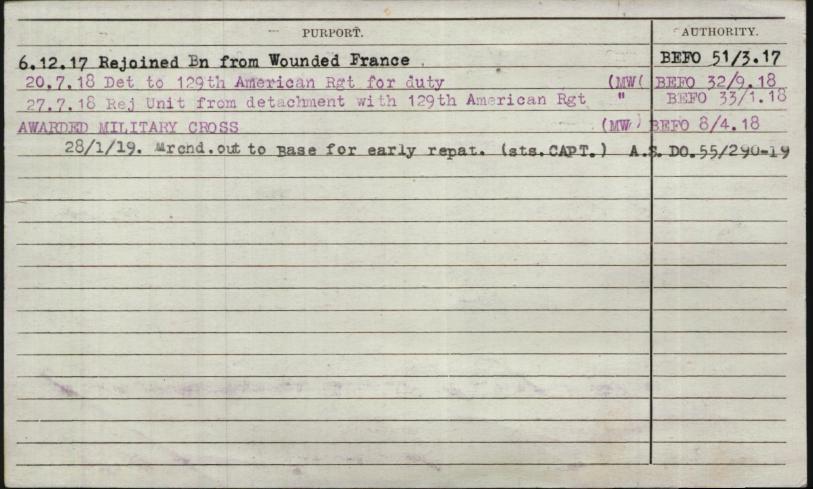
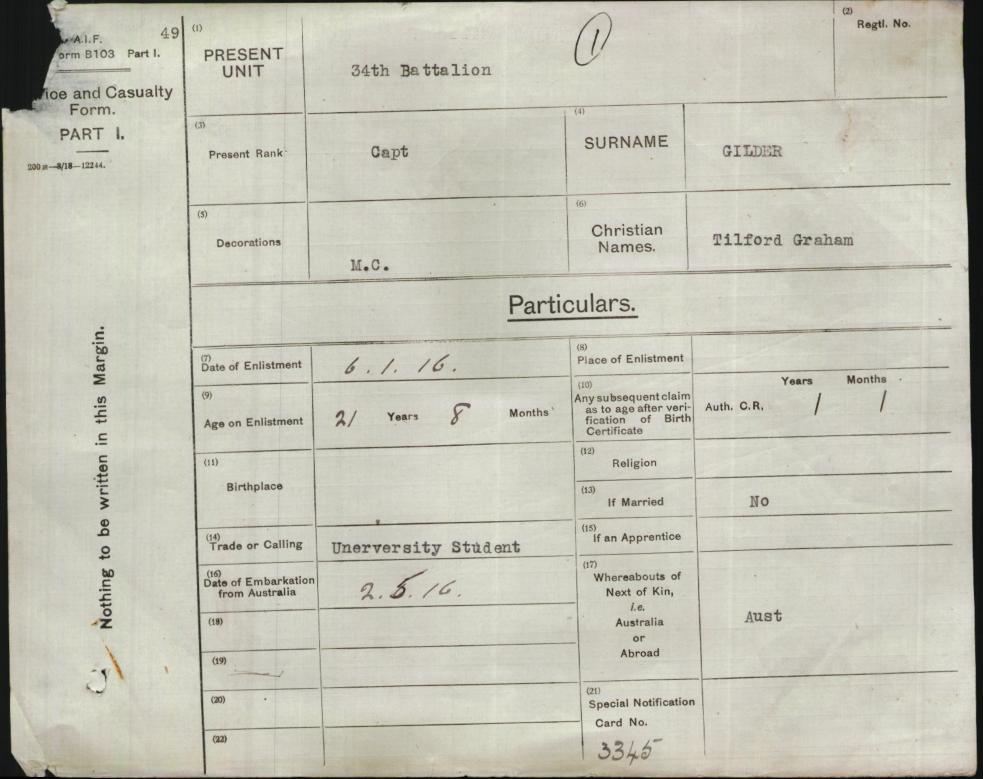


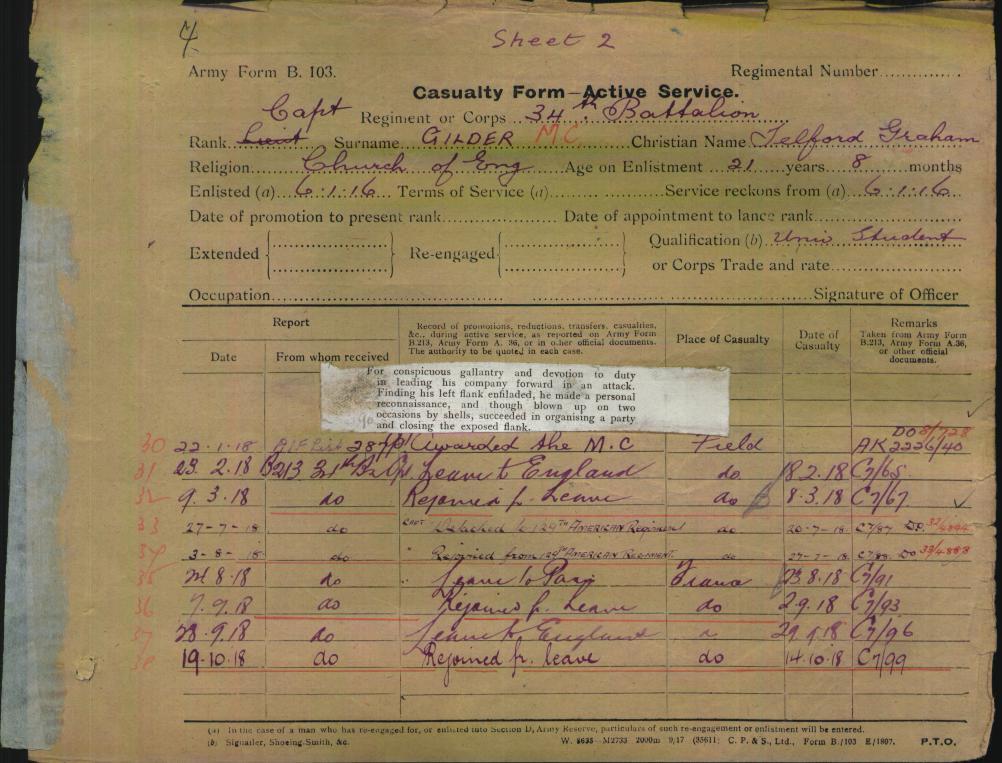
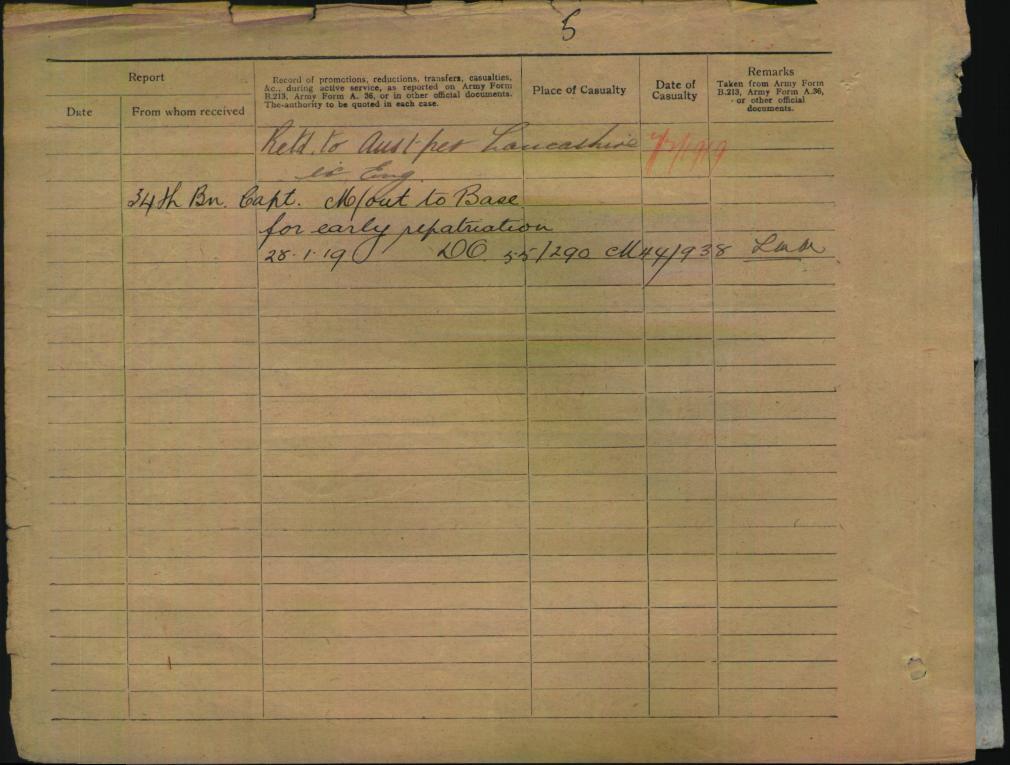

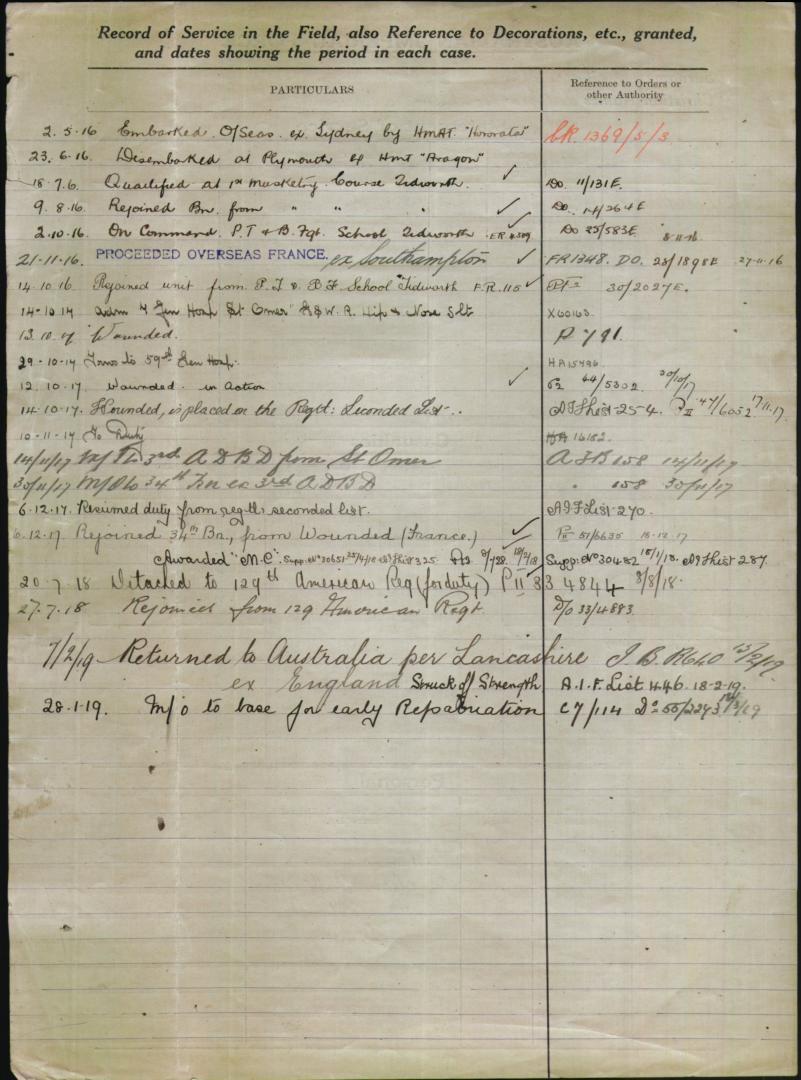


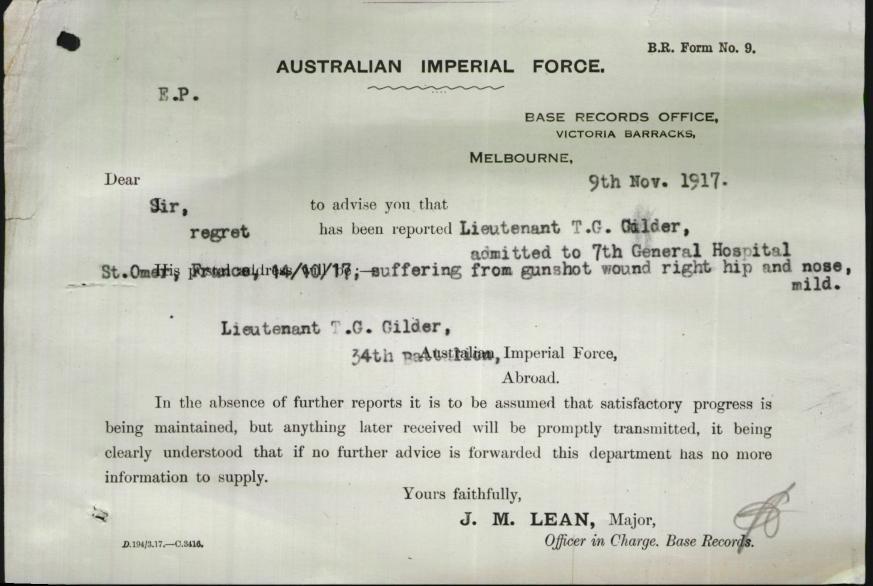
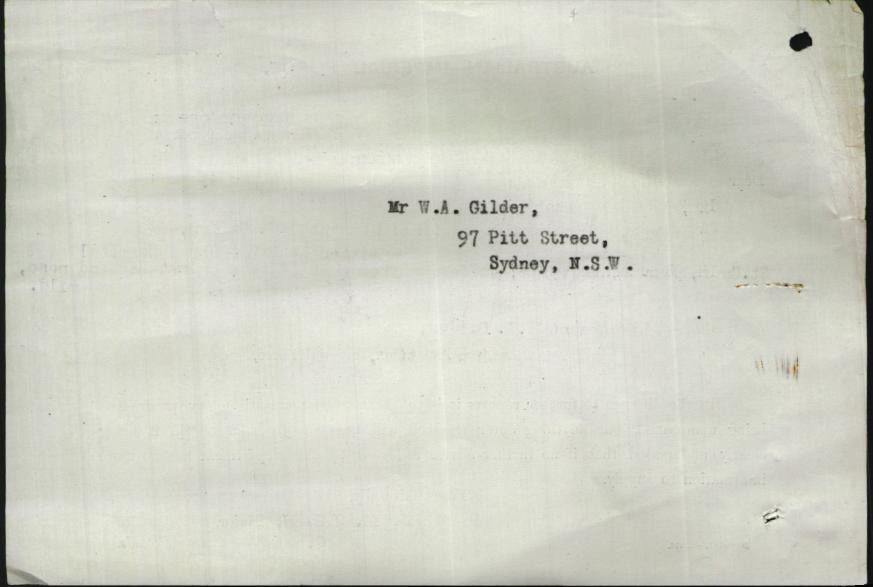
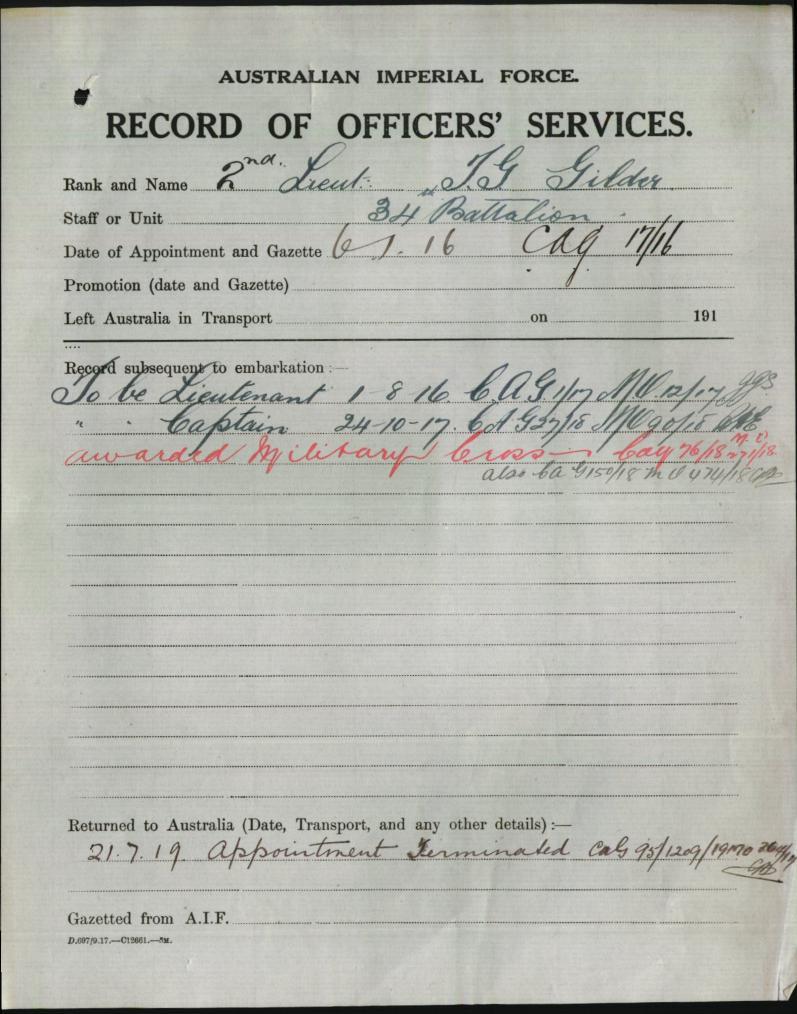

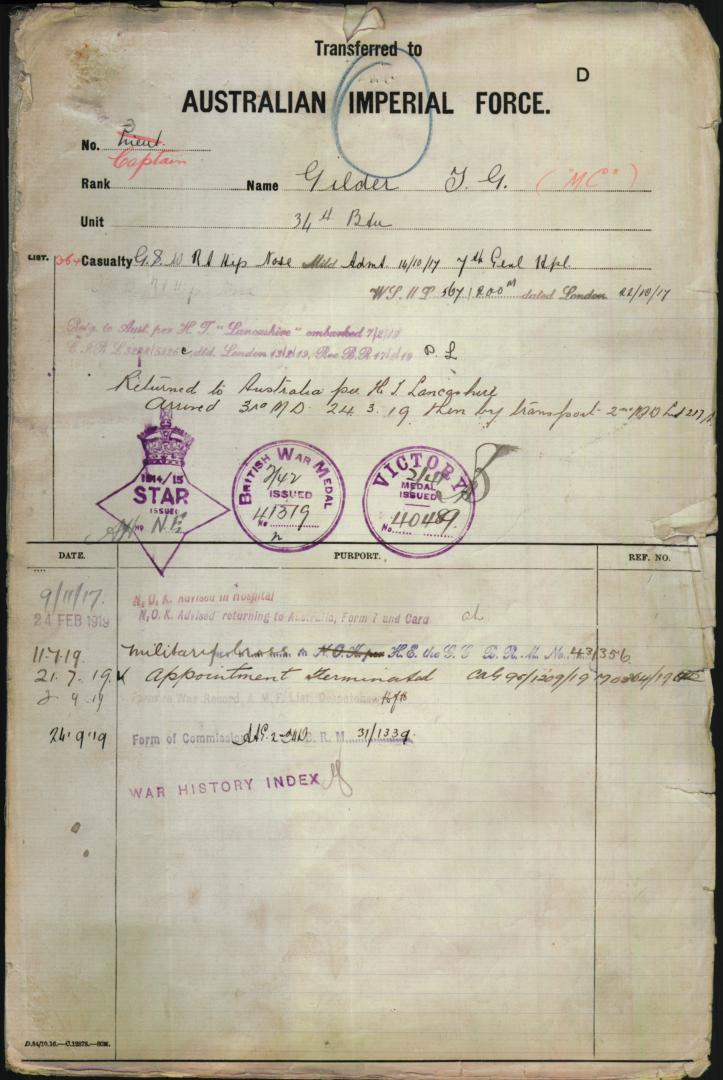
© Commonwealth of Australia (National Archives of Australia)
Under Construction; 11/08/2006-25/06/2017
